Form 6-K GoldMining Inc. For: Sep 30
U.S. SECURITIES AND EXCHANGE COMMISSION
Washington D.C. 20549
FORM 6-K
REPORT OF FOREIGN PRIVATE ISSUER PURSUANT TO RULE 13a-16 OR 15d-16 UNDER THE SECURITIES EXCHANGE ACT OF 1934
For the month of September, 2021.
Commission File Number: 001-39566
GoldMining Inc.
(Translation of registrant's name into English)
Suite 1830, 1030 West Georgia Street, Vancouver, British Columbia, Canada
(Address of principal executive office)
Indicate by check mark whether the registrant files or will file annual reports under cover of Form 20-F or Form
40-F.
|
☐ Form 20-F |
☒ Form 40-F |
Indicate by check mark if the registrant is submitting the Form 6-K in paper as permitted by Regulation S-T Rule 101(b)(1): ☐
Note: Regulation S-T Rule 101(b)(1) only permits the submission in paper of a Form 6-K if submitted solely to provide an attached annual report to security holders.
Indicate by check mark if the registrant is submitting the Form 6-K in paper as permitted by Regulation S-T Rule 101(b)(7): ☐
Note: Regulation S-T Rule 101(b)(7) only permits the submission in paper of a Form 6-K if submitted to furnish a report or other document that the registrant foreign private issuer must furnish and make public under the laws of the jurisdiction in which the registrant is incorporated, domiciled or legally organized (the registrant's "home country"), or under the rules of the home country exchange on which the registrant's securities are traded, as long as the report or other document is not a press release, is not required to be and has not been distributed to the registrant's security holders, and, if discussing a material event, has already been the subject of a Form 6-K submission or other Commission filing on EDGAR.
EXHIBIT INDEX
|
Exhibit Number |
Description |
|
99.1 |
|
|
99.2 |
|
|
99.3 |
SIGNATURES
Pursuant to the requirements of the Securities Exchange Act of 1934, the registrant has duly caused this report to be signed on its behalf by the undersigned, thereunto duly authorized.
GOLDMINING INC.
By: /s/ Pat Obara
Pat Obara
Chief Financial Officer
Date: September 10, 2021
Exhibit 99.1
|
Metal Mining Consultants, Inc |
Phone: Fax: |
(720) 348 - 1646 (303) 790 - 1872 |
| Highlands Ranch, Co 80129 |
www.metalminingconsultants.com |
|
|
NI 43-101 |
||
|
Technical Report |
||
|
GoldMining Inc |
||
|
La Mina Project |
||
|
Antioquia, Republic of Colombia |
||
|
Effective Date July 6, 2021 Published Date September 8, 2021 |
||
|
Prepared By |
||
|
Scott E. Wilson, C.P.G. Mauricio Castañeda, MAIG |
||
| GoldMining Inc. NI 43-101 Report – La Mina Project |
Page I |
DATE AND SIGNATURE PAGE
Technical Report, La Mina Project, Antioquia, Republic of Colombia, with an effective date of July 6, 2021.
September 8, 2021
|
[Signed and Sealed] |
Scott E. Wilson |
|
Scott E. Wilson, C.P.G. |
|
|
Geologist |
|
|
[Signed and Sealed] |
Mauricio Castañeda |
|
Mauricio Castañeda, MAIG, QP |
|
|
Geologist |
|
| Metal Mining Consultants Inc. Effective Date July 6, 2021 |
 |
| GoldMining Inc. NI 43-101 Report – La Mina Project |
Page II |
AUTHOR’S CERTIFICATE
I, Scott E. Wilson, CPG, SME-RM, of Highlands Ranch, Colorado, as an author of the technical report entitled “Technical Report, La Mina Project, Antioquia, Republic of Colombia” (the “Technical Report”) with an effective date of July 6, 2021 prepared for GoldMining Inc. (the “Issuer”) do hereby certify:
|
1. |
I am currently employed as President by Metal Mining Consultants Inc., Highlands Ranch, Colorado 80129. |
|
2. |
I graduated with a Bachelor of Arts degree in Geology from the California State University, Sacramento in 1989. |
|
3. |
I am a Certified Professional Geologist and member of the American Institute of Professional Geologists (CPG #10965) and a Registered Member (#4025107) of the Society for Mining, Metallurgy and Exploration, Inc. |
|
4. |
I have been employed as both a geologist and a mining engineer continuously for a total of 32 years. My experience included resource estimation, mine planning, geological modeling, geostatistical evaluations, project development, and authorship of numerous technical reports and preliminary economic assessments of various projects throughout North America, South America and Europe. I have employed and mentored mining engineers and geologists continuously since 2003. |
|
5. |
I have read the definition of “Qualified Person” set out in National Instrument 43-101 (“NI 43-101) and certify that by reason of my education, affiliation with a professional association (as defined in NI 43-101) and past relevant work experience, I fulfill the requirements to be a “Qualified Person” for the purposes of NI 43-101. |
|
6. |
I visited the Project and surrounding area August 18 and 19, 2012. |
|
7. |
I am responsible for all parts of Section 1, Section 2.0 through 2.7, Section 2.7.2, all parts of Sections 3 through 11, Sections 12.0 and 12.1 and all parts of Sections 13 through 26 of the Technical Report. |
|
8. |
I am independent of the Issuer as independence is described in Section 1.5 of NI 43-101. |
|
9. |
Prior to being retained by the Issuer, I have not had prior involvement with the property that is the subject of the Technical Report. |
|
10. |
I have read NI 43-101 and Form 43-101F1, and this Technical Report was prepared in compliance with NI 43-101. |
|
11. |
As of the effective date of this Technical Report, to the best of my knowledge, information and belief, the portions of the Technical Report for which I am responsible contain all scientific and technical information that is required to be disclosed to make the portions of the Technical Report for which I am responsible not misleading. |
Dated: September 8, 2021
|
[“Signed and Sealed”] |
|
Scott E. Wilson, C.P.G. |
| Metal Mining Consultants Inc. Effective Date July 6, 2021 |
 |
| GoldMining Inc. NI 43-101 Report – La Mina Project |
Page III |
AUTHOR’S CERTIFICATE
I, Mauricio Castañeda, MAIG, of Medellin, Colombia, as an author of the technical report entitled “Technical Report, La Mina Project, Antioquia, Republic of Colombia” (the “Technical Report”) with an effective date of July 6, 2021 prepared for GoldMining Inc. (the “Issuer”) do hereby certify:
|
1. |
I am an independent consulting mineral exploration specialist doing business as Mauricio Castañeda at the address of Cra. 48 98A Sur 250, Medellín, Colombia. |
|
2. |
I graduated with a Bachelor of Science and Engineering in Geological Engineering from Universidad EIA (Former Escuela de Ingeniería de Antioquia) in Medellín, Colombia. |
|
3. |
I am a Member of the Australian Institute of Geoscientists (AIG Member ID 5443) and Member of Canadian Institute of Mining, Metallurgy and Petroleum (CIM Member No. 706703). I have worked as a geologist continuously for approximately 22 years since my graduation from university. |
|
4. |
I have been involved in mining, mineral exploration and mineral resource evaluation practice for approximately 22 years. My relevant experience for the purpose of the Technical Report is acting as an independent mineral exploration consultant specializing in the precious and base metal exploration, managing and leading mineral exploration in early and advanced projects, managing and leading mining operations, and evaluating base and precious metal projects, scoping, prefeasibility and feasibility studies. |
|
5. |
I have read the definition of “Qualified Person” as set out in the Canadian National Instrument 43-101 Standards of Disclosure for Mineral Properties (“NI 43-101”) and certify that by reason of my education, affiliation with a professional association (as defined in NI 43-101), and past relevant work experience, I fulfill the requirements to be a “Qualified Person” for the purposes of NI 43-101. |
|
6. |
I visited the Project on June 12, 2021. |
|
7. |
I am responsible for all parts of Section 1, Section 2.7.1, all parts of Sections 4 and 5, and Section 12.2 of the Technical Report. |
|
8. |
I am independent of the Issuer as independence is described in Section 1.5 of NI 43-101. |
|
9. |
Prior to being retained by the Issuer, I have not had prior involvement with the property that is the subject of the Technical Report. |
|
10. |
I have read NI 43-101 and Form 43-101F1, and this Technical Report was prepared in compliance with NI 43-101. |
|
11. |
As of the effective date of this Technical Report, to the best of my knowledge, information and belief, the portions of the Technical Report for which I am responsible contain all scientific and technical information that is required to be disclosed to make the portions of the Technical Report for which I am responsible not misleading. |
Dated September 8, 2021
|
[“Signed and Sealed”] |
|
Mauricio Castañeda, MAIG. |
| Metal Mining Consultants Inc. Effective Date July 6, 2021 |
 |
| GoldMining Inc. NI 43-101 Report – La Mina Project |
Page IV |
Table of Contents
| 1 | Summary | 14 | |||
| 2 | Introduction | 15 | |||
| 2.1 | Mineralization | 15 | |||
| 2.2 | La Mina Mineral Resources | 16 | |||
| 2.3 | Metallurg | 18 | |||
| 2.4 | Infrastructure | 18 | |||
| 2.4.1 | Transportation | 18 | |||
| 2.4.2 | Power | 19 | |||
| 2.4.3 | Labor | 19 | |||
| 2.4.4 | Water | 19 | |||
| 2.4.5 | Security | 19 | |||
| 2.5 | Environmental and Social | 20 | |||
| 2.6 | Recommendations | 20 | |||
| 2.7 | Purpose of Technical Report | 21 | |||
| 2.7.1 | Personal Inspection | 21 | |||
| 2.7.2 | Terms of Reference | 21 | |||
| 2.7.2.1 | Units of Measure - Abbreviations | 22 | |||
| 2.7.2.2 | Acronyms and Symbols | 23 | |||
| 3 | Reliance on Other Experts | 24 | |||
| 4 | Property Description and Location | 25 | |||
| 4.1 | Area and Location | 25 | |||
| 4.2 | Mineral Tenure | 27 | |||
| 4.3 | SurFace Rights Agreements | 29 | |||
| 4.4 | General | 29 | |||
| 5 | Accessibility, Climate, Local Resources, Infrastructure and Physiography | 30 | |||
| 5.1 | Access and Infrastructure | 30 | |||
| 5.2 | Physiography | 30 | |||
| 5.3 | Climate | 30 | |||
| 6 | History | 31 | |||
| 6.1 | Exploration Prior to 2002 | 31 | |||
| 6.2 | Exploration 2002-2008 | 31 | |||
| 6.3 | AGA Drilling | 33 | |||
| 7 | Geological Setting and Mineralization | 34 | |||
| 7.1 | Regional Geology | 34 | |||
| Metal Mining Consultants Inc. Effective Date July 6, 2021 |
 |
| GoldMining Inc. NI 43-101 Report – La Mina Project |
Page V |
| 7.2 | Property Geology | 38 | |||
| 7.3 | Intrusive Rocks | 39 | |||
| 7.3.1 | X2 Porphyry (X2) | 40 | |||
| 7.3.2 | X1 Porphyry (X1) | 41 | |||
| 7.3.3 | X3 Porphyry (x3) | 41 | |||
| 7.3.4 | La Cantera Porphyry (C1) | 41 | |||
| 7.3.5 | El Limon Porphyry (L1) | 42 | |||
| 7.3.6 | El Limon Porphyry (L2) | 42 | |||
| 7.3.7 | El limon Porhyry (L3) | 43 | |||
| 7.3.8 | G1 Porphyry (G1) | 43 | |||
| 7.3.9 | G2 Porphyry (G2) | 43 | |||
| 7.3.10 | G4 Porphyry (G4) | 44 | |||
| 7.3.11 | Intrusive Breccias | 44 | |||
| 7.4 | Volcanic Rocks | 45 | |||
| 7.5 | Structure | 45 | |||
| 7.6 | La Cantera Prospect Geology | 46 | |||
| 7.7 | La Cantera Prospect Alteration | 48 | |||
| 7.8 | La Cantera Prospect Mineralization | 51 | |||
| 7.9 | Middle Zone Prospect Geology | 53 | |||
| 7.10 | Middle Zone Prospect Alteration | 54 | |||
| 7.11 | Middle Zone Propsect Mineralization | 55 | |||
| 7.12 | La Garrucha Prospect Geology | 57 | |||
| 7.13 | La Garrucha Prospect Alteration | 60 | |||
| 7.14 | La Garrucha Propect Mineralization | 61 | |||
| 7.15 | El Limon Propsect Geology | 61 | |||
| 7.16 | El Limon Propsect Alteration | 62 | |||
| 7.17 | El Limon Prospect Mineralization | 62 | |||
| 8 | Deposit Types | 63 | |||
| 9 | Exploration | 64 | |||
| 10 | Drilling | 67 | |||
| 10.1 | La Cantera Drilling | 67 | |||
| 10.2 | Middle Zone Drilling | 71 | |||
| 10.3 | La Garrucha Drilling | 74 | |||
| 10.4 | El Limon Drilling | 75 | |||
| 10.5 | Trenching | 76 | |||
| 10.6 | Rock Sampling and Soil Geochemistry | 76 | |||
| 11 | Sample Preparation, Analyses, and Security | 77 | |||
| 11.1 | Standard, Blank, and Duplicate Samples | 78 | |||
| Metal Mining Consultants Inc. Effective Date July 6, 2021 |
 |
| GoldMining Inc. NI 43-101 Report – La Mina Project |
Page VI |
| 11.1.1 | Standard Results | 79 | |||
| 11.1.2 | Blank results | 92 | |||
| 11.1.3 | Duplicate Types and results | 97 | |||
| 11.2 | Independent Check Assay Program | 100 | |||
| 11.3 | Summary of QA/QC Program | 103 | |||
| 12 | Data Verification | 106 | |||
| 12.1 | Assay Certificate and Drill Hole Database Validation | 106 | |||
| 12.2 | Current Inspection and DATA VALIDATION | 107 | |||
| 13 | Mineral Processing and Metallurgical Testing | 124 | |||
| 13.1 | Summary | 124 | |||
| 13.2 | Metallurgical Introduction | 124 | |||
| 13.2.1 | Metallurgical Test Work | 125 | |||
| 13.2.2 | Sample Preparation and Characterization | 125 | |||
| 13.3 | In-Place Bulk Densities | 126 | |||
| 13.4 | Ball Mill Work Indices | 127 | |||
| 13.5 | Grind Studies | 127 | |||
| 13.6 | Gravity Tests | 128 | |||
| 13.7 | Whole Ore Cyanidation Leach tests | 130 | |||
| 13.8 | Flotation Tests | 131 | |||
| 13.8.1 | Rougher Flotation | 131 | |||
| 13.9 | 2016 met tests | 135 | |||
| 13.10 | Metallurgical Conclusions | 136 | |||
| 13.11 | Recommendations | 136 | |||
| 14 | Mineral Resource Estimate | 137 | |||
| 14.1 | Resource Estimation Procedures | 137 | |||
| 14.2 | La Cantera Resources Estimate | 137 | |||
| 14.2.1 | Database for Geologic Model | 137 | |||
| 14.2.2 | Geologic Model | 143 | |||
| 14.2.3 | Topography | 149 | |||
| 14.2.4 | Block Model | 149 | |||
| 14.2.5 | Grade Estimation | 152 | |||
| 14.2.6 | Block Model Validation | 156 | |||
| 14.2.7 | Density | 156 | |||
| 14.2.8 | Inferred and Indicated Mineral Resources | 156 | |||
| 14.3 | Middle Zone Resource Estimation | 157 | |||
| 14.3.1 | Database for Geologic Model | 157 | |||
| Metal Mining Consultants Inc. Effective Date July 6, 2021 |
 |
| GoldMining Inc. NI 43-101 Report – La Mina Project |
Page VII |
| 14.3.2 | Geologic Model | 162 | |||
| 14.3.3 | Topography | 169 | |||
| 14.3.4 | Block Model | 169 | |||
| 14.3.5 | Grade Estimation | 171 | |||
| 14.3.6 | Density | 174 | |||
| 14.3.7 | Pit Constraining Optimization Criteria including Metals Pricing Used | 174 | |||
| 14.3.8 | Inferred and Indicated Mineral resources | 175 | |||
| 14.4 | La Mina Resources | 176 | |||
| 14.4.1 | Block Model Validation | 177 | |||
| 14.4.1.1 | Visual Validation | 177 | |||
| 15 | Mineral Reserve Estimates | 178 | |||
| 16 | Mining Methods | 179 | |||
| 17 | Recovery Methods | 180 | |||
| 18 | Project Inrastructure | 181 | |||
| 19 | Market Studies and Contracts | 182 | |||
| 20 | Environmental Studies, Permitting and Social or Community | 183 | |||
| 21 | Capital and Operating Costs | 184 | |||
| 22 | Economic Analysis | 185 | |||
| 23 | Adjacent Properties | 186 | |||
| 24 | Other Relevant Data and Information | 187 | |||
| 25 | Interpretation and Conclusions | 188 | |||
| 26 | Recommendations | 189 | |||
| 27 | References | 190 | |||
| Metal Mining Consultants Inc. Effective Date July 6, 2021 |
 |
| GoldMining Inc. NI 43-101 Report – La Mina Project |
Page VIII |
LIST OF TABLES
| Table 2‑1 | La Mina Indicated Resources for July 2021 | 17 |
| Table 2‑2 | La Mina Inferred Resources for July 2021 | 17 |
| Table 4‑1 | La Mina Property Ownership | 28 |
| Table 6‑1 | AGA Drill Results | 32 |
| Table 7‑1 | Lithological Descriptions | 40 |
| Table 9‑1 | Drilling Completed by Bellhaven at La Mina | 64 |
| Table 10‑1 | La Cantera Drilling - All Holes | 70 |
| Table 10‑2 | La Cantera Deposit Significant Intercepts Through February 2012 | 71 |
| Table 10‑3 | Middle Zone Collar Surveys | 72 |
| Table 10‑4 | Middle Zone deposit Drilling Subsequent to the 2012 Resource | 73 |
| Table 10‑5 | La Garrucha Drill Holes Location and Depth | 74 |
| Table 10‑6 | La Garrucha Significant Drill Core Intercepts | 74 |
| Table 10‑7 | El Limon Drill Holes and Locations | 75 |
| Table 10‑8 | El Limon Significant Drill Intercepts | 76 |
| Table 12‑1 | Example of Database Validation Table | 107 |
| Table 12‑2 | Original samples and assay results from the intervals selected for resampling by the QP (initial sampling as reported from the ALS Chemex lab). | 118 |
| Table 12‑3 | Check samples collected by the QP to be compared to the initial ½ core samples (results as determined by Bureau Veritas.) | 118 |
| Table 13‑1 | Description of Composite Samples | 125 |
| Table 13‑2 | Head Analysis of Bellhaven Samples | 125 |
| Table 13‑3 | Proportion of Different Forms of Copper in the Bellhaven Samples | 125 |
| Table 13‑4 | ICP Analyses of Composite Samples | 126 |
| Table 13‑5 | In Place Bulk Densities for the Selected Core Samples | 127 |
| Table 13‑6 | Bond's Ball Mill Work Index @ 100 Mesh | 127 |
| Table 13‑7 | Gravity Test Results for Composite No. 1 | 128 |
| Table 13‑8 | Gravity Test Results for Composite No.2 | 129 |
| Table 13‑9 | Gravity Test Results for Composite No. 3 | 129 |
| Table 13‑10 | Gravity Test Results for Composite No. 4 | 130 |
| Table 13‑11 | Cyanidation Leach Test Results (P80 = 200 Mesh) | 131 |
| Metal Mining Consultants Inc. Effective Date July 6, 2021 |
 |
| GoldMining Inc. NI 43-101 Report – La Mina Project |
Page IX |
| Table 13‑12 | Carbon-in-Leach (CIL) Test Results | 131 |
| Table 13‑13 | Flotation Process Test Parameter | 132 |
| Table 13‑14 | Flotation Test Results for Composite No. 1 | 133 |
| Table 13‑15 | Flotation Test Results for Composite No. 2 | 134 |
| Table 13‑16 | Flotation Test Results for Composite No. 4 | 135 |
| Table 14‑1 | La Cantera Block Model Parameters | 150 |
| Table 14‑2 | Parameters for Ordinary Kriging Based on Nested Variography | 152 |
| Table 14‑3 | Pit Constrained Resources for La Cantera | 157 |
| Table 14‑4 | Total Resources with 0.25 g/t Cut-off for La Cantera | 157 |
| Table 14‑5 | Total Project Drill Holes | 157 |
| Table 14‑6 | Middle Zone Block Parameters | 169 |
| Table 14‑7 | Middle Zone Capping Criteria | 171 |
| Table 14‑8 | BMO Analysis of Metals Price Used for Determining Resources | 174 |
| Table 14‑9 | Pit Constrained Resources for Middle Zone | 175 |
| Table 14‑10 | Total Resources with 0.25g/t Cutoff for Middle Zone | 176 |
| Table 14‑11 | In-Pit Resources for La Mina Project (La Cantera and Middle Zone) | 176 |
| Table 14‑12 | Total Indicated and Inferred Resources for La Mina Project (Cutoff Grade 0.25g/t Au) | 176 |
| Table 26‑1 | Proposed Phase 1 Work Program to advance La Mina | 189 |
| Metal Mining Consultants Inc. Effective Date July 6, 2021 |
 |
| GoldMining Inc. NI 43-101 Report – La Mina Project |
Page X |
LIST OF FIGURES
| Figure 4‑1 | La Mina Property, Colombia | 26 |
| Figure 4‑2 | La Mina Project Location and Access Map | 27 |
| Figure 4‑3 | Claim Map Showing Location of La Mina Porphyry Bodies in Relation to Concession Boundaries | 28 |
| Figure 6‑1 | Portion of Aerial Magnetics, Avasca Joint Venture 2007 | 32 |
| Figure 7‑1 | Geomorphological Regions of Colombia Showing the Approximate Location of La Mina | 35 |
| Figure 7‑2 | Tectonic Map of Colombia | 37 |
| Figure 7‑3 | Generalized Geologic Map of the La Mina Project Area | 38 |
| Figure 7‑4 | Surface Geology of the La Cantera Prospect Showing the Location of the Drill Holes | 47 |
| Figure 7‑5 | North-South Cross Section (Looking West) of Geology through the La Cantera Deposit | 48 |
| Figure 7‑6 | LMDDH-008-288m. C1 Porphyry with Pervasive Biotite-Magnetite Alteration of the Matrix and Actinolite Alteration of Primary Magmatic Mafic Phenocrysts | 49 |
| Figure 7‑7 | LMDDH-016 392.5m. C1 Breccia with Potassic Alteration (Magnetite-k-Feldspar +/- Actinolite) Cut by Sheeted Magnetite Veins, Quartz Magnetite Stockwork Veins and Late Pyrite-filled Fractures | 50 |
| Figure 7‑8 | Drill Hole Intercepts with >0.5g/t Au in the La Cantera Prospect | 52 |
| Figure 7‑9 | Surface Geology and Drill Holes Used in Resource Estimate at Middle Zone Prospect | 54 |
| Figure 7‑10 | NE-SW Cross Section through Middle Zone, Showing Significant Intercepts. Labels A and B Refer to the Two Distinct Mineralization Types | 56 |
| Figure 7‑11 | Surface Geology of Drill Holes at La Garrucha | 58 |
| Figure 7‑12 | NE-SW La Garrucha Cross Section | 59 |
| Figure 7‑13 | El Limon Prospect Geology | 62 |
| Figure 9‑1 | Exploration Targets at La Mina Project | 65 |
| Figure 9‑2 | Magnetic Susceptibility Model at 100 m Depth. The Area of the Ground Magnetic Survey is the Red Box in Figure 6.1 | 66 |
| Figure 10‑1 | La Mina Drill Collar Monuments | 69 |
| Figure 11‑1 | Reference Material CU156 Performance for Au | 79 |
| Figure 11‑2 | Reference Material CU157 Performance for Au | 80 |
| Figure 11‑3 | Reference Material CU158 Performance for Au | 80 |
| Figure 11‑4 | Reference Material CU159 Performance for Au | 81 |
| Metal Mining Consultants Inc. Effective Date July 6, 2021 |
 |
| GoldMining Inc. NI 43-101 Report – La Mina Project |
Page XI |
| Figure 11‑5 | Reference Material CU164 Performance for Au | 81 |
| Figure 11‑6 | Reference Material CU175 Performance for Au | 82 |
| Figure 11‑7 | Reference Material CU184 Performance for Au | 82 |
| Figure 11‑8 | Reference Material CM13 Performance for Au | 83 |
| Figure 11‑9 | Reference Material CM14 Performance for Au | 83 |
| Figure 11‑10 | Reference Material CGS27 Performance for Au | 84 |
| Figure 11‑11 | Reference Material PM434 Performance for Au | 84 |
| Figure 11‑12 | Reference Material PM436 Performance for Au | 85 |
| Figure 11‑13 | Reference Material PM438 Performance for Au | 85 |
| Figure 11‑14 | Reference Material PM446 Performance for Au | 86 |
| Figure 11‑15 | Reference Material PM447 Performance for Au | 86 |
| Figure 11‑16 | Reference Material CU156 Performance for Cu | 87 |
| Figure 11‑17 | Reference Material CU157 for Cu | 87 |
| Figure 11‑18 | Reference Material CU158 Performance for Cu | 88 |
| Figure 11‑19 | Reference Material CU159 Performance for Cu | 88 |
| Figure 11‑20 | Reference Material CU164 Performance for Cu | 89 |
| Figure 11‑21 | Reference Material CU175 Performance for Cu | 89 |
| Figure 11‑22 | Reference Material CU184 Performance for Cu | 90 |
| Figure 11‑23 | Reference Material CM13 Performance for Cu | 90 |
| Figure 11‑24 | Reference Material CM14 Performance for Cu | 91 |
| Figure 11‑25 | Reference Material CGS27 Performance for Cu | 91 |
| Figure 11‑26 | Reference Material - Blank BL110 Performance for Au | 92 |
| Figure 11‑27 | Reference Material - Blank BL111 Performance for Au | 92 |
| Figure 11‑28 | Reference Material - Blank BL112 Performance for Au | 93 |
| Figure 11‑29 | Reference Material - Blank BL113 Performance for Au | 93 |
| Figure 11‑30 | Reference Material - Blank BL115 Performance for Au | 94 |
| Figure 11‑31 | Reference Material - Blank BL110 Performance for Cu | 94 |
| Figure 11‑32 | Reference Material - Blank BL111 Performance for Cu | 95 |
| Figure 11‑33 | Reference Material - Blank BL112 Performance for Cu | 95 |
| Figure 11‑34 | Reference Material - Blank BL113 Performance for Cu | 96 |
| Metal Mining Consultants Inc. Effective Date July 6, 2021 |
 |
| GoldMining Inc. NI 43-101 Report – La Mina Project |
Page XII |
| Figure 11‑35 | Reference Material - Blank BL115 Performance for Cu | 96 |
| Figure 11‑36 | Au Analyses (FA AA) for Preparation Duplicate Samples | 97 |
| Figure 11‑37 | Au Analyses (FA AA) for Preparation Duplicate Samples | 98 |
| Figure 11‑38 | Au Analyses (FA AA) for Preparation Duplicate Samples | 98 |
| Figure 11‑39 | Cu Analyses (ICP-AES) for Preparation Duplicate Samples | 99 |
| Figure 11‑40 | Cu Analyses (ICP-AES) for Preparation Duplicate Samples | 99 |
| Figure 11‑41 | Cu Analyses (ICP-AES) for Preparation Duplicate Samples | 100 |
| Figure 11‑42 | Original vs Check Sample Comparison for Middle Zone - Au The Blue Dotted lines are +/- 10% from the Mean | 101 |
| Figure 11‑43 | Original vs Check Sample Comparison for Middle Zone - Cu The Blue Dotted Lines are +/- 10% from the Mean | 102 |
| Figure 11‑44 | Original Assays vs Rechecks - with Outliers Rejected | 103 |
| Figure 11‑45 | Changes in the Magnitude of Difference between Standards and Blanks for Copper Plotted against Date of Analysis | 105 |
| Figure 12‑1 | Gravel road from Fredonia town to La Mina Project. (source: Mauricio Castañeda, June 12, 2021) | 108 |
| Figure 12‑2 | Gate at the entrance of the facilities provides security to the drill cores, and other reliable information. (Source: Mauricio Castañeda, June 12, 2021) | 109 |
| Figure 12‑3 | Geology office and accommodation house. (Source: Mauricio Castañeda, June 12, 2021) | 109 |
| Figure 12‑4 | Electricity supply by regional grid interconnection. (Source: Mauricio Castañeda, June 12, 2021) | 110 |
| Figure 12‑5 | Warehouse drill-core storage. (Source: Mauricio Castañeda, June 12, 2021) | 111 |
| Figure 12‑6 | Pulp rejects storage. (Source: Mauricio Castañeda, June 12, 2021) | 112 |
| Figure 12‑7 | Core shed for core logging and sampling. (Source: Mauricio Castañeda, June 12, 2021) | 113 |
| Figure 12‑8 | Technician demonstrating core cutting procedures. (Source: Mauricio Castañeda, June 12, 2021) | 114 |
| Figure 12‑9 | Core logging facilities. (Source: Mauricio Castañeda, June 12, 2021) | 115 |
| Figure 12‑10 | Geology and model review by plan view and systematic sections – La Mina, Fredonia. (Source: Mauricio Castañeda, June 12, 2021) | 116 |
| Figure 12‑11 | Well organized core trays storage. (Source: Mauricio Castañeda, June 12, 2021) | 117 |
| Figure 12‑12: | Plan view & Section geology map with drill holes reviewed Middle Zone. (Source: Mauricio Castañeda, June 12, 2021) | 119 |
| Metal Mining Consultants Inc. Effective Date July 6, 2021 |
 |
| GoldMining Inc. NI 43-101 Report – La Mina Project |
Page XIII |
| Figure 14‑1 | Plan View of La Cantera Drilling - Not to Scale | 138 |
| Figure 14‑2 | Isometric View La Cantera Drilling - Not to Scale | 139 |
| Figure 14‑3 | Distribution of Lithology | 140 |
| Figure 14‑4 | Distribution of Major Lithologies at La Cantera | 140 |
| Figure 14‑5 | Incremental Histogram for La Cantera Gold Data | 141 |
| Figure 14‑6 | Incremental Histogram for La Cantera Silver Data | 142 |
| Figure 14‑7 | Incremental Histogram for La Cantera Copper Data | 143 |
| Figure 14‑8 | Bellhaven Geologic Interpretation Section LC419105 | 145 |
| Figure 14‑9 | Bellhaven Sections with Geologic Interpretation for La Cantera | 146 |
| Figure 14‑10 | Bench Section Profiles of C and X in Vulcan | 147 |
| Figure 14‑11 | Bench Section Profiles Including Volcanic Buffer | 148 |
| Figure 14‑12 | Wireframes of C, X and Volcanic Boundaries | 149 |
| Figure 14‑13 | Block Model Showing Lithology of La Cantera | 151 |
| Figure 14‑14 | La Cantera Ellipsoids | 153 |
| Figure 14‑15 | La Cantera Block Model Slice Showing Pit Constrained Au Estimated Grades | 154 |
| Figure 14‑16 | La Cantera Block Slice Showing Pit Constrained Cu Estimated Grades | 155 |
| Figure 14‑17 | Plan View of Middle Zone Drilling | 158 |
| Figure 14‑18 | Isometric View of Middle Zone Drilling | 159 |
| Figure 14‑19 | Distribution of Lithology - Middle Zone | 160 |
| Figure 14‑20 | Distribution of Major Lithologies - Middle Zone | 160 |
| Figure 14‑21 | Histogram for Middle Zone Gold Data | 161 |
| Figure 14‑22 | Histogram of Silver Data - Middle Zone | 161 |
| Figure 14‑23 | Histogram of Copper Data - Middle Zone | 162 |
| Figure 14‑24 | Bellhaven Geologic Interpretation Section MZ_315_J | 163 |
| Figure 14‑25 | Middle Zone Sections with Geologic Interpretation | 164 |
| Figure 14‑26 | Bench Section Profiles of X1, X2 and X3 | 165 |
| Figure 14‑27 | Bench Section Profiles including L1 and Volcanic Lithologies | 166 |
| Figure 14‑28 | Wireframes of X1, X2 and X3 Boundaries | 167 |
| Figure 14‑29 | Wireframes of L1, Volc, X3 and X1 Boundaries | 168 |
| Figure 14‑30 | Block Model showing Lithology of Middle Zone | 170 |
| Figure 14‑31 | Middle Zone Block Model Slice showing Pit Constrained Au Estimated Grades | 172 |
| Figure 14‑32 | Middle Zone Block Model Slice Showing Pit Constrained Cu Estimated Grades | 173 |
| Metal Mining Consultants Inc. Effective Date July 6, 2021 |
 |
| GoldMining Inc. NI 43-101 Report – La Mina Project |
Page 14 |
|
1 |
SUMMARY |
 |
The La Mina property consists of two concession contracts and two concession contract applications located in the Department of Antioquia, Republic of Colombia, South America. GoldMining Inc. (“GoldMining”) owns the property through its wholly owned subsidiary, Bellhaven Copper & Gold Inc. (“Bellhaven”) which in turn owns the property through its wholly-owned Colombian subsidiaries Bellhaven Exploraciones Sucursal Colombia ("Bellhaven Exploraciones") and La Mina Fredonia S.A.S. (formerly Aurum Exploration Inc. Colombia). GoldMining announced on May 30, 2017 that it completed the acquisition of Bellhaven by way of a plan of arrangement pursuant to an arrangement agreement between the parties dated April 11, 2017. |
Bellhaven acquired its first exploration license by entering into an earn-in agreement in mid-2010 to acquire 80% of the mineral rights of a 1,794-hectare license over a four-year period with the option to acquire the remaining 20% on the basis of an ounces-in-reserve formula defined by the earn-in agreement. The option agreement has been since modified several times by mutual consent and Bellhaven currently owns 100% of the La Mina Concession. This exploration license turned into a concession contract on August 5, 2020. The second concession contract, called the La Garrucha concession, is 1,416 hectares in size and occurs immediately to the east and north of the La Mina concession. It was acquired in 2013 from the wholly-owned Colombian subsidiary of AngloGold Ashanti Corporation, AngloGold Ashanti Colombia S.A. through an earn-in agreement based on total expenditures over a 3-year period. This agreement was later renegotiated in March 2015, resulting in Bellhaven acquiring the La Garrucha concession for cash payments summing to US$ 290,000.
The La Mina project area forms a contiguous irregular shaped 3,210-hectares block centered at 5°55'19"N and 75°44'42"W. Geographically, the mineral title is located within the Municipalities of Venecia and Fredonia, Department of Antioquia, 51 km SW of the Colombian city of Medellin.
La Mina is located overlooking the Cauca River valley, along the eastern margin of Colombia's physiographic Western Cordillera. The topography of the region is mountainous, characterized by high-relief, vegetated mountains, and steeply incised active drainages. The geological evolution of the region is complex, and is characterized by compressional Meso-Cenozoic tectonics associated with Northern Andean Block assembly along the Romeral fault and suture system. The accretion of various allochthonous terranes in western Colombia during the Miocene resulted in deformation, uplift, magmatism and erosion. Mineralization at La Mina is genetically linked to the emplacement of a cluster of Miocene-aged hypabyssal porphyry stocks. Magmatic-hydrothermal Au-(Cu) and Au-Ag (Pb, Zn, Cu) deposit types are spatially and temporally associated with the hydrothermal evolution of the porphyry stocks.
Since acquiring La Mina, GoldMining has not conducted any material exploration activity at the project. Bellhaven and other previous operators applied systematic regional geology, geochemistry, and geophysics across the property over a period of approximately 14 years from 2002 until 2016. The focus of interest is now along the eastern quarter of the Property where copper-gold mineralization was first discovered in 2002 at the La Cantera outcrop.
| Metal Mining Consultants Inc. Effective Date July 6, 2021 |
 |
| GoldMining Inc. NI 43-101 Report – La Mina Project |
Page 15 |
|
2 |
INTRODUCTION |
Scott Wilson (“Mr. Wilson”) of Metal Mining Consultants Inc. (“MMC”) and Mr. Mauricio Castañeda (“Mr. Castañeda”) have prepared this Technical Report on the La Mina property deposits, located in the Department of Antioquia, Republic of Colombia, South America. Mr. Wilson and Mr. Castañeda were retained by GoldMining Inc. to prepare an Independent Technical Report on the La Mina Project (the “Project”), Department of Antioquia (Province), Colombia, compliant to Canadian National Instrument (NI) 43-101. GoldMining owns two concessions comprising the project through its indirect wholly owned subsidiaries Bellhaven Exploraciones and La Mina Fredonia S.A.S. The purpose of this report is to provide a National Instrument 43-101 mineral resource estimate for La Mina gold project which includes the La Cantera and Middle Zone gold-copper porphyry deposits. Additionally, the La Garrucha exploration deposit is described in this report although no mineral resource estimate has been calculated for this deposit.
This is a Technical Report that includes estimates of resources occurring in two areas: La Cantera and the Middle Zone. The effective date of this Technical Report for the La Mina resource contained herein is July 6, 2021.
This Technical Report documents a mineral resource statement for the La Mina Project prepared by Mr. Wilson and Mr. Castañeda. The report has been prepared according to the guidelines of the Canadian Securities Administrators' National Instrument 43-101 and Form 43-101F1, while the mineral resource statement reported herein has been prepared in conformity with generally accepted CIM "Estimation of Mineral Resources and Mineral Reserves Best Practice Guidelines."
|
2.1 |
MINERALIZATION |
La Cantera and Middle Zone constitute two of the four drill-tested mineralized porphyry intrusive and breccia bodies on the La Mina property. In both deposits, the intrusive centers are characterized by a series of porphyry stocks and related breccias that together make up porphyry copper-gold deposits. In the case of La Cantera, the core of the deposit is cut out by a late, barren porphyritic stock resulting in a “doughnut” pattern (plan view) whereby the copper- and gold-bearing rocks form a concentric pattern around the late, barren porphyritic stock. In the case of Middle Zone, the barren core is an amorphous feature that appears to have intruded preferentially along pre-existing planes of weakness. Various intrusive/breccias phases were involved in development of the porphyry deposits along with multi-phase alteration-mineralization events, as most-often expressed by pronounced densities of veinlets crosscutting the diamond drill core. Hydrothermal magnetite is an important gangue mineral associated with gold and copper, and potassic alteration is an important alteration type associated with gold and copper.
The La Cantera deposit is slightly elliptical in plan view (long axis NW-SE), measuring approximately 200 m by 190 m in plan view on surface with a depth extent of 350-600 m based on the results from 26 drill holes. Average grades are close to 0.9 g/t Au with 0.3% Cu and 1.7 g/t Ag.
The Middle Zone deposit lies approximately 400 m north of La Cantera and consists of a more pronounced elliptical body in plan view (long axis NE-SW), which remains open at depths of over 600 m, based on the results of 54 drill holes. Faults appear to have offset the western and eastern lobes of mineralization. Faults also appear to delimit the western edge. Mineralization here is of two types. The first is characterized by a high copper-gold ratio, similar to what is observed at La Cantera. The second is characterized by high gold with relatively low copper. Overall, the grades are lower than La Cantera, close to 0.5 g/t Au with 0.1-0.2% Cu, over true widths of up to 100 m.
| Metal Mining Consultants Inc. Effective Date July 6, 2021 |
 |
| GoldMining Inc. NI 43-101 Report – La Mina Project |
Page 16 |
|
2.2 |
LA MINA MINERAL RESOURCES |
A cut-off grade of 0.25 g/t Au gold was used for the mineral resource estimate documented in this report. The Middle Zone deposit has been drilled at nominal 50-m spacing to approximately 300-m depth, but the data density is lower beyond that depth. Topography and complex structural geology necessitated the use of multiple drill-hole fans from some sites, as well as off-axis drilling to target some areas. The Company and previous operators have maintained a strong quality assurance and quality control program, which has validated the accuracy and precision of the assay data. Bellhaven also advanced its knowledge of the metallurgical characteristics of the La Mina mineralization, as reported in November 2011 and 2013, subsequent to the maiden Inferred Resource, and in September 2016 after the maiden Inferred Resource.
A portion of the La Mina mineralization has been categorized as Indicated Mineral Resources. The drill density and the confidence in the mineralization has allowed for both La Cantera and Middle Zone resources to be classified in the Indicated category. Indicated Resources for the La Mina project are reported in Table 2.1. Inferred Resources for the La Mina Project are reported in Table 2.2. These Mineral Resources conform to the definitions in the 2014 CIM Definition Standards – for Mineral Resources and Mineral Reserves. No reserves conforming to CIM standards have been estimated for this report, as GoldMining Inc. has not advanced the evaluation work to a point of developing mine plans, production schedules, and economic analysis. Also, no resources have been estimated for the mineralization at La Garrucha, as an estimation would be premature at this earlier stage exploration project.
The mineral resource estimate is an in-pit constrained resource calculated using a Whittle-Pit algorithm. The input parameters used to calculate the in-pit resources are as follows: metal prices of US$ 1,600/oz gold, US$ 21.00/oz silver, and US$ 3.25/lb copper, G&A of US$ 1.00 per tonne, open-pit mining costs of US$ 1.76 per tonne, processing costs of US$ 8.10 per tonne, metallurgical recoveries of 93% for gold and 90% for copper, an average pit-slope of 50 degrees and a 2% NSR royalty. Resource calculations are an estimate and some differences may occur in the totals due to rounding.
Table 2.3 presents the in-pit resources calculated at a series of gold cut-off grades that meet the standard for “reasonable prospects for eventual economic extraction”. The base cut-off grade of 0.25 g/t gold highlighted in Table 2.1 and 2.2 is currently our best estimate for mineral resources.
| Metal Mining Consultants Inc. Effective Date July 6, 2021 |
 |
| GoldMining Inc. NI 43-101 Report – La Mina Project |
Page 17 |
Table 2‑1 La Mina Indicated Resources for July 2021
|
Cut-off |
Metric |
Grades |
Contained Metal |
||||||
|
Grade (g/t Au) |
Tonnes (‘000) |
Au (g/t) |
Ag (g/t) |
Cu (%) |
AuEq (g/t) |
Au (oz) |
Ag (oz) |
Cu (lbs, ‘000) |
AuEq (oz) |
|
Indicated Resources |
|||||||||
|
0.15 |
40,180 |
0.57 |
1.53 |
0.20 |
0.87 |
738,170 |
1,980,446 |
178,315 |
1,126,365 |
|
0.20 |
33,143 |
0.66 |
1.67 |
0.22 |
0.99 |
703,166 |
1,778,625 |
163,489 |
1,058,599 |
|
0.25 |
28,247 |
0.73 |
1.76 |
0.24 |
1.09 |
662,680 |
1,602,040 |
150,526 |
989,463 |
|
0.30 |
24,759 |
0.80 |
1.86 |
0.26 |
1.18 |
636,142 |
1,484,367 |
140,058 |
940,117 |
|
0.35 |
21,895 |
0.86 |
1.95 |
0.27 |
1.27 |
608,421 |
1,375,655 |
130,397 |
891,346 |
Table 2‑2 La Mina Inferred Resources for July 2021
|
Cut-off |
Metric |
Grades |
Contained Metal |
||||||
|
Grade (g/t Au) |
Tonnes (‘000) |
Au (g/t) |
Ag (g/t) |
Cu (%) |
AuEq (g/t) |
Au (oz) |
Ag (oz) |
Cu (lbs, ‘000) |
AuEq (oz) |
|
Inferred Resources |
|||||||||
|
0.15 |
19,235 |
0.52 |
1.52 |
0.22 |
0.86 |
324,165 |
939,699 |
95,232 |
529,938 |
|
0.20 |
15,859 |
0.60 |
1.65 |
0.25 |
0.97 |
306,249 |
842,724 |
87,490 |
495,024 |
|
0.25 |
13,633 |
0.65 |
1.76 |
0.27 |
1.05 |
287,005 |
772,030 |
81,246 |
462,168 |
|
0.30 |
12,066 |
0.71 |
1.85 |
0.29 |
1.13 |
274,173 |
717,904 |
76,238 |
438,454 |
|
0.35 |
10,575 |
0.76 |
1.92 |
0.30 |
1.21 |
259,196 |
653,176 |
70,369 |
410,706 |
Table 2‑3 Total Indicated and Inferred Resources for La Mina Project (Cut-off Grade: 0.25 g/t Au)
|
|
Metric |
Grades |
Contained Metal |
||||||
| Deposit |
Tonnes (‘000) |
Au (g/t) |
Ag (g/t) |
Cu (%) |
AuEq (g/t) |
Au (oz) |
Ag (oz) |
Cu (lbs, ‘000) |
AuEq (oz) |
|
Indicated Resources |
|||||||||
|
La Cantera |
18,024 |
0.86 |
2.05 |
0.32 |
1.33 |
498,346 |
1,187,917 |
125,586 |
770.697 |
|
Middle Zone |
10,223 |
0.50 |
1.26 |
0.11 |
0.68 |
164,335 |
382,966 |
24,940 |
223,495 |
|
Total Indicated |
28,247 |
0.73 |
1.76 |
0.24 |
1.09 |
662,680 |
1,602,040 |
150,526 |
989,463 |
|
Inferred Resources |
|||||||||
|
La Cantera |
12,034 |
0.69 |
1.84 |
0.29 |
1.13 |
266,956 |
711,883 |
78,190 |
437,189 |
|
Middle Zone |
1,599 |
0.39 |
1.17 |
0.09 |
0.53 |
20,049 |
60,147 |
3,056 |
27,246 |
|
Total Inferred |
13,633 |
0.65 |
1.76 |
0.27 |
1.05 |
287,005 |
772,030 |
81,246 |
462,168 |
Mineral resources are not mineral reserves and do not have demonstrated economic viability. There is no certainty that all or any part of the mineral resources will be converted into mineral reserves. Gold-equivalent grades were calculated using the following formula: AuEq = Au (g/t) + [Cu(%)} x {%Recoverable Cu / %Recoverable Au} x {Cu Price/Au Price} x 22.0462 x 31.1035] + [Ag (g/t) x {Ag Price/Au Price}]. Metal prices for calculating gold equivalency are gold (US$ 1,600/oz), silver (US$ 21.00), and copper (US$ 3.25). Metal prices are not constant and are subject to change. All quantities are rounded to the appropriate number of significant figures; consequently sums may not add up due to rounding
| Metal Mining Consultants Inc. Effective Date July 6, 2021 |
 |
| GoldMining Inc. NI 43-101 Report – La Mina Project |
Page 18 |
|
2.3 |
METALLURG |
In 2011 Aurum Exploration Colombia Inc. contracted Resource Development Inc. (RDi) to undertake a scoping-level metallurgical study for La Mina porphyry gold and copper prospect in Colombia. A final report on this first phase of work was completed in October of 2011.
A series of metallurgical tests were performed on coarse reject samples from three drill holes collared at the La Cantera prospect and one drill hole at the Middle Zone prospect. These individual assay interval samples were composited to produce four composite samples ranging in grade from 0.73 to 1.5 g/t Au and 0.31 to 0.47% Cu. The gold and complete copper analyses of the composites are presented in Table 13.2.
The metallurgical tests included Bond’s ball mill work-index determinations, in-place bulk density measurements, gravity tests, direct cyanidation recoveries, and carbon-in-leach tests, as well as rougher and cleaner flotation tests.
The Bond’s ball millwork index determinations ranged from 10.2 to 14.0; the highest work index determination was measured from the La Cantera high-grade composite, possibly reflecting a greater abundance of quartz veinlets. These work indices are typical of porphyry gold-copper deposits.
Bulk densities, determined using a standard wax-coating method, ranged from 2.48 to 2.98 g/cc.
Gravity test work did not yield a high-grade concentrate indicating that there is very little coarse gold at either La Cantera or Middle Zone. The lack of significant quantities of coarse gold is considered to be positive, allowing for more consistent flotation (by not requiring installation of a gravity circuit to collect the coarse gold) and cyanide leach results.
Whole-ore cyanide leach tests indicated recoveries of up to 90% of the gold and 70% of the copper whereas carbon-in-leach test results indicated recoveries of up to 87% of the gold and 73% of the copper from the four composite samples. As expected, copper recoveries were relatively low because of the chalcopyrite-dominant mineralogy of the composite samples (i.e., sulphide, not oxide, mineralogy).
A key outcome of the rougher flotation test work was that the application of a simple reagent suite of potassium amyl xanthate (PAX) and Aeropromotor 404 (AP 404), at a grind size of 80% passing 150 mesh, produced high gold recoveries ranging from 93.2 to 96.8% and copper recoveries ranging from 88.7 to 90.8%.
The other key result of the rougher and open-circuit cleaner flotation test work is that, with the exception of an outlier represented by Composite 2, the test work demonstrated the potential for La Mina to deliver concentrate grades ranging from 26.7 to 31.9% copper and 61.9 to 75.8 g/t gold. These concentrates are very clean, containing only trace amounts of arsenic, antimony, and lead, and below typical penalty benchmark levels charged against concentrate sales by smelters.
|
2.4 |
INFRASTRUCTURE |
|
2.4.1 |
TRANSPORTATION |
La Mina is well situated in terms of access to regional highways for both north and south conveyance. Highway 25 connects major transportation hubs in the north and south of the country, and nearby local roads have good access to the highway. The roughly 11 km of off-highway roads needed to access the mine site will require some expansion and drainage improvements to allow heavy machinery and equipment to reliably pass, but nothing exceptional. Road transport of goods is the primary method of delivery accounting for more than seventy percent of material transport in Colombia.
| Metal Mining Consultants Inc. Effective Date July 6, 2021 |
 |
| GoldMining Inc. NI 43-101 Report – La Mina Project |
Page 19 |
Rail service is not the prime carrier in Colombia which may offer benefits in pricing. Rail only transports around twenty-five percent of all national goods. Given the rail access available from the nearest industrial city of Medellin northward to the ports of Santa Marta and Cartagena, bimodal transport may prove profitable depending on the location of the ore smelter. In the south only the city of Cali is connected to its nearby port of Buenaventura by rail. If northbound rail service from nearby the mine is desired, decommissioned railway tracks lay within 20 km and while repairs would be required, it may provide cost savings over time.
|
2.4.2 |
POWER |
Favorable investment conditions have helped electricity generation keep up with demand and avoid any major blackouts since 1991. In spite of this improvement, electricity transmission lines still do not reach some geographically isolated areas of the country. Because of its proximity to Medellin, electrical power will not be an issue for La Mina project. The majority of generated power is produced from hydroelectric plants with most of the rest coming from biomass oxidation. The mine site lies within a few dozen kilometers of a 200 kV power substation. The additional output capacity of this substation is unknown. Local backup power generation would be advisable.
Colombia has some reserves of natural gas, and coal, some of which are exported. A nearby gas pipeline may be beneficial for the generation of power, should auxiliary power be required. Coal delivery may prove problematic without nearby rail service.
|
2.4.3 |
LABOR |
Unskilled labor is available in the area. Locally there exists a reasonably large class of high school educated locals, which may provide a workforce with some inkling of the process and methods at a reasonable cost.
|
2.4.4 |
WATER |
Water at the site is plentiful with access to seasonal and year-round streams. On site wells should also produce exceptionally well depending on location.
|
2.4.5 |
SECURITY |
Colombia, especially the Medellin area, has made great strides in the protection of industry and persons since the 1980s. However, local some narcotics forces still endanger commerce to some degree. Measures should be taken against non-governmental actions to avoid such inconveniences; such as transport of ore, and electrical power at the mine site.
Care should also be given in the selection of local heavy equipment lease, as extra-governmental bodies may control the majority of this equipment in the area.
| Metal Mining Consultants Inc. Effective Date July 6, 2021 |
 |
| GoldMining Inc. NI 43-101 Report – La Mina Project |
Page 20 |
|
2.5 |
ENVIRONMENTAL AND SOCIAL |
The La Mina Project intends to comply with applicable environmental and social regulatory requirements of the Colombian and Regional regulatory agencies and with international standards as dictated by the Equator Principles, International Finance Corporation Principles, Performance Standards and Guidelines, and the World Bank Guidelines. The development of an Environmental and Social Impact Assessment (ESIA) will be required by the government of Colombia to acquire a mining operation permit and by Western Lenders as part of their requirements to provide support for project development.
The ESIA should include a baseline assessment of the site, expected impacts due to Project activities, mitigation actions required to prevent environmental and social impacts, and monitoring programs to determine the success of mitigations. Development and implementation of detailed environmental and social management plans will be required to address construction, operations, closure and post-closure periods of the Project. Closure and post-closure management plans should include appropriate maintenance and continued monitoring of the site, pollution emissions and potential impacts. The duration of monitoring and subsequent mitigations (if required) will be extended through the post-closure period, which should be defined on a risk basis with typical periods requiring a minimum of 5 years after closure or longer.
|
2.6 |
RECOMMENDATIONS |
It is recommended that GoldMining implement the following at La Mina:
|
● |
Prepare a Preliminary Economic Analysis (PEA) |
|
● |
Evaluate the exploration opportunity to further expand the La Cantera resource and evaluate possible connections to Middle Zone at depth. Drill test resulting targets. |
|
● |
Evaluate the exploration opportunity for expansion of the Middle Zone deposit, particularly at depth. Drill test resulting targets. |
|
● |
Drill test the exploration opportunity at the La Garrucha target. |
|
● |
Evaluate the requirements for infill drilling to upgrade the La Cantera resource to M&I |
|
● |
Evaluate the requirements for infill drilling to upgrade the Middle Zone resource to M&I advance the metallurgical evaluation of the La Cantera mineralization for input to future engineering studies. |
Table 2-4 Proposed Phase 1 Work Program to advance La Mina
|
Activity |
Amount |
|
Drilling Program focusing on resource expansion |
$ 1.65M |
|
Drill technical services and assaying |
$ 0.20M |
|
Updated Mineral Resource Estimate |
$ 0.10M |
|
Preliminary Economic Assessment |
$ 0.20M |
|
Total |
$ 2.15M |
The author has not recommended successive phases of work for the advancement of the Project.
| Metal Mining Consultants Inc. Effective Date July 6, 2021 |
 |
| GoldMining Inc. NI 43-101 Report – La Mina Project |
Page 21 |
|
2.7 |
PURPOSE OF TECHNICAL REPORT |
At the request of GoldMining, an updated technical report on the resources was prepared by the author Scott Wilson of Metal Mining Consultants, Inc. (“MMC”) and Mauricio Castañeda on the La Mina Project (“La Mina”), Municipality of Venecia and Fredonia, Department of Antioquia, Colombia. The purpose of this report is to provide GoldMining with an independent opinion on the mineral resources at La Mina, including, among other things, incorporating all drill holes completed as of the effective date of this report. This report conforms to the standards specified in Canadian Securities Administrators’ National Instrument 43-101, Companion Policy 43-101CP and Form 43-101F1.
This report describes the property geology, mineralization, exploration activities and exploration potential based on compilations of published and unpublished data and maps, geological reports and a field examination by the authors. The authors have been provided documents, maps, reports and analytical results by GoldMining. This report is based on the information provided, field observations and the authors’ familiarity with mineral occurrences and deposits and economics for development in Colombia and worldwide. All references are cited at the end of the report in Section 18, References.
|
2.7.1 |
PERSONAL INSPECTION |
The current inspection for the Project was carried out on June 12, 2021 by Mauricio Castañeda who visited the property including the exploration facilities known as “Hacienda La Mina”, located in the village (Vereda) of La Mina, municipality of Fredonia in the department of Antioquia, Colombia. While during the visit there was no active exploration work ongoing, Mr. Castañeda was able inspect historic exploration sites, the Project infrastructure including the core storage, logging areas, sample preparation areas and the office and related building infrastructure. Mr. Castañeda also met with the geological team and technicians to review the geological maps and sections, inspect drill core, review the digital database, observe the location of drill collars and collect a number of core samples to validate and confirm existing information.
Mr. Wilson has previously visited the site (most recently as 2012) to review on-going drilling and the geology of both the La Cantera and Middle Zone deposits. La Garrucha and El Limon were also visited at that time.
This Technical Report was prepared by authors Mr. Wilson and Mr. Castañeda. There is no affiliation between Mr. Wilson, Mr. Castañeda and GoldMining except that of independent consultant/client relationship.
|
2.7.2 |
TERMS OF REFERENCE |
This Technical Report addresses the addition of resources to the Middle Zone mineral deposit. The proximity of La Cantera and Middle Zone allow for both mineral occurrences to be processed by a common infrastructure.
| Metal Mining Consultants Inc. Effective Date July 6, 2021 |
 |
| GoldMining Inc. NI 43-101 Report – La Mina Project |
Page 22 |
|
2.7.2.1 |
UNITS OF MEASURE - ABBREVIATIONS |
|
Units of Measure - Abbreviations |
|||
|
Metric |
Imperial |
||
|
Unit |
Description |
Unit |
Description |
|
% |
Percent |
% |
Percent |
|
°C |
Degrees Celsius |
°F |
Degrees Fahrenheit |
|
cm |
Centimeter (Centimetre) |
in |
Inch |
|
m |
Meter (Metre) |
ft |
Foot (12 Inches) |
|
g |
Grams |
oz |
ounce |
|
g/t |
grams per tonne |
g/t |
grams per tonne |
|
ha |
Hectare (10,000 M2) |
ac |
Acres |
|
kg |
Kilogram |
lb |
Pounds |
|
km |
Kilometer (Kilometre) |
mi |
Miles |
|
KW or kW |
Kilowatt |
hp |
Horsepower |
|
mm |
Millimeters (Millimetres) |
in |
Inches |
|
opt |
Ounces Per Ton |
opt |
Ounces Per Ton |
|
ppm |
Parts Per Million |
ppm |
Parts Per Million |
|
SG |
Specific Gravity |
SG |
Specific Gravity |
|
μm |
Microns |
in |
Inches |
|
ft3 |
Cubic Feet |
m3 |
Cubic Meters (Metres) |
|
in3 |
Cubic Inches |
cm3 |
Cubic Centimeter (Centimetre) |
| Metal Mining Consultants Inc. Effective Date July 6, 2021 |
 |
| GoldMining Inc. NI 43-101 Report – La Mina Project |
Page 23 |
|
2.7.2.2 |
ACRONYMS AND SYMBOLS |
|
Acronyms and Symbols |
|
|
Term |
Description |
|
Ag |
Silver |
|
As |
Arsenic |
|
Au |
Gold |
|
Ba |
Barium |
|
Bi |
Bismuth |
|
Cd |
Cadmium |
|
CIM |
Canadian Institute of Mining, Metallurgy and Petroleum |
|
Co |
Cobalt |
|
Company |
GoldMining |
|
Cr |
Chromium |
|
CRD |
Carbonate Replacement Deposit |
|
Cu |
Copper |
|
CWA |
Clean Water Act |
|
EMT |
Emergency Medical Technician |
|
ICP |
Inductively Coupled Plasma |
|
ID2 |
Inverse Distance to the Second Power |
|
K |
Potassium |
|
Ma |
Million Years |
|
Masl |
Meters above sea level |
|
MMC |
Metal Mining Consultants Inc |
|
Mn |
Manganese |
|
Mo |
Molybdenum |
|
Ni |
Nickle |
|
NSR |
Net Smelter Return |
|
Pb |
Lead |
|
POO |
Plan of operations |
|
Property |
La Mina Project |
|
QA |
Quality Assurance |
|
QA/QC |
Quality Assurance/Quality Control |
|
QC |
Quality Control |
|
QP(s) |
Qualified Person(s) |
|
RC or RVC |
Reverse Circulation |
|
Rdi |
Resource Development Inc |
|
RQD |
Rock Quality Designation |
|
Sr |
Strontium |
|
tpy |
Tons per Year |
|
US |
United States |
|
V |
Vanadium |
|
W |
Tungsten |
|
Zn |
Zinc |
| Metal Mining Consultants Inc. Effective Date July 6, 2021 |
 |
| GoldMining Inc. NI 43-101 Report – La Mina Project |
Page 24 |
|
3 |
RELIANCE ON OTHER EXPERTS |
The authors have not relied on information from other experts except for, in connection with certain legal matters relating to title, including information related to the concessions and their titles as described below.
The authors were provided with and reviewed documents relating to the mineral concessions including certificates of mineral registration, and certificates of good standing from GoldMining’s legal counsel (Camila Restrepo Uribe). Such documents included,” Good Standing Legal Opinion Colombian mining title No. 6355B (HHMM-04)” and, “Good Standing Legal Opinion Colombian mining title No. L5263005”, both documents prepared by Camila Restrepo Uribe, and both dated June 15, 2021, GoldMining Inc provided the authors with updated copies of mineral concessions and an updated map of the concessions and two additional applications in process. This included Certificates of Mining Registration (Certificado de Registro Minero) from the National Mining Agency (Agencia Nacional de Minería) for mining title No. 6355B (HHMM-04) and mining title No. L5263005, both certificates dated June 15, 2021. While it appears that all titles (concessions) are in force and free of any liens and encumbrances, the authors are not qualified to express a legal opinion with respect to the property titles and current ownership and possible encumbrance status, and therefore, we have relied on the Company for providing this information and disclaim direct responsibility for such legal title information.
| Metal Mining Consultants Inc. Effective Date July 6, 2021 |
 |
| GoldMining Inc. NI 43-101 Report – La Mina Project |
Page 25 |
|
4 |
PROPERTY DESCRIPTION AND LOCATION |
|
4.1 |
AREA AND LOCATION |
The La Mina project consists of two properties: 1) the 1,794 hectare La Mina Colombian concession contract identified as concession contract L5263005 (“concession”) held by La Mina Fredonia S.A.S. and 2) the 1,416 hectare La Garrucha with concession contract No. HHMM04 held by Bellhaven Exploraciones, as well as two concession contract applications currently under evaluation 1) LEA-16281 with 146 hectares requested and 2) TL5-08011 with 687 hectares requested. GoldMining Inc. (“GoldMining”) owns 100% of the Property through its wholly owned subsidiary, Bellhaven which in turn owns the property through its wholly-owned Colombian subsidiaries Bellhaven Exploraciones (formerly Aurum Exploration Inc. Colombia) and La Mina Fredonia S.A.S. GoldMining announced on May 30, 2017 that it had completed the acquisition of Bellhaven by way of a plan of arrangement pursuant to an arrangement agreement between the parties dated April 11, 2017.
The concessions are located near Medellin in the Department of Antioquia, Colombia approximately 500 km north-west of the Colombia’s federal capital of Bogota. This region has a long history of gold mining extending back several centuries. Now several parts of Antioquia are among the most active gold exploration regions in Colombia.
The closest settlement, La Mina, lies immediately adjacent to the La Mina Project. The larger town of Venecia, approximately 11 km from the project, provides a source of supplies and logistical support for the project, rural farming activities, and for several small underground coal- mining operations in the near area. Figures 4.1 and 4.2 show the location of the mineral claim in relation to surrounding geography.
| Metal Mining Consultants Inc. Effective Date July 6, 2021 |
 |
| GoldMining Inc. NI 43-101 Report – La Mina Project |
Page 26 |
Figure 4‑1 La Mina Property, Colombia
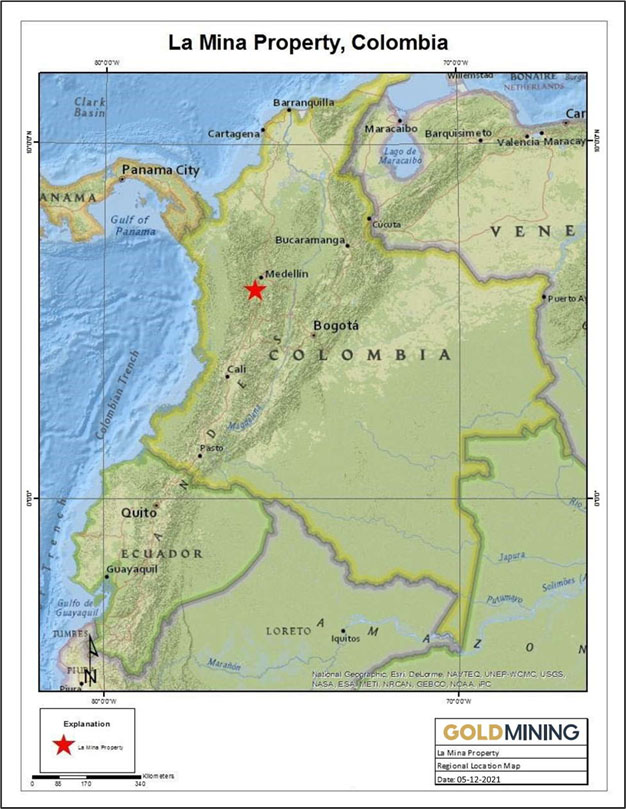
| Metal Mining Consultants Inc. Effective Date July 6, 2021 |
 |
| GoldMining Inc. NI 43-101 Report – La Mina Project |
Page 27 |
Figure 4‑2 La Mina Project Location and Access Map
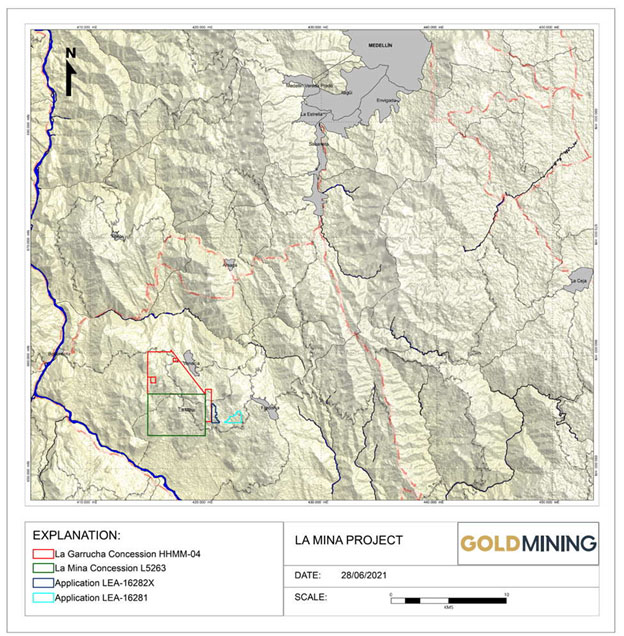
|
4.2 |
MINERAL TENURE |
The La Mina project property consists of two concession contracts totaling 3,210 hectares. Namely the 1798 hectare La Mina license with concession contract No. 5263 and the La Garrucha license with concession contract No. 6355B. The location and details regarding the claim block are outlined in Table 4.1 and are shown in Figure 4.3.
Exploration license No. 5263 (La Mina concession) was granted by the Instituto Colombiano de Geologia y Minera (“INGEOMINAS”) to Alejandro Montoya-Palacios (“Montoya”) in early 2000 as an Exploration Concession under the mining code of the country which grants the operator the right to explore over a three-year renewable period under certain conditions for an additional two years including submission of a work plan known as a “Plan de Trabajo de Inversión”, or PTI. This was turned into a concession contract on August 5, 2020.
| Metal Mining Consultants Inc. Effective Date July 6, 2021 |
 |
| GoldMining Inc. NI 43-101 Report – La Mina Project |
Page 28 |
Table 4‑1 La Mina Property Ownership
|
Concession Contract Number |
Size Hectares |
Registered Title Holder |
|
L5263005 |
1,794 |
La Mina Fredonia SAS |
|
HHMM04 |
1,416 |
Bellhaven Exploraciones Inc. Sucursal Colombia |
Figure 4‑3 Claim Map Showing Location of La Mina Porphyry Bodies in Relation to Concession Boundaries
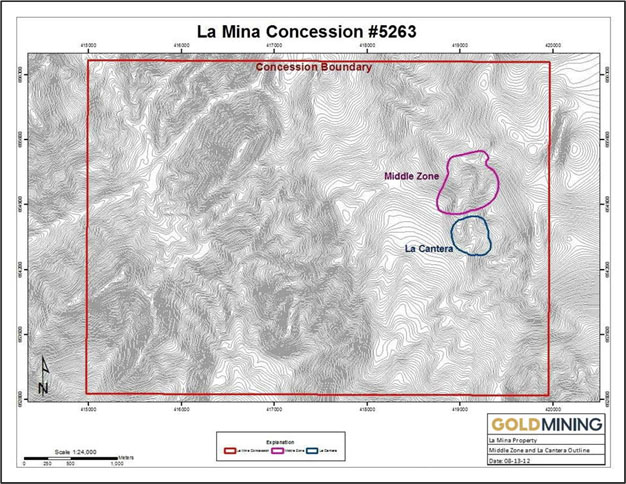
GoldMining's indirect Colombian subsidiary, Bellhaven Exploraciones (formerly Aurum Exploration Inc. Colombia) signed an option agreement with Mr. Montoya to initially acquire 80% of the concession. The property was held jointly by both parties through Mina Fredonia S.A.S. (“Fredonia”)with GoldMining currently indirectly owning 100% of the La Mina concession.
| Metal Mining Consultants Inc. Effective Date July 6, 2021 |
 |
| GoldMining Inc. NI 43-101 Report – La Mina Project |
Page 29 |
La Garrucha exploration contract, No. 6355B, now owned by Bellhaven Exploraciones Inc Sucursal Colombia but originally owned by AngloGold Ashanti Colombia S.A., was optioned by Bellhaven in 2013 to explore a Au-Cu porphyry deposit indicated by the surface and drilling exploration in 2011 and 2012 respectively. This contract was renegotiated on March 7, 2015. As a result GoldMining, through its ownership of Bellhaven Exploraciones and La Mina Fredonia S.A.S. owns 100% of this mining concession with Bellhaven to pay AngloGold Ashanti US$ 1 per reserve ounce declared in a bankable Feasibility Study, or present at the start of mining construction, whichever comes first.
|
4.3 |
SURFACE RIGHTS AGREEMENTS |
Bellhaven signed an additional agreement with B2 Gold regarding purchase of the surface rights over 60 hectares around the exploration camp site and immediate project area; this allowed Aurum to acquire these surface rights for a total of US$ 470,000 over a 3-year period. During 2011, Bellhaven completed the payments under this agreement and now owns 100% of the surface rights governed by the agreement with B2Gold.
During 2012, Bellhaven also acquired additional surface rights over the El Limon target. In April, the Company contracted with a private vendor for the purchase of 100% interest in a surface property encompassing 9.75 hectares to the north of the Middle Zone (the El Limon property). The property acquisition closed in Q3 of 2012 for a total purchase price of US $15,315 in cash.
Surface rights over a portion of the La Garrucha concession contract is subject to a surface rights lease agreement and an option agreement as outlined below:
Pursuant to a surface rights lease agreement dated July 6, 2016 and amended August 19, 2016, April 4, 2017, November 5, 2018, and July 10, 2020, Bellhaven can lease the surface rights over a portion of the La Garrucha concession contract by making the following payments:
● US$ 75,000 in May 2017 (paid);
● US$ 75,000 in November 2017 (paid);
● US$ 75,000 in May 2018 (paid);
● US$ 75,000 in November 2018 (paid);
● US$ 25,000 in June 2019 (paid);
● US$ 25,000 in December 2019 (paid);
● US$ 25,000 in June 2020 (paid);
● US$ 25,000 in December 2020 (paid);
● US$ 25,000 in June 2021 (paid );
● US$ 25,000 in December 2021;
● US$ 25,000 in June 2022; and
● US$ 55,000 in December 2022.
In addition, pursuant to an option agreement entered into by Bellhaven on November 18, 2016, amended April 4, 2017, November 5, 2018, and July 10, 2020, Bellhaven can purchase the La Garrucha concession by making an optional payment of US$ 650,000 on December 7, 2022.
The project is subject to a 2% net smelter return royalty (NSR) payable to Gold Royalty Corp.
|
4.4 |
GENERAL |
The authors know of no other known royalties, back in rights, payments or any other agreements to which the property is subject outside of the existing Colombian mining code. There are no known environmental liabilities to the La Mina project. There are no known factors or risks that affect access, title, or the right or ability to perform work on the property.
| Metal Mining Consultants Inc. Effective Date July 6, 2021 |
 |
| GoldMining Inc. NI 43-101 Report – La Mina Project |
Page 30 |
|
5 |
ACCESSIBILITY, CLIMATE, LOCAL RESOURCES, INFRASTRUCTURE AND PHYSIOGRAPHY |
|
5.1 |
ACCESS AND INFRASTRUCTURE |
Access and infrastructure surrounding the La Mina project are good. The area is surrounded by gravel roads which connect a rural farm population to various nearby population centers, including Medellin which is a large cosmopolitan city (Figure 4.2 above). Various small towns, including Bolombolo and La Pintada are located within a two-hour drive of the project area.
La Mina is accessed on a paved highway 30 km southwest of Medellin to the junction with a gravel road that leads 11 km to the property. Total travel time by road from Medellin is approximately 2.0 – 2.5 hours depending on road conditions and traffic around Medellin. Access to the area is available year round.
The economy surrounding La Mina is based on rural activities. Agricultural activities dominated by coffee and mixed- crop farming are the principal sources of land use and income.
While GoldMining, through its wholly owned subsidiaries Bellhaven Exploraciones and La Mina Fredonia S.A.S. owns a considerable area of surface rights over the La Cantera and Middle Zone deposits, the Company has also secured surface access agreements with other property owners in the La Garrucha area of planned exploration and drilling. Additional surface rights may be necessary for the establishment of a commercial mining project.
Water, power, and labor are readily available at the project site. Local labor is not trained in modern exploration and mining methods, indicating the need to provide training and import qualified personnel. All requirements (personnel, equipment, contractors) for project exploration and development are available in Medellin. Heavy equipment and diamond drills are readily available throughout Colombia.
|
5.2 |
PHYSIOGRAPHY |
The project area is located on the eastern slopes leading up from the Cauca River. It is a major physiographic feature marking the limit between the Western and Central physiographic regions where the La Mina Property is located.
The topography in the property area can be described as “tropical mountainous”, with sharp positive and negative changes in relief from an average elevation of approximately 1,700 m with ridges cresting at approximately 2,000 m.
The property is essentially 100% vegetated by Andean forest, dense secondary scrub growth, agricultural crops, and grassy cattle pastureland.
|
5.3 |
CLIMATE |
The climate in this district can vary abruptly with elevation: below an elevation of ~1,000 m (in the Cauca river valley) the climate is hot (>24°C) whereas higher up it tends to be temperate (18°C to 24°C) between 1,000 m and 2,000 m, and then becomes cool above 2,000 m (12°C to 18°C). Annual rainfall is approximately 2,000 mm with the wettest months being from March to May, and then again from September to December.
| Metal Mining Consultants Inc. Effective Date July 6, 2021 |
 |
| GoldMining Inc. NI 43-101 Report – La Mina Project |
Page 31 |
|
6 |
HISTORY |
|
6.1 |
EXPLORATION PRIOR TO 2002 |
The Antioquia district of Colombia where the La Mina Property is located has been a source of gold mining that goes back several centuries to pre-Colombian times. Small-scale artisanal mining, some from hard-rock sources and some from alluvial deposits, were common throughout the district and so “barequero” prospectors were likely active throughout the Central Cordillera district on either flank of the River Cauca.
The general area around La Mina was been noted in early regional survey work by the Colombian mines department, INGEOMINAS and this led to the staking of ground by the original and still current owner, Mr. Alejandro Montoya in 2000.
Historical research by the Company has revealed local knowledge of several adits that targeted gold in the vicinity of the Middle Zone prospect. At one point, these mines were reportedly managed by a small-scale mining company from England. Artisanal miners exploited several streams originating from the resource areas in the past, a very small number of which are still active today. No records of production are known to exist, though different sources corroborate that mining activity goes back to at least the 1920’s. The amount of artisanal mining production is believed to be very small.
|
6.2 |
EXPLORATION 2002-2008 |
In the early 2000s, AngloGold Ashanti (AGA) carried out broad-scale geochemical and other exploration programs throughout this district of Colombia and was responsible for the initial discovery of copper-gold mineralization on surface at the La Cantera outcrop. In 2006, AGA drilled six holes into the La Cantera target, four of which successfully intercepted the gold-copper porphyry stock with mineralized intercepts of 50-100 m.
In 2007, AGA formed the Avasca Joint Venture with Bema Gold (subsequently transferred to B2Gold) who continued with further surface geochemistry and geophysics north and south from the La Cantera discovery, as well as further west over a prominent N-S trending magnetic ridge feature identified from aerial geophysics flown by the Avasca JV in 2007.
The early exploration work at La Mina by AGA beginning in 2002 and later in 2005-08 by the Avasca Joint Venture (Avasca) focused on the principal La Cantera Zone. These programs consisted of:
|
● |
Regional mapping, 1:20,000 scale |
|
● |
Property-scale geological mapping: 1:10,000 scale |
|
● |
Geochemical sampling, soils and rock |
|
● |
Trenching |
|
● |
Geophysical surveys: aerial magnetic and radiometrics |
|
● |
Drilling: six, core holes totaling 1,453 m (mid-2006) – AGA |
|
● |
At the end of 2007, a regional airborne magnetic/radiometric survey was completed over the Property and neighboring ground (Avasca) |
|
● |
In early 2008, the aerial geophysics was followed by additional auger soil and rock geochemical sampling programs over the anomalies (Avasca). |
|
● |
Various sampling methods have been used to explore the La Mina Property, as follows: |
| Metal Mining Consultants Inc. Effective Date July 6, 2021 |
 |
| GoldMining Inc. NI 43-101 Report – La Mina Project |
Page 32 |
|
● |
Regional-scale soil and rock/trench sampling carried out by AGA in 2002 which led to the discovery of the porphyry mineralization at the La Cantera zone. |
|
● |
In 2007/08, additional soil sampling was completed by the Avasca joint venture over the aero-magnetic anomalies identified from their aerial geophysics (2007). This soil sampling was completed on an irregular grid, widely spaced over the entire 1,794 ha Property area (123 samples), but principally focused on the area around the La Cantera prospect and immediate vicinity (~1 km by 1 km). A later rock sampling program in 2008 collected 857 samples on a 100-m standard grid, and focused on La Cantera and some nearby magnetic anomalies. |
Figure 6.1 illustrates the prominent magnetic features interpreted from aerial geophysics flown by the Avasca Joint venture in 2007. Identified clearly is the high magnetic response of the La Cantera porphyry stock at the southern end of the red rectangular block.
Figure 6‑1 Portion of Aerial Magnetics, Avasca Joint Venture 2007
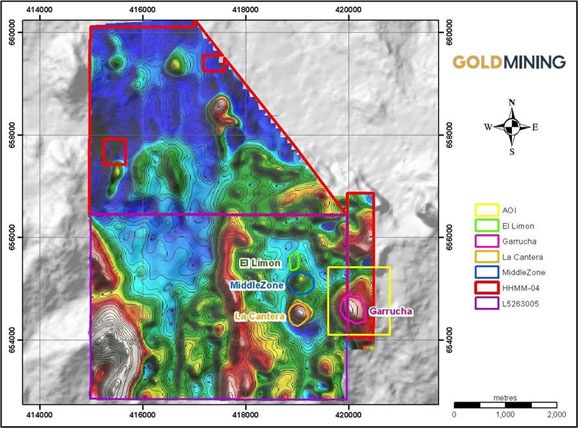
| Metal Mining Consultants Inc. Effective Date July 6, 2021 |
 |
| GoldMining Inc. NI 43-101 Report – La Mina Project |
Page 33 |
|
6.3 |
AGA DRILLING |
Six AGA drill holes were completed in and around the La Mina porphyry (later re-named the La Cantera Stock), with Holes 2 and 5 yielding 90-m plus intercepts of greater than 1 g/t Au and good copper grades at shallow depths. Drill-holes 4 and 6 also contained significant values located near the surface; however, Holes 1 and 3 were drilled off target to the west and did not encounter any mineralization of interest (Table 6.1).
Table 6‑1 AGA Drill Results
|
Drill Hole |
Dip |
Total Depth |
Significant Intercepts |
|
|
Name |
Degree |
m |
Thicknessm |
Au g/t/Cu % |
|
LM-01 |
-60.5 |
258 |
No Significant Intercepts |
|
|
LM-02 |
-58.5 |
189 |
152 |
0.82/0.26 |
|
LM-03 |
-60.5 |
201 |
No Significant Intercepts |
|
|
LM-04 |
-60 |
250 |
106 |
0.32/0.21 |
|
LM-05 |
-60 |
252 |
106 |
1.11/0.40 |
|
LM-06 |
-60 |
304 |
122 |
0.40/0.24 |
| Metal Mining Consultants Inc. Effective Date July 6, 2021 |
 |
| GoldMining Inc. NI 43-101 Report – La Mina Project |
Page 34 |
|
7 |
GEOLOGICAL SETTING AND MINERALIZATION |
|
7.1 |
REGIONAL GEOLOGY |
Colombia can be divided into four distinct geomorphological regions and can be seen in Figure 7.1.
|
1. |
The Guyana Shield |
|
2. |
The Andean System |
|
3. |
The Caribbean Region |
|
4. |
The Pacific Coast Region |
The La Mina property is located along the eastern margin of the western Cordillera in the Andean System (Figure 7.1).
| Metal Mining Consultants Inc. Effective Date July 6, 2021 |
 |
| GoldMining Inc. NI 43-101 Report – La Mina Project |
Page 35 |
Figure 7‑1 Geomorphological Regions of Colombia Showing the Approximate Location of La Mina
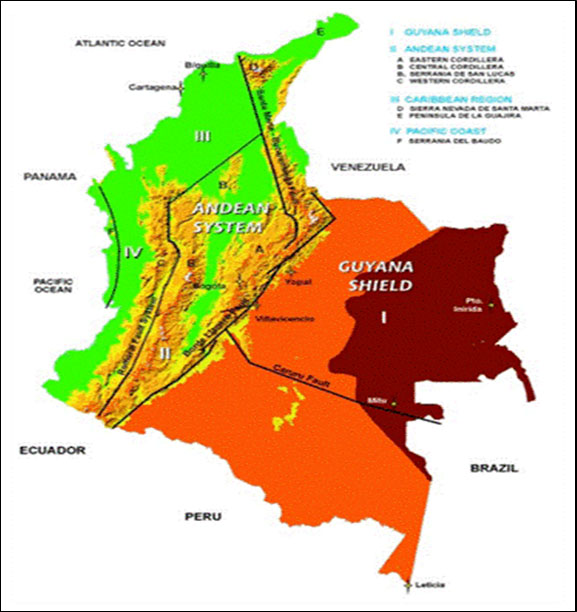
The La Mina region lies within the Romeral terrane, an oceanic mélange comprised of metamorphosed mafic to ultramafic complexes, ophiolite sequences, and oceanic sedimentary rocks of probable Late Jurassic to Early Cretaceous age (Cediel & Cáceres, 2000; Cediel et al., 2003). This terrane was accreted to the continental margin along the Romeral Fault, which lies east of the River Cauca, in the Aptian (125 to 110 Ma). Movement on the Romeral Fault was dextral indicating that terrane accretion was highly oblique from the southwest. The Romeral Fault zone is marked by dismembered ophiolitic rocks, including glaucophane schist, in a tectonic mélange and is interpreted as a terrane suture marking an old subduction zone. The resulting suture zone and mélange-related rocks can be traced for over 1,000 km along the northern Andes. The Romeral terrane is bounded on the west side by the Cauca Fault. Further west, additional oceanic and island arc terranes were subsequently accreted to the Western Cordillera in the Paleogene and Neogene periods, culminating in the on-going collision of the Choco (or Panamá) arc since the late Miocene. This reactivated the Cauca and Romeral faults with left lateral and reverse movements (Cediel & Cáceres, 2000; Cediel et al., 2003). The original structure of the Romeral fault system has been modified by various post-Romeral tectonic events.
| Metal Mining Consultants Inc. Effective Date July 6, 2021 |
 |
| GoldMining Inc. NI 43-101 Report – La Mina Project |
Page 36 |
Following accretion, the Romeral terrane was overlain unconformably by siliciclastic, continentally derived sediments of the Oligocene to Lower Miocene Amagá Formation. The Amagá Formation, comprises basal conglomerates, sandstones, siltstones, shales, and local coal seams (Durán et al., 2005). These sedimentary rocks are overlain by a thick sequence of volcanic and sedimentary rocks of the Late Miocene Combia Formation. The Combia Formation is divided into a Lower Member of basalt and andesite lava flows, agglomerates, and tuffs, and an Upper Member of conglomerates, sandstones, and crystal and lithic tuffs (Durán et al., 2005). The Combia Formation volcanic rocks were associated with at least one Middle to Late Miocene volcanic arc emplaced into the Romeral terrane basement rocks during this time period. Also associated with latest stages of arc formation was the syntectonic emplacement of a series of shallow-level intrusive rocks, including poly-phase hypabyssal stocks, dikes and sills of dioritic, granodioritic, and monzonitic composition. These intrusive rocks cut all of the aforementioned sedimentary and volcanic units of the Amaga and Combia Formations. K-Ar whole-rock ages for the intrusive rocks range from 8 to 6 Ma (Cediel et al., 2003). The Combia Formation and accompanying hypabyssal intrusive rocks are well represented along a 100-km by 20-km N-S trending belt extending from Anserma in the south to Jericó, Fredonia and Titiribí, located to the north of the La Mina Project (Figure 7.2).
Following the early accretionary events, the region was subjected to compressional deformation during the Early-Middle Miocene and Middle-Late Miocene. In both cases the deformation was related to additional accretionary tectonic events taking place to the west along the active Pacific margin. The structural architecture of the Romeral fault and mélange system is essentially that of a 10+ km wide series of N-S striking, vertically dipping, and dextral transcurrent faults. Virtually all lithologic contacts within the Romeral basement rocks are structural in nature and are characterized by abundant shearing, mylonitization, and the formation of clay-rich fault gouge. Structural reactivation during the Miocene resulted in orthogonal compression accompanied by mostly west-directed (back) thrusting and high- angle reverse fault development in the basement rocks. The Amaga Formation was deformed primarily into generally open, upright folds; local tilting and near isoclinal folds were associated with the west-directed thrust faults. The Combia Formation records both tilting and open folding. Both the Amaga and Combia Formations exhibit moderate to strong diapiric doming where affected by the emplacement of the Miocene suite of intrusive rocks. N-S, NE-SW, NW-SE and E-W striking conjugate shearing and dilational fracturing affect all of the above geologic units.
| Metal Mining Consultants Inc. Effective Date July 6, 2021 |
 |
| GoldMining Inc. NI 43-101 Report – La Mina Project |
Page 37 |
Figure 7‑2 Tectonic Map of Colombia
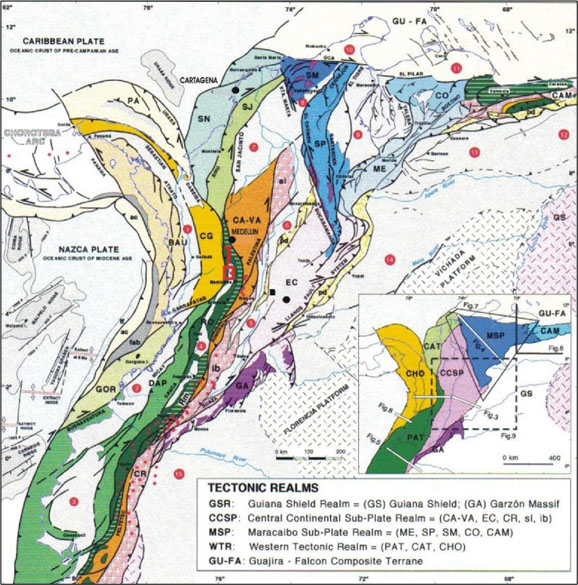
Note: Litho-tectonic and morpho-structural map of Colombia and northwestern South America, after Cediel et al. (2003). RO = Romeral terrane; Rm = Romeral melange; CA-VA = Cajamarca-Valdivia terrane; sl = San Lucas block; ib = Ibague block;; DAP = Dagua- Pinon terrane; CG = Canas Gordas terrane; BAU Baudo terrane SP = Santander massif - Serranfa de Perija; GS = Guiana Shield; GA = Garzon massif; ME = Sierra de Merida; SM = Sierra Nevada de Santa Marta; EC = Eastern Cordillera; CO = Carora basin; CR = Cordillera Real; GOR = Gorgona terrane; PA = Panama terrane; SJ = San Jacinto terrane; SN = Sinu terrane; GU-FA = Guajira- Falcon terrane; CAM = Caribbean Mountain terrane; fab = fore arc basin; ac = accretionary prism; tf = trench fill; pd = piedmonte; 1 = Atrato (Choco) basin; 2 = Tumaco basin; 3 = Manabf basin; 4 = Cauca-Patfa basin; 5 = Upper Magdalena basin; 6 = Middle Magdalena basin; 7 = Lower Magdalena basin; 8 = Cesar-Rancherfa basin; 9 = Maracaibo basin; 10 = Guajira basin; 11 = Falcon basin; 12 = Guarico basin; 13 = Barinas basin; 14 = Llanos basin; 15 = Putumayo-Napo basin; Additional Symbols: PALESTINA = fault\suture system; red dot = Plio-Pleistocene volcano; Bogota = town or city.
| Metal Mining Consultants Inc. Effective Date July 6, 2021 |
 |
| GoldMining Inc. NI 43-101 Report – La Mina Project |
Page 38 |
|
7.2 |
PROPERTY GEOLOGY |
The La Mina Project lies within the Middle Cauca Belt of Miocene-age volcano-plutonic rocks of central Colombia. This belt hosts several significant porphyry gold or copper-gold disseminated deposits such as La Colosa, Titiribí, Quebradona, and Quinchia, as well as large epithermal gold districts such as Marmato.
The immediate area around the La Mina Project is underlain by country rocks consisting of a series of basaltic volcanic rocks (Barroso Formation – oceanic tholeiitic basalts, dolerites, tuffs, etc), sedimentary rocks of the Amagá Formation, and an upper Combia Formation of basalts and andesitic basalts inter-layered with volcaniclastic rocks and coarse-grained sedimentary rocks (conglomerates, arenites).
At the project scale, the key host rocks for the porphyry-related gold, copper, and silver mineralization are the intermediate composition volcanic rocks of the Combia Formation and the sub-volcanic breccias and related shallow level, porphyries which have intruded the Combia Formation. The Combia Formation developed within a Late Miocene magmatic arc that is interpreted to have included an early quiescent stage of volcanism and a later explosive event of wider extent.
Localized intrusive centers (e.g., La Cantera, Middle Zone, El Limon, and La Garrucha) comprise a series of intermediate composition porphyries and related intrusive (emplacement) breccias (Figure 7.3). The structural controls for these intrusive centers appears to have been provided by N-S, NE-SW and/or NW-SE trending, high-angle fault systems associated with the major Cauca River structure to the west of La Mina.
Figure 7‑3 Generalized Geologic Map of the La Mina Project Area
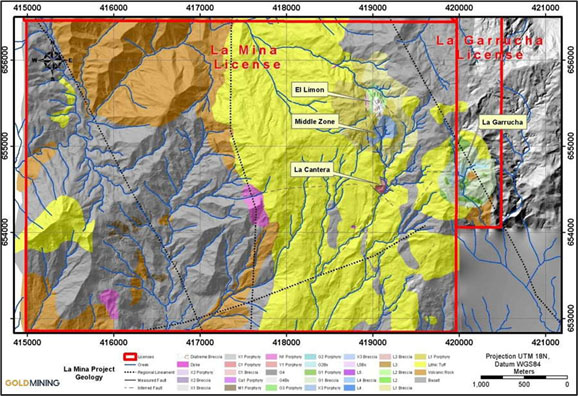
| Metal Mining Consultants Inc. Effective Date July 6, 2021 |
 |
| GoldMining Inc. NI 43-101 Report – La Mina Project |
Page 39 |
The following broad groupings of geological unites have been interpreted and recognized from surface mapping and the drill core logging to date:
|
● |
Lithic and Crystal Tuffs (Combia Formation) |
|
● |
Basalt-Andesite Lavas and Flows (Combia Formation) |
|
● |
The La Cantera Porphyry and intrusive breccia |
|
● |
The Middle Zone Porphyries and intrusive breccias |
|
● |
The La Garrucha Porphyries and intrusive breccias |
|
● |
The El Limon Porphyry |
|
● |
Porphyry – undifferentiated |
|
● |
Hydrothermal Breccia(s) |
|
7.3 |
INTRUSIVE ROCKS |
A good understanding of the intrusive rocks is key to understanding the porphyry-related Au-Cu mineralization. Intrusive rocks at La Mina consist of porphyries of probable intermediate composition. At least four different porphyries have been identified in the La Mina Project area and are distinguished by their mineralogy and texture. Other potential targets exist on the property, as distinguished from magnetic and geochemical anomalies. None of these additional targets have been drill tested to date. To standardize the naming conventions for the porphyry-related, intrusive lithologies used in logging and mapping, a generic lithology naming scheme was adopted. Modifiers such as “early” and “late” were dropped and rocks were named primarily based on the original mineralogy and texture and, in some cases, the absence or presence of and type of alteration.
As with other porphyry deposits worldwide, there is considerable overlap of the original mineralogy and texture of the different intrusive lithologies at La Mina. To date, four different centers of porphyry-related alteration and mineralization have been recognized: 1) La Cantera, 2) Middle Zone, 3) El Limon, and 4) La Garrucha. The phenocryst-to-matrix ratio of the intrusive lithologies varies from 50:50 to 80:20. The intrusive lithologies in all four intrusive centers contain essential plagioclase and amphibole phenocrysts, some lithologies contain minor but important amounts of magmatic biotite, and quartz phenocrysts or “eyes” are sparse. The dominant accessory mineral is magnetite; sphene, where observed, appears to be an alteration product of magmatic biotite or amphibole.
The porphyry “families” were named very simply for the geographic location of where they were first encountered (C – La Cantera, L – El Limon and G – La Garrucha) or in the case of the X family, because the origin and significance of these porphyries were uncertain. The numerical modifiers reflect the order in which the different members of a family (when more than one has been identified) were identified and not the relative age of the members of a family. For example, in the X family of Middle Zone, X1 was the first X porphyry identified but it was later determined to be younger than X3 and older than X2. These relative ages are based on clearly defined contact relations between different members of the same family. In previous press releases and the initial NI 43-101 technical report describing the geology of the La Cantera area (May 2011), the C1 Porphyry and C1 Breccia were referred to as the “early intermineral porphyry” and “early intermineral breccia” and the X1 Porphyry and X1 Breccia were referred to as the “late intermineral porphyry” and “late intermineral breccia”. The intrusive rocks of the El Limon area follow the nomenclature of Middle Zone. The relative ages of the different intrusive rocks and breccias in the various intrusive centers are given in Table 7.1.
| Metal Mining Consultants Inc. Effective Date July 6, 2021 |
 |
| GoldMining Inc. NI 43-101 Report – La Mina Project |
Page 40 |
The relative ages of the different intrusive phases are well known within each intrusive center; however, to date, cross-cutting or contact relationships between C1 phases and L1 phases and X3 phases have not been observed. Hence, the relative ages of these lithologies cannot be determined definitively. Similarly, the relative ages of the intrusive phases in the La Garrucha area as compared with the other areas are not known. The porphyries and breccia at La Garrucha have only been mapped at surface and in limited drilling. The relative age relationships although becoming clear at La Garrucha are not clear with respect to the other porphyries, elsewhere in the project area.
Table 7‑1 Lithological Descriptions
|
La Cantera |
Middle Zone |
La Garrucha |
|||
|
X2 Porphyry |
Youngest |
||||
|
X1 Breccia |
 |
G4 Breccia |
Youngest |
||
|
X2 Porphyry |
Youngest |
X1 Porphyry |
G4 Porphyry |
 |
|
|
X1 Breccia |
 |
X3 Breccia |
G2 Breccia |
||
|
X1 Porphyry |
X3 Porphyry |
G2 Porphyry |
|||
|
C1 Breccia |
L1 Breccia |
G1 Breccia |
|||
|
C1 Porphyry |
L1 Porphyry |
G1 Porphyry |
|||
|
Volcanic Rocks |
Oldest |
Volcanic Rocks |
Oldest |
Volcanic Rocks |
Oldest |
While there have been limited thin section studies of the Cantera and Middle Zone rocks, the detailed petrographic and mineralogical reports are pending at the time of this writing. The following lithological descriptions are derived from hand and drill-core specimens exhibiting weak to intense alteration and should therefore only be considered as field terms. Associated with the porphyries are breccias which includes auto-breccia and contact breccia. An auto-breccia is described as an intrusive breccia with clasts and matrix of the same intrusive phase. Contact breccias occur at contacts of porphyries with older volcanic rocks of the Combia Formation or with older porphyries. The porphyries are described below from youngest to oldest.
|
7.3.1 |
X2 PORPHYRY (X2) |
The X2 Porphyry is observed at the Cantera and Middle Zone prospects. This porphyry is believed to be one of the youngest porphyries at La Mina and as such is typically not mineralized or strongly altered. X2 Porphyry is composed of 70% phenocrysts and 30% fine-grained matrix. Phenocrysts are comprised of 45% plagioclase, 17% amphibole (hornblende?) and 7% biotite. Quartz phenocrysts are absent. Plagioclase phenocrysts are subhedral to euhedral tabular crystals ranging from 1.5 x 1.0 mm to 1.0 x 1.0 mm. Amphiboles occur as euhedral to subhedral crystals with bimodal sizes of 1.0 x 0.5 mm and 3.0 x 2.0 mm. Biotite is euhedral at 0.3 X 0.3 mm size. Accessory minerals consist of 1% fine-grained disseminated magnetite.
| Metal Mining Consultants Inc. Effective Date July 6, 2021 |
 |
| GoldMining Inc. NI 43-101 Report – La Mina Project |
Page 41 |
Alteration of the X2 porphyry where present is weak and typically propyllitic to intermediate argillic with chlorite-carbonate and chlorite-clay respectively, chlorite partially replacing amphiboles. Locally where X2 is altered, trace to 1% disseminated pyrite is common.
|
7.3.2 |
X1 PORPHYRY (X1) |
The X1 is a name applied to a different intrusive at La Cantera than at Middle Zone. It was recognized first at La Cantera as a post-mineralizing intrusive at the core of the deposit. It was originally described as a “late intra-mineral porphyry” because it is only weakly and locally mineralized. X1 Porphyry has a porphyritic texture with 65-70% phenocrysts and 30-35% very fine-grained matrix. Phenocrysts are comprised of 45% plagioclase, 15-17% amphibole (hornblende) and 3-5% biotite. Quartz phenocrysts are absent. Plagioclase phenocrysts are typically subhedral to euhedral tabular crystals of two sizes, 1.5 x 1.0 mm and 1.0 x 1.0 mm. Amphiboles occur as euhedral –subhedral crystals of bimodal size of 0.4 x 0.2 mm and 0.8 x 0.2 mm. Biotite is euhedral at 0.3 x 0.3 mm size. Accessory minerals consist of 1% fine-grained disseminated magnetite.
The X1 at Middle Zone is a mineralizing intrusive that has a similar petrography to the X1 of La Cantera. However, in this case it exhibits strong to intense potassic alteration with secondary biotite and magnetite within and proximal to gold and copper mineralized zones. In well mineralized portions it shows a high Cu/Au ratio. Pervasive replacement of the fine-grained feldspar matrix with potassium feldspar imparts a light pinkish buff color. In areas distal to mineralization, a condition met predominantly in Middle Zone, the unit may be argillically or propyllitically altered.
|
7.3.3 |
X3 PORPHYRY (X3) |
The X3 porphyry is observed only at the Middle Zone prospect. Contact relationships indicate that it is younger than El Limon Porphyry but older than X1 and X2 Porphyries. The X3 Porphyry is a bimodal feldspar porphyry with a phenocryst: matrix ratio of 70:30. Phenocrysts consist of 45-50% plagioclase, 10-12% amphibole (hornblende) and 2-3% biotite. Quartz phenocrysts are absent. Plagioclase is typically bimodal with finer phenocrysts of 0.4x0.2 mm and coarser phenocrysts at 0.4x0.8 mm. The coarser-grained plagioclase is euhedral to subhedral and usually zoned and occurs occasionally as agglomerated pairs. The content of coarse plagioclase is variable from 0 to 5%. Amphiboles are typically euhedral to subhedral and also bimodal in nature with >50% coarse grained at 3 x 1 mm and the balance of finer crystals having axes of 1 x 0.5 mm. Accessory minerals consist of 1% fine-grained disseminated magnetite.
Alteration is variable in type and intensity. Alteration ranges from moderate propyllitic to pervasive, intense potassic (biotite-magnetite with local potassium feldspar replacement of earlier biotite). Argillic or argillic/phyllic alteration is localized along the contacts and margins of late fractures and faults.
|
7.3.4 |
LA CANTERA PORPHYRY (C1) |
The La Cantera porphyry is the mineralizing intrusive at the La Cantera prospect. The La Cantera porphyry is a medium- to fine-grained porphyry. The porphyry is very “crowded” with a phenocryst: matrix ratio of approximately 70:30. The groundmass comprises both micro- phenocrysts and fine-grained crystalline quartzo-feldspathic (?) material (<20% of the matrix is aphanitic). Phenocrysts include plagioclase, amphibole, and biotite. Subhedral to euhedral plagioclase phenocrysts range in size from 0.4 x 0.2 mm to 0.8 x 0.5 mm, with occasional coarser-grained phenocrysts having axes of 1.0 x 1.5 mm in length. Subhedral to euhedral amphibole (10-12%) ranges in size from 0.2 x 0.4 mm to 0.4 x 0.8 mm. Biotite phenocrysts (5-8%) are dominantly 0.3 x 0.3 mm euhedra. Quartz phenocrysts are absent. Accessory minerals consist of 1-2% fine-grained disseminated magnetite.
| Metal Mining Consultants Inc. Effective Date July 6, 2021 |
 |
| GoldMining Inc. NI 43-101 Report – La Mina Project |
Page 42 |
Alteration of the La Cantera porphyry is dominantly potassic, having secondary biotite and potassium feldspar-bearing assemblages (± magnetite ± actinolite). The potassic alteration occurs as both pervasive replacement of phenocrysts and matrix and in veins and along vein selvages. Potassium feldspar alteration, when present, is generally pervasive with total replacement of plagioclase by potassium feldspar, as well as frequent veins and vein selvages of potassium feldspar. Zones of banded quartz and quartz-magnetite veins are common and locally may comprise >25% of the rock volume. Closely spaced sheeted quartz veins are common in the upper portions of the porphyry. Elsewhere quartz veins do not exhibit a preferred orientation.
|
7.3.5 |
EL LIMON PORPHYRY (L1) |
The El Limon L1 Porphyry has been observed in the El Limon, Filo de Oro and Middle Zone prospects immediately to the north of the La Cantera gold-copper prospect. It is exposed over an area of several square kilometers. The El Limon porphyry is composed of 60% phenocrysts and 40% matrix. Phenocrysts are comprised of 40% subhedral to euhedral plagioclase (occasionally as agglomerated pairs) that range in size from 1 x 1.5 mm to 3 x 5 mm, 15% subhedral amphibole that is commonly 0.5 x 5.5 mm in size, and 5% subhedral biotite, which is typically 1 x 2 mm in size. Quartz phenocrysts are absent. Accessory minerals consist of 1% very fine-grained magnetite. The El Limon Porphyry is characterized by coarse grained plagioclase phenocrysts which makes it visibly distinct from the C1, X1 and X2 Porphyries. When strongly altered, it can be difficult to distinguish L1 Porphyry from X3 Porphyry.
Alteration of the El Limon Porphyry is most commonly structurally-controlled argillic to intermediate argillic. Potassic alteration ranges from intense secondary biotite, commonly without magnetite, to moderate secondary biotite-magnetite. The latter occurs typically near contacts with potassically-altered X1 Porphyry or X3 Porphyry or their related intrusive breccias. Local weak potassic alteration in the form of secondary biotite and occasional potassium feldspar occurs in veins or selvages along quartz-magnetite veins.
|
7.3.6 |
EL LIMON PORPHYRY (L2) |
The L2 porphyry is observed in drill core at the El Limon prospect centered approximately 300 m NNW of the center of the Middle Zone. L2 porphyry is composed of 45% phenocrysts and 55% fine grained, near aphanitic, matrix. Phenocrysts are comprised of 40% subhedral to euhedral plagioclase in a bimodal fashion ranging in size from <1 mm to 1.5 mm long and from 2 to 2.5 mm long, 2-5% subhedral amphibole is commonly 0.5 x 2 mm in size. The matrix is composed of a 50:50 mix of very fine-grained plagioclase crystals and too fine to identify aphanitic felsic material (feldspar and amphibole). Accessory minerals consist of magnetite. The L2 porphyry at El Limon is a mineralizing porphyry typically cut by an open quartz and quartz-magnetite vein stockwork and local fine-grained disseminated chalcopyrite.
| Metal Mining Consultants Inc. Effective Date July 6, 2021 |
 |
| GoldMining Inc. NI 43-101 Report – La Mina Project |
Page 43 |
|
7.3.7 |
EL LIMON PORHYRY (L3) |
The El Limon L3 Porphyry occurs within the El Limon prospect. It is almost identical to the L1 porphyry except that it has 3-5% medium grained brown secondary biotite evenly distributed throughout. Like the L1 porphyry it is for the most part argillically altered as well. No other alteration other than the clay and biotite is evident and it typically is un-mineralized with detection limit Au values.
|
7.3.8 |
G1 PORPHYRY (G1) |
The La Garrucha intrusive center occurs in an area named La Garrucha approximately 650 m east of the La Cantera deposit. The possible importance of the intrusive center was realized in mid-2011 by Bellhaven geologists during routine reconnaissance geological mapping and sampling. Geologists encountered potassically altered (biotite-magnetite) porphyry with quartz-chalcopyrite veins in some of the sparse outcrops in the area.
The G1 Porphyry has a crowded porphyritic appearance with a phenocryst to matrix ratio of 60% to 40%. Phenocrysts are comprised of 55% plagioclase and 5% amphibole (hornblende?). Quartz and biotite phenocrysts are absent. Euhedral plagioclase phenocrysts range in size from 0.5 x 1 mm to 2 x 3 mm with sparse, larger phenocrysts 3 x 5 mm in size. Amphibole occurs as 0.5 x 2 mm to 2 x 4 mm euhedral phenocrysts. Accessory minerals consist of 1-3% fine-grained disseminated magnetite.
Most commonly the G1 Porphyry exhibits moderate to strong argillic alteration which largely masks the possible presence of earlier propylitic or potassic alteration. Locally weak to moderate potassic alteration is observed as secondary biotite, magnetite and actinolite with only weak potassium feldspar development.
G1 porphyry appears to be the earliest porphyry developed at La Garrucha and is in contact with Combia Formation volcanic rocks along its outer margins. Biotite hornfels superimposed on the volcanic rocks occurs along the G1-volcanic contact.
|
7.3.9 |
G2 PORPHYRY (G2) |
The G2 porphyry intrudes and brecciates the G1 Porphyry. These contact relationships have been seen at the surface and in drill core. The G2 Porphyry is texturally distinct from G1 and is characterized by a phenocryst: matrix ratio of 40:60. As such, G2 has a less crowded appearance in hand specimen due to the great percentage of fine-grained matrix. Phenocrysts are comprised of 35% plagioclase and 5% amphibole (hornblende?). Subhedral plagioclase is typically 1 x 1.5 mm in size whereas subhedral to euhedral amphiboles range in size from 0.3 x 2 mm to 0.5 x 2 mm. Accessory minerals consist of 1% fine-grained disseminated magnetite.
The G2 Porphyry is characterized by potassic alteration that includes both biotite and potassium feldspar-bearing assemblages. Magnetite and actinolite (?) occur with the biotite and potassium feldspar and also occur as a common alteration assemblage without significant secondary biotite.
The G2 porphyry has two distinct periods of intrusion, after G1 and before G4 but also after G4. This is seen in drilling where G2 is observed in some areas to cut G4 porphyry and in other areas is itself cut by G4. In each case the G2 porphyry is similar, except for the presence of significant additional alteration and mineralization in the early G4 porphyry.
| Metal Mining Consultants Inc. Effective Date July 6, 2021 |
 |
| GoldMining Inc. NI 43-101 Report – La Mina Project |
Page 44 |
|
7.3.10 |
G4 PORPHYRY (G4) |
The G4 Porphyry has only been encountered in drill core. It has a phenocryst: matrix ratio of 40:60 and is characterized by 35-50% subhedral to euhedral plagioclase phenocrysts that define a seriate texture and range in size from 0.2 x 0.4 mm to 3 x 4 mm. Approximately 5-10% amphibole phenocrysts are subhedral to euhedral and range in size from 0.2 x 0.5 mm to 0.5 x 2 mm. G4 porphyry is very similar in appearance to the G2 porphyry and is typically only distinguished from the G2 porphyry by its high potassium feldspar content.
Alteration in the G4 Porphyry includes strong to intense pervasive potassium feldspar and magnetite with actinolite-magnetite, propylitic, sericitic, and argillic overprinting assemblages. Argillic overprinting is structurally controlled along fault zones. The potassium feldspar alteration which distinguishes G4 from G2 results in growth of feldspar phenocrysts, coarsening the crystal texture, and reduces the amount of fine-grained matrix (fine-grained matrix is more visibly crystalline). The potassium feldspar also imparts a distinct pink color cast to the rock making it more readily distinguishable from G2 porphyry.
|
7.3.11 |
INTRUSIVE BRECCIAS |
Numerous breccias are associated with the emplacement of all of the porphyries. The breccias appear to be of two main types: auto-breccia and contact breccia. Auto breccias form along the margins of and within individual intrusive bodies where portions of the intrusive has partially cooled and solidified but comes in contact with unsolidified magma of the same intrusive. Contact breccia is created in several environments: a) at the contact with enclosing brittle host rocks such as the Combia Formation volcanic rocks at La Cantera, or b) with the El Limon porphyry in the Middle Zone, or c) at the contact with the younger non-mineralized G1 porphyry at La Garrucha, or d) along the contact of the Limon porphyry with the host Combia Formation. In addition to these breccias, in some parts of the deposits, there are localized zones that appear to represent the mixing of two magmas (e.g., when both were still molten or very plastic). Pebble dikes have also been encountered cutting the intrusive rocks at the La Mina Project.
Breccias at La Mina can be simple, complex or any variation in between. Alteration can impact on the ability to identify the origin of clasts and/or matrix. Breccias may be matrix or clast supported; the breccia clasts can be monolithic or heterolithic. The breccia clasts range in shape from angular to rounded and exhibit a wide range of alteration and mineralization in the clast population. Potassically altered clasts, sometimes cut by quartz-sulfide veinlets, can occur in a porphyry exhibiting significantly less alteration than the clasts indicating that there was an alteration and mineralization event that pre-dated the brecciation.
The X2 porphyry at Middle Zone, discussed above, has an associated breccia now called the White Breccia (WBx). This unit is almost invariably found in contact with the X2, and appears to form a halo around it. It constitutes an intensely altered, structural boundary zone that formed as a result of the X2 intrusive phase. It contains fragments of X1 and X3, the two porphyries that were intruded by the X2 unit.
The intrusive breccias at La Mina have been named based on the composition of the intrusive that forms the breccia matrix. Thus, the X3 Breccia can contain a wide range of clasts (e.g., composition, alteration, mineralization, shape, etc.) but the common thread linking all of the X3 Breccias is the fact that the breccia matrix is X3 Porphyry.
| Metal Mining Consultants Inc. Effective Date July 6, 2021 |
 |
| GoldMining Inc. NI 43-101 Report – La Mina Project |
Page 45 |
|
7.4 |
VOLCANIC ROCKS |
The volcanic rocks in the immediate project area (e.g., La Cantera, the Middle Zone, El Limon, and La Garrucha) comprise a lower sequence of mafic lavas (basaltic to andesitic composition) and an upper sequence of lithic, crystal and crystal-lithic tuffs of presumed more felsic compositions. The technical team has not yet conducted any detailed work on the volcanic stratigraphy has been done to date. In the field, the volcanic rocks occur in sparse, isolated outcrops and are commonly pervasively argillized and oxidized (supergene) making rock identification difficult.
During the drilling of the La Cantera deposit, once the drill passed from the porphyry into the volcanic wall rocks, drilling typically continued for only another 30-50 m before termination (as a function of alteration and mineralization). Accordingly, little was learned about the volcanic rocks from logging the drill core.
The alteration in the volcanic rocks is largely similar to the alteration in the intrusive rocks, comprising propylitic, potassic, and argillic assemblages. However, most of the volcanic rock form strong to intense biotite hornfels along this contact.
At the El Limon prospect and on the northeast margin of the Middle Zone occur what appears to be explosive diatreme or subvolcanic pebble breccia. These breccia are characterized by polymictic well-rounded clasts in a highly milled matrix. At the El Limon prospect it is conceivable that this explosive breccia removed much of the better grade mineralization leaving only narrow marginal zones of weak Au-Cu mineralized L2 porphyry.
|
7.5 |
STRUCTURE |
The structural history at La Mina is gradually becoming clear as a result of three main factors: 1) evidence visible from airborne and ground geophysics, 2) mapping of surface features and inferences based on geomorphologic patterns, and 3) Middle Zone drilling, including the first oriented core holes.
There are several regional lineaments that cross the project area and these can be seen in the aerial magnetometry. The most important of these large-scale features is a prominent N-S trending lineament that parallels the N-S trending zone of anomalous magnetometry that bisects the project area. Two N30W trending regional lineaments are also present in the project area. The eastern-most of these is parallel to a zone of less well defined zones of anomalous magnetometry, anchored by the La Garrucha prospect at its southeastern-most extent.
There are some faults mapped in the project area (Figure 7.3). These faults exhibit NE, NW, and EW strikes. Dips on all of the mapped faults are generally sub-vertical. The abundant vein and fracture controlled alteration and mineralization generally lack a dominant orientation. When veins and fractures do exhibit a preferred orientation, it is commonly EW. In some areas of the property, stream cuts and ridgelines are clearly related to structural features; and this has been confirmed by drilling in the case of Middle Zone. These patterns show primarily NE and NW trends.
Middle Zone drilling reveals a number of significant structures, which have been tentatively grouped as intercepts of several structural planes. The most important of these planes strikes NW though the central part of Middle Zone, and down drops both the later lithologic units and high Au-Cu mineralization on the west side. The two lobes of the Middle Zone magnetic anomaly shown in some versions of the data can be explained by offset along this NW trending fault zone.
| Metal Mining Consultants Inc. Effective Date July 6, 2021 |
 |
| GoldMining Inc. NI 43-101 Report – La Mina Project |
Page 46 |
|
7.6 |
LA CANTERA PROSPECT GEOLOGY |
The La Cantera prospect was mapped initially by Anglo Gold Ashanti geologists at La Mina in 2002, with initial drilling in 2006. The geology was subsequently re-mapped by Bellhaven Copper and Gold geologists in 2010 and 2011 and is shown in Figure 7.4. The resource estimate discussed in this report (released as the La Mina Technical Report dated August 29, 2011) is based on 6,579 m drilled in the La Cantera resource area: 1,452 m contained in six holes drilled by AngloGold Ashanti/Bema Gold in 2006 and 4,953 m contained in 13 holes drilled by Bellhaven in 2010 and 2011. The La Cantera drilling was conducted on two N-S lines, three NW-SE lines, and two NE-SW lines to an approximate depth of 550 m.
Porphyry-related alteration and mineralization at the La Cantera prospect outcrops on the surface. The surface projection of the intrusive center measures approximately 200-m EW by 200-m NS. The porphyry-related alteration and mineralization has been traced from surface to a depth of 550 m and is open at depth. The La Cantera prospect geology is relatively well understood. The volcanic rocks of the Combia Formation were intruded by the C1 Porphyry with both contact and auto breccias forming at the margins of the C1 Porphyry. Subsequently the C1 Porphyry, C1 Breccia, and the Combia Formation volcanic rocks were intruded by the X1 Porphyry and auto breccias formed at the contact of X1 Porphyry with the C1 Porphyry and C1 breccia (Figure 7.4). Small amounts of X2 Porphyry subsequently intruded the X1 Porphyry.
| Metal Mining Consultants Inc. Effective Date July 6, 2021 |
 |
| GoldMining Inc. NI 43-101 Report – La Mina Project |
Page 47 |
Figure 7‑4 Surface Geology of the La Cantera Prospect Showing the Location of the Drill Holes
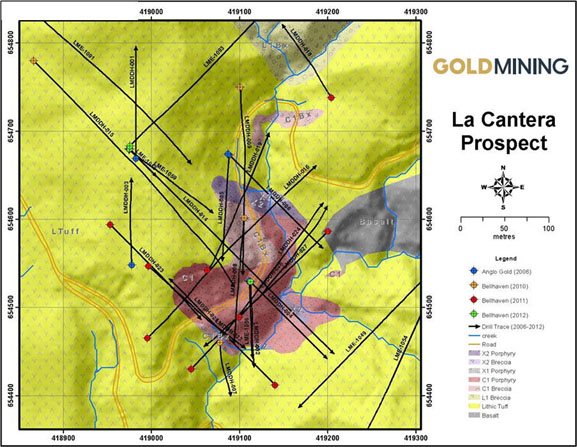
| Metal Mining Consultants Inc. Effective Date July 6, 2021 |
 |
| GoldMining Inc. NI 43-101 Report – La Mina Project |
Page 48 |
Figure 7‑5 North-South Cross Section (Looking West) of Geology through the La Cantera Deposit
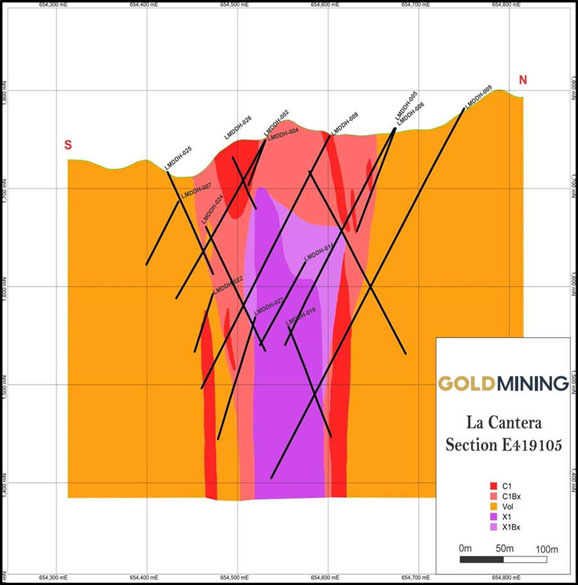
|
7.7 |
LA CANTERA PROSPECT ALTERATION |
The observed alteration at La Cantera is typical of a gold-copper porphyry deposit: a potassic (calcic) core and an outer propylitic zone. Sericitic and intermediate argillic alteration assemblages are typically structurally controlled and can be observed overprinting the potassic and propylitic zones.
| Metal Mining Consultants Inc. Effective Date July 6, 2021 |
 |
| GoldMining Inc. NI 43-101 Report – La Mina Project |
Page 49 |
Potassic alteration is present as both biotite- and potassium-feldspar-bearing assemblages. Much of the potassic alteration is vein and fracture controlled. Common vein and fracture types include: 1) potassium feldspar “A” veins, 2) quartz veins with potassium feldspar selvages, 3) quartz-magnetite veins 4) hairline, anastomosing biotite fractures and 5) magnetite veins. The pervasive biotite alteration appears to have formed as a reaction between the hydrothermal fluids and primary magmatic mafic minerals. Much of the C1 Porphyry and C1 Breccia are pervasively altered to a biotite-magnetite assemblage wherein the mafic phenocrysts and porphyry matrix are replaced by biotite-magnetite. Volcanic rocks of the Combia Formation are also altered to biotite- and potassium feldspar-bearing assemblages near contacts with C1 Porphyry and C1 Breccia. As a result, the gold-bearing rocks are highly magnetic which creates a sharp contrast with the barren and weakly magnetic intermediate argillic altered rocks as well as the non-magnetic sericite-altered rocks surrounding the potassic core. Potassium feldspar-bearing alteration is locally widespread and pervasive but more commonly exists as irregularly shaped patches as a partial to total replacement of earlier biotite-bearing alteration assemblages. An example of pervasive biotite-magnetite-actinolite alteration in C1 Porphyry is shown in Figure 7.6.
Figure 7‑6 LMDDH-008-288m. C1 Porphyry with Pervasive Biotite-Magnetite Alteration of the Matrix and Actinolite Alteration of Primary Magmatic Mafic Phenocrysts
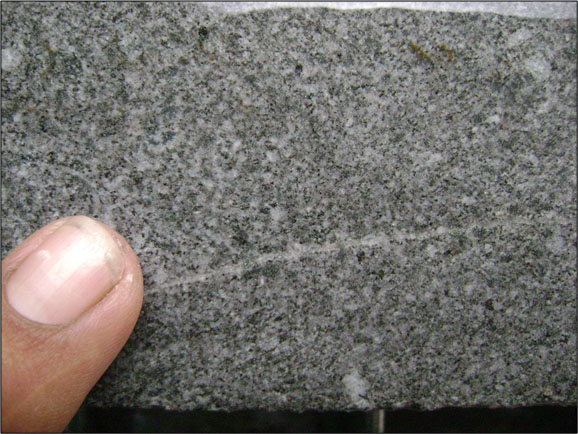
Calcic alteration is represented by actinolitic amphibole-bearing alteration. This amphibole is dark green in color and although not verified by thin-section petrography, it is interpreted as actinolite by analogy to other copper-gold porphyry deposits in the Middle Cauca Belt (e.g., Quebradona and La Colosa) where it has been identified as actinolite. The actinolite occurs in three different vein and fracture types: 1) potassium feldspar-actinolite ± actinolite vein selvages, 2) magnetite veins with actinolite halos and 3)-actinolite ± chalcopyrite ± bornite veins and fractures. The actinolitic amphibole also occurs as selective replacement of earlier secondary biotite which itself had originally replaced igneous amphibole or biotite phenocrysts. The presence of actinolite in the alteration assemblage is typically a good indicator of gold and copper mineralization.
| Metal Mining Consultants Inc. Effective Date July 6, 2021 |
 |
| GoldMining Inc. NI 43-101 Report – La Mina Project |
Page 50 |
At least four different phases of vein and fracture-controlled potassic and calcic alteration and mineralization have been recognized and, in order of their paragenetic sequence, include:
|
● |
Early hairline biotite fractures in zones of intense potassic alteration |
|
● |
Magnetite-actinolite±chalcopyrite±bornite veins and fractures which can reach a vein density of 30 per meter |
|
● |
Quartz-magnetite-actinolite±chalcopyrite±bornite veins and fractures which cut the magnetite-actinolite veins and fractures and which can reach a vein density of approximately 10 per meter. These veins and fractures are the principal source of mineralization in the La Cantera prospect |
|
● |
Quartz-magnetite veins are commonly banded in appearance and do not carry significant mineralization. |
An example of the superposition of multiple episodes of vein and fracture-controlled alteration and mineralization is shown in Figure 7.7.
Figure 7‑7 LMDDH-016 392.5m. C1 Breccia with Potassic Alteration (Magnetite-k-Feldspar +/- Actinolite) Cut by Sheeted Magnetite Veins, Quartz Magnetite Stockwork Veins and Late Pyrite-filled Fractures
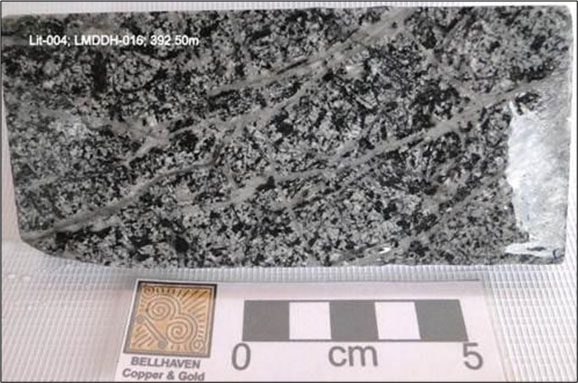
Sericitic alteration is represented by the mineral assemblage quartz-sericite-pyrite and is observed to a greater or lesser extent away from the potassic core but also replacing earlier potassic alteration. Sericitic alteration can be pervasive but much of the sericitic alteration is associated with quartz-pyrite veins with sericite selvages, the so-called “D” veins observed at El Salvador, Chile (Gustafson and Hunt, 1975).
| Metal Mining Consultants Inc. Effective Date July 6, 2021 |
 |
| GoldMining Inc. NI 43-101 Report – La Mina Project |
Page 51 |
Propylitic alteration is represented by two different mineral assemblages: 1) a “proximal” epidote- chlorite-illite-calcite assemblage and 2) a more widespread, “distal” chlorite-illite-calcite assemblage. Mafic phenocrysts are replaced by chlorite and calcite; plagioclase phenocrysts are partially to totally replaced by both epidote-calcite and illite-calcite. Propylitic alteration is found mostly in the Combia Formation volcanic rocks and X1 Porphyry and X1 Breccia. Propylitic alteration, if originally present in C1 Porphyry and C1 Breccia, has largely been overprinted by the potassic alteration.
Argillic alteration, both hypogene and supergene, is structurally controlled and is associated with faults, breccias and fractures and includes both chlorite- and “clay”-bearing assemblages. Argillic alteration is the youngest alteration event preserved at La Cantera.
|
7.8 |
LA CANTERA PROSPECT MINERALIZATION |
The principal ore minerals associated with the Au-Cu porphyry mineralization at La Mina are chalcopyrite and lesser bornite, both with associated gold mineralization. Secondary copper minerals (chalcocite, azurite, malachite and chrysocolla) do occur locally in the upper portions of the La Cantera prospect. Overall gold mineralization greater than 0.3 g/t Au is sulfide-poor and typically contains less than 1% total sulfides. In this type of mineralization chalcopyrite ± bornite are more abundant than pyrite.
Minor silver, lead, and zinc mineralization is associated with calcite±quartz-tetrahedrite-sphalerite veins that cut earlier potassic alteration. These veins may be related to argillic alteration, which is commonly present where these veins are found.
The most sulfide-rich with alteration and mineralization at La Cantera are the sericitic and argillic assemblages that commonly contain more than 3% total sulfides. However, this mineralization typically contains less than 0.3 g/t Au and is not economically important.
The typical habit of the ore minerals can be summarized as follows:
|
● |
Chalcopyrite occurs in veinlets or as disseminated grains with secondary biotite, potassium feldspar and/or actinolite. Locally chalcopyrite occurs as clots with or without pyrite and it can be associated with bornite. In the C1 Porphyry and C1 Breccia chalcopyrite occurs in quartz-pyrite and potassium feldspar-actinolite “A” veins. Chalcopyrite, with and without bornite, also occurs in sulfide veins and fractures with pyrite and in veins with anhydrite and in veins with gypsum. |
|
● |
Bornite is less abundant than chalcopyrite but it occurs in the same habits as, and virtually always with, chalcopyrite. Additionally it occurs as anhedral crystals, often displaying exsolution patterns, associated with chalcopyrite or occurring as a replacement of chalcopyrite. |
|
● |
Gold is usually associated with chalcopyrite and bornite and to a lesser extent with tetrahedrite and filling fractures in chalcopyrite grains. |
|
● |
In addition to the calcite ± quartz - sphalerite veins described previously, tetrahedrite also locally forms subhedral crystals or grains associated with chalcopyrite or bornite. |
|
● |
In addition to the calcite ± quartz - tetrahedrite veins described previously, sphalerite can be found occurring as anhedral grains with chalcopyrite ± bornite ± pyrite. |
| Metal Mining Consultants Inc. Effective Date July 6, 2021 |
 |
| GoldMining Inc. NI 43-101 Report – La Mina Project |
Page 52 |
|
● |
In general, the mineralogy of the La Cantera system appears “clean” in that there are few minerals or elements that would negatively impact favorable response to standard metallurgical processes. This was confirmed by Bellhaven’s preliminary metallurgical results, announced on November 15, 2011. In that news release, the Company reported achieving copper and gold recoveries above 85% in concentrates of commercial grade with low impurities. |
|
● |
An example of the distribution of and lithological controls on gold mineralization at the La Cantera deposit is shown in Figure 7.8. Note the sharp breaks of the >0.5 g/t Au mineralization at contacts between C1 Porphyry and Breccia with X1 Porphyry and Breccia. In general, the >0.5 g/t Au mineralization does not extend significantly into the post-mineralizing X1 Porphyry or Breccia. |
Figure 7‑8 Drill Hole Intercepts with >0.5g/t Au in the La Cantera Prospect
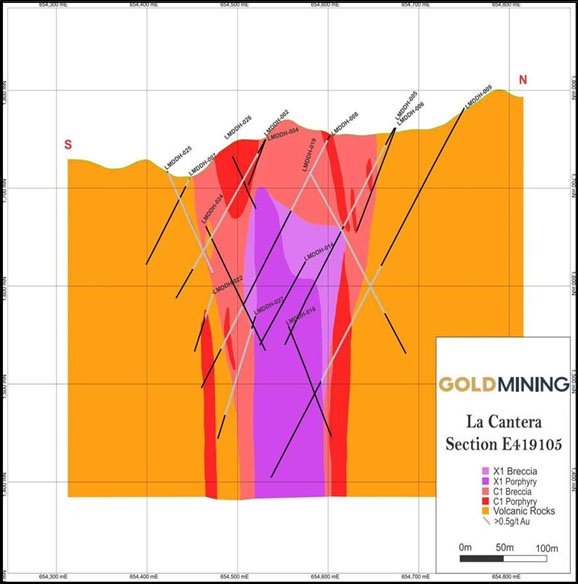
| Metal Mining Consultants Inc. Effective Date July 6, 2021 |
 |
| GoldMining Inc. NI 43-101 Report – La Mina Project |
Page 53 |
|
7.9 |
MIDDLE ZONE PROSPECT GEOLOGY |
The Middle Zone prospect was mapped and drilled during work by Bellhaven geologists starting in 2010. The surface geology of the Middle Zone prospect is shown in Figure 7.9. In total, 54 holes were drilled at the Middle Zone prospect. The resource estimate discussed in this report is based on all 54 drill holes totaling 18,944 m of diamond core drilling. The Middle Zone drilling was conducted on one N-S line, six NW-SE lines, and four NE-SW lines to a maximum depth of 680 m below surface.
Porphyry-related alteration and mineralization at the Middle Zone prospect outcrops in some areas, and the elongate surface projection of the intrusive center measures approximately 300-m NW-SE by 400-m NE-SW. The porphyry-related alteration and mineralization has been traced from surface to a depth of 680 m and is open at depth. All intrusive units, regardless of their relationship to the mineralizing events, show similar rock types, and also show great similarity to those at La Cantera. The volcanic rocks of the Combia Formation were first intruded by the extensive, pre-mineralization L1 porphyry with marginal contact breccias. Subsequently both the L1 porphyry and volcanic rocks were intruded by the mineralizing X3 porphyry and breccia units (low copper/gold ratio), and later by the mineralizing X1 porphyry and breccia units (high copper/gold ratio). Mineralization occurring during these phases affected pre-existing units. For example, the L1 porphyry (normally barren) is mineralized in some locations near the X3 unit, and mineralization in the X3 unit has been augmented in some areas close to the later X1 unit. There are also areas of un-mineralized X3 and X1 distal to the center of the Middle Zone. This phenomenon has been observed in drilling to the north and northeast. The post-mineralizing X2 unit (which is analogous to the X1 unit at La Cantera) forms an alternating pod- or dike-like body that has intruded opportunistically along zones of weakness into the Middle Zone. Gold and copper values in this unit are very low, an order of magnitude less than in the surrounding L1 porphyry and volcanic units. However, the X2 intrusive is associated with the White Breccia, a strongly fractured and altered unit that often forms a halo around the X2. The White Breccia is mineralized according to the density and nature of X3 and/or X1 fragments.
The Middle Zone exhibits a structural influence not seen at La Cantera. The mineralizing intrusive units are fault bound on the southwestern side by a feature striking NW. Another major feature runs through the center of Middle Zone, also striking NW, which appears to have down dropped the western half of the deposit. This displacement is most apparent along the X1 and X2 units, and is clear from the distribution of higher copper grades within the X1. A series of other faults with approximate NS trends occur throughout the Middle Zone, which do not provide clear evidence for displacement.
| Metal Mining Consultants Inc. Effective Date July 6, 2021 |
 |
| GoldMining Inc. NI 43-101 Report – La Mina Project |
Page 54 |
Figure 7‑9 Surface Geology and Drill Holes Used in Resource Estimate at Middle Zone Prospect
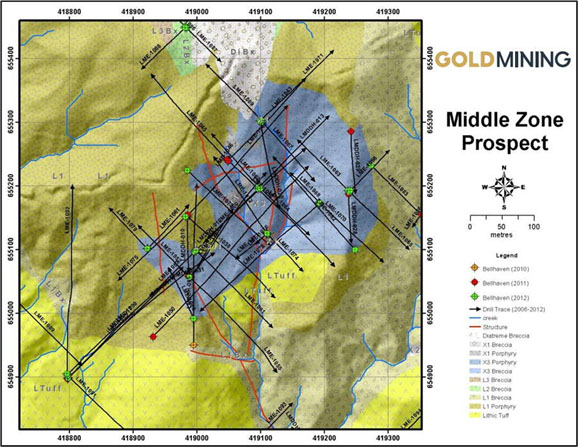
|
7.10 |
MIDDLE ZONE PROSPECT ALTERATION |
The observed alteration at Middle Zone is typical of a gold-copper porphyry deposit, thus very similar to that described for La Cantera prospect in Section 7.6a: a potassic (calcic) core and an outer propylitic zone. Sericitic and intermediate argillic alteration assemblages are typically structurally controlled and can be observed overprinting the potassic and propylitic alteration.
Some alteration features particular to Middle Zone that are not observed at La Cantera are as follows:
|
1. |
A strong halo of argillic alteration on the north and northeast sides of the deposit. This alteration penetrates the X1 and X3 units, and in some cases may have overprinted pre- existing mineralization (e.g., pyrite replacing magnetite in veins). This halo of argillic alteration is devoid of significant gold and copper. As with La Cantera, the argillic alteration appears to be a later event. |
|
2. |
An intense clay alteration is characteristic of the WBx (White Breccia) unit that is often found at the boundaries of the post-mineralizing X2 unit. |
In addition, veining at Middle Zone exhibits a distinct paragenetic sequence, for the most part observed in the following order:
|
● |
Early sinuous quartz veins and hairline magnetite-actinolite-chalcopyrite veins |
| Metal Mining Consultants Inc. Effective Date July 6, 2021 |
 |
| GoldMining Inc. NI 43-101 Report – La Mina Project |
Page 55 |
|
● |
Several styles of quartz veins with magnetite at the vein boundaries |
|
● |
Banded quartz veins and sinuous quartz-magnetite-actinolite-chalcopyrite veins |
|
● |
Quartz veins with pyrite and chalcopyrite along the centerlines |
|
● |
Anhydrite-pyrite-chalcopyrite-bornite veins (bornite rare), pyrite-calcite-magnetite veins |
|
● |
Quartz-calcite-pyrite-sphalerite-galena veins |
|
● |
Quartz-gypsum and quartz-gypsum-pyrite veins |
|
7.11 |
MIDDLE ZONE PROPSECT MINERALIZATION |
The principal ore minerals associated with the Au-Cu porphyry mineralization at Middle Zone consist of chalcopyrite, pyrite, and, in very rare cases, bornite. Secondary copper minerals (chalcocite, cuprite, malachite and chrysocolla) do occur locally in the shallow portions at Middle Zone prospect; they represent supergene alteration of primary hypogene copper mineralization. Generally, gold mineralization greater than 0.3 g/t Au occurs with sulfides, but total sulfide content is normally less than 3% (with pyrite > chalcopyrite).
Unlike La Cantera, Middle Zone mineralization falls into two distinct classes. The first is Au-rich, relatively Cu poor mineralization occurring in the X3 and X3 Breccia. It occurs at relatively shallow levels, primarily where the X3 unit drapes over the X1 Porphyry. In Figure 7.10, examples of this mineralization type are marked in ellipses labeled ‘A’. The second mineralization type is Cu-rich with variable Au, and predominates in the X1 Porphyry and X1 Breccia units. In Figure 7.10, examples of this type are shown in the ellipse labeled ‘B’. The deepest drilling in Middle Zone terminates in this second mineralization type.
| Metal Mining Consultants Inc. Effective Date July 6, 2021 |
 |
| GoldMining Inc. NI 43-101 Report – La Mina Project |
Page 56 |
Figure 7‑10 NE-SW Cross Section through Middle Zone, Showing Significant Intercepts. Labels A and B Refer to the Two Distinct Mineralization Types
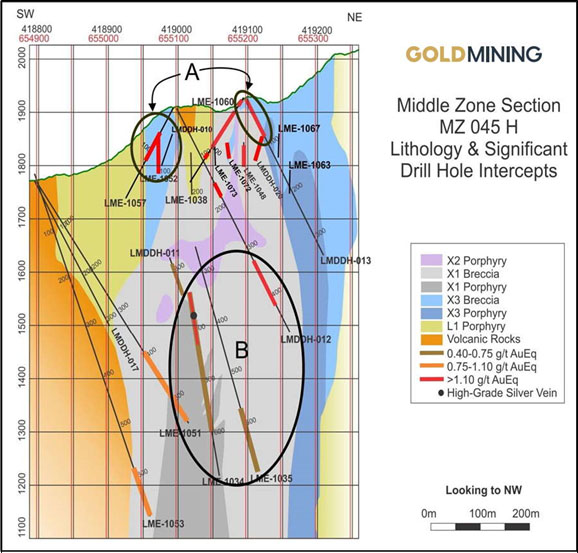
Minor silver, lead, and zinc mineralization is associated with cross-cutting calcite ± quartz- sphalerite-galena veins (late in the paragenetic sequence, as listed in the previous section). These veins are more common in the pervasive argillic alteration zone peripheral to the deposit. They also occur in contact margins between early and late porphyries. In the latter case, sub- epithermal veins occur predominantly in fault zones.
The most sulfide-rich zones at Middle Zone are the pyrite-rich argillic assemblages, where it is thought the sulfide has replaced magnetite during overprinting of potassic alteration. Pyrite content can exceed 6%. However, this mineralization invariably contains less than 0.3 g/t Au and is not economically important.
The typical habits of mineralization can be summarized as follows:
|
● |
Chalcopyrite occurs mainly in veinlets, or as disseminated grains with secondary biotite, potassium feldspar and/or actinolite. In the X3 Porphyry and X3 Breccia, chalcopyrite occurs in pink quartz-pyrite “A-type” veins; it may also occur as disseminations in fine matrix breccia with or without grey silica clasts. |
| Metal Mining Consultants Inc. Effective Date July 6, 2021 |
 |
| GoldMining Inc. NI 43-101 Report – La Mina Project |
Page 57 |
|
● |
Chalcopyrite and magnetite also occur as very thin, hair-like veinlets, at borders or in the centerlines of pink quartz veins. This is common when the porphyry units show actinolite–magnetite alteration. |
|
● |
Chalcopyrite associated with pyrite in veins and fractures, and in veins with gypsum, which cut all veins and structures described previously. |
|
● |
In calcite ± quartz – sphalerite - galena veins, chalcopyrite also locally forms subhedral crystals or grains associated with pyrite. |
As with La Cantera, the ore mineralogy at Middle Zone appears “clean” in that there are few minerals or elements that could negatively impact favorable response to standard metallurgical processes.
|
7.12 |
LA GARRUCHA PROSPECT GEOLOGY |
The La Garrucha prospect is a current exploration target for GoldMining at the La Mina Project. Routine surface mapping and sampling in 2011 indicated the presence of porphyritic intrusive rocks containing Au values up to 1.5 g/t Au in outcrop. Initial diamond drilling commenced in July 2011 with 6 drill holes (LME-1037, LME-1039, LME-1040, LME-1042, LME-1044 and LME-1047) completed. At the time drill holes were stopped before crossing the boundary of the adjacent AngloGold Ashanti Corporation license area to the east of the La Mina concession. The 2011 drilling indicated the presence of significant porphyry-style alteration and mineralization. A second drilling campaign of 5 drill holes (LME-1095, LME-1096, LME-1097 and LME-1098) in 2012 successfully intersected high-grade porphyry-style mineralization in hole LME-1096 and an intensely altered new (G4) porphyry, within the last 10-m of drill core averaging 1.09 g/t Au and 0.20% Cu.
Upon finalization of the acquisition of the AGAC license systematic soil sampling, surface mapping, and rock-channel sampling further defined the most prospective area of porphyry mineralization to guide diamond drilling. Diamond drilling at La Garrucha resumed in May 2013 and 7 holes were completed.
Porphyry-related alteration and mineralization at the La Garrucha prospect outcrops in some areas along stream beds and areas of steep topographic relief. Results from diamond drilling to date suggests that the elongate (330o azimuth) core of the airborne magnetic anomaly outlines the surface projection of the area containing mineralized G2 and G4 porphyries. Porphyry-related alteration and mineralization has been traced from surface to a depth of 500 m over a width of some 200 m and is open at depth.
The porphyry complex at La Garrucha consists of at least 3 distinct porphyry events consisting of G1, G2 and G4 and their respective intrusive and contact breccias. The earliest porphyry, G1, intruded Combia Formation volcanic rocks. G1 event breccias occur near the volcanic contact and contains clasts of volcanic rock and G1 porphyry. Local zones of G1 auto breccia occur within the G1 porphyry. G2 porphyry intrudes the G1 and G1 breccias. G1 occurs as well crystallized porphyry, dykes, auto breccia and contact breccia with G1 porphyry. The G4 porphyry is believed to be the core of the porphyry complex at La Garrucha and hosts much of the Au-Cu mineralization. Similar to G2 porphyry G4 breccias form within and along the margins of the G4 porphyry. Core logging suggests the G2 porphyry may span the period of time from the intrusion of G1 to post G4 emplacement. Neither the G2 nor G4 porphyry appears to have come in contact with the volcanic Combia rocks.
| Metal Mining Consultants Inc. Effective Date July 6, 2021 |
 |
| GoldMining Inc. NI 43-101 Report – La Mina Project |
Page 58 |
La Garrucha appears thus far to be more structurally similar to La Cantera in that does not appear to be broken up by cross faults like the Middle Zone. However, throughout the porphyry complex there are numerous steep angle fault zones often exhibiting clay gouge over several meters either side of the fault. Occasionally however the faults exhibit intensely crushed and fractures rock rather than gouge over several meters. Faults are frequently observed along lithologic contacts particularly between porphyries and breccia. No significant fault offsets are known to date.
Figure 7‑11 Surface Geology of Drill Holes at La Garrucha
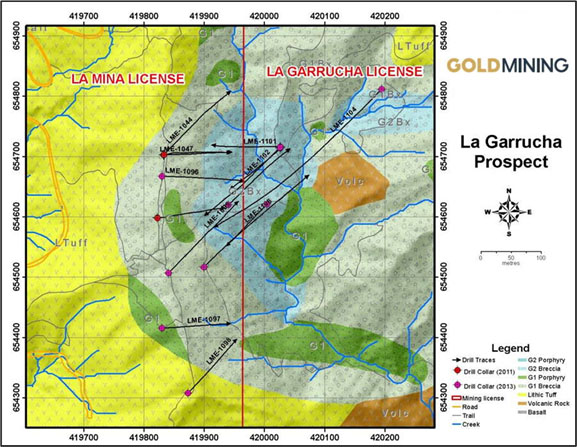
| Metal Mining Consultants Inc. Effective Date July 6, 2021 |
 |
| GoldMining Inc. NI 43-101 Report – La Mina Project |
Page 59 |
Figure 7‑12 NE-SW La Garrucha Cross Section
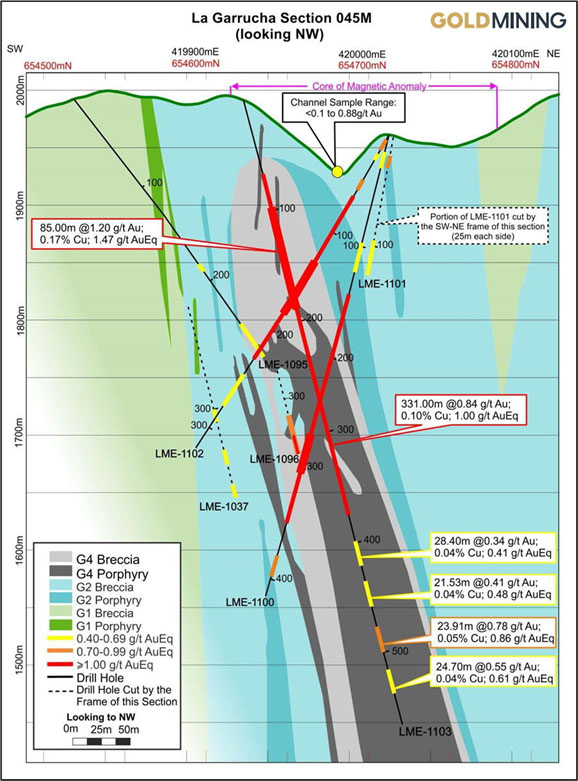
| Metal Mining Consultants Inc. Effective Date July 6, 2021 |
 |
| GoldMining Inc. NI 43-101 Report – La Mina Project |
Page 60 |
|
7.13 |
LA GARRUCHA PROSPECT ALTERATION |
The observed alteration at La Garrucha is typical of a gold-copper porphyry deposit, thus very similar to that described for La Cantera and Middle Zone prospects in Section 7.6.1: a potassic core, grading out to sodic-calcic, and an outer argillic zone. Magnetite alteration is ubiquitous throughout all of the porphyry phases and intensifies where porphyries or their breccias come in contact. Typically the magnetite is destroyed and replaced by pyrite in sericitic alteration zones and argillized fault zones. Sericitic alteration in the form of quartz-sericite-pyrite (QSP) appears to be structurally controlled and is observed overprinting the potassic, sodic-calcic, and local areas of propylitic alteration. A particular type of late-stage quartz - sulphide +/-carbonate vein set, up to several cm wide, invariably is enveloped by varying widths of QSP alteration, typically over intervals less than one meter but can be over 10s of meters where numerous veins occur at regular intervals over a number of meters.
Typically from the outer margin of G1 porphyry, we encounter weak to moderate argillic (clay) alteration overprinting an inner sodic-calcic alteration zone of actinolite-magnetite. More proximal to the later G2 porphyry moderate to intense secondary biotite and biotite magnetite alteration prevails within G1 porphyry and breccia. Alteration of G2 for the most part consists of early sodic-calcic (actinolite-magnetite) and later (where proximal to G4) moderate potassic alteration in the form of biotite, distal to G4, and potassium feldspar where close to G4 porphyry. Typically where G2 is within several meters of G4 porphyry G2 porphyry is strongly potassium feldspar flooded exhibited by an increase in the potassium feldspar in the groundmass and an increase in the quantity of potassium feldspar envelopes along fractures and quartz veins. Late-stage overprinting of both potassic and sodic-calcic is exhibited by local-to-pervasive weak propylitic alteration consisting of chlorite, epidote and calcium carbonate.
The G4 porphyry is intensely potassium feldspar altered. Without the intense K-spar alteration it would be almost identical in appearance to G2 porphyry. To the naked eye it is readily distinguished from G2 by its slightly coarser crystalline texture and marked pink color. Where alteration is most intense G4 porphyry has almost no crystalline texture visible and is almost totally composed of massive potassium feldspar. Although this is not extensive, it is locally common in 10-30cm patches. Later sodic-calcic alteration (actinolite-magnetite) overprints the potassic alteration giving the porphyry a dark greenish-pink cast. Preliminary observations suggest these areas contain somewhat higher Au-Cu values.
In conjunction with wall-rock alteration the La Garrucha porphyries are cut by a variety of porphyry style veins in varying amounts. The veins are typically composed of various combinations of quartz, magnetite, magnetite-sulphide, quartz-magnetite, quartz-magnetite-sulphide, quartz-sulphide and quartz-carbonate-sulphide. Preliminary paragenesis of these veins based on observations from 13 drill holes is as follows:
|
● |
Early magnetite veins, often hairline in size, cut by all other vein types |
|
● |
Quartz-chalcoplyrite ± bornite centerline veins with <1 mm centerline of chalcopyrite in semi-otherwise translucent quartz; typically several close spaced generations of this vein type as often times these cut similar quartz-chalcopyrite ± bornite centerline veins. |
|
● |
Quartz-magnetite ± chalcopyrite ± bornite veins with magnetite along inside margin of quartz vein |
| Metal Mining Consultants Inc. Effective Date July 6, 2021 |
 |
| GoldMining Inc. NI 43-101 Report – La Mina Project |
Page 61 |
|
● |
Quartz-magnetite ± chalcopyrite ± bornite centerline veins (magnetite along centerline) |
|
● |
Quartz-pyrite veins with sericite envelopes |
|
● |
Quartz-carbonate ± pyrite ± sphalerite ± stibnite |
|
● |
Carbonate veins |
|
7.14 |
LA GARRUCHA PROPECT MINERALIZATION |
The principal ore minerals associated with the Au-Cu porphyry mineralization at La Garrucha consist of chalcopyrite and lesser amounts of bornite. Secondary copper minerals (chalcocite, cuprite, malachite and chrysocolla) do occur locally in the shallow portions at La Garrucha but are rare and do not account for significant Au-Cu values volumetrically. Pyrite mineralization for the most part is low at La Garrucha except where secondary QSP alteration has overprinted magnetite. Typically the total sulphide content of the gold-copper zone at La Garrucha is less than 2% whereas the magnetite content averages approximately 3-5%.
Chalcopyrite is much more common than bornite. Bornite typically occurs in trace amounts and usually indicates higher Au values. Both chalcopyrite occur as disseminations and in various veins types as disseminations, patches and ribbons. In a typical moderately-to-well mineralized zone at La Garrucha the chalcopyrite will rarely exceed 1 vol% and typically averages 0.3 to 0.4 vol%. Chalcopyrite in veins however can make up to 20% by volume but these veins are typically less than 1-2 mm wide.
For the most part the tenor of the Au-Cu mineralization at La Garrucha is reflected in the presence of quartz veins and hydrothermal magnetite. However, in some instances there is little difference in Au-Cu grades between rocks containing 5 vol% quartz veins and rocks containing 25 vol% quartz veins. For lithologies exhibiting identical alteration intensities the Au-Cu content will be low (typically less than 0.30 g/t Au) where quartz veins are absent.
Minor silver, lead, and zinc mineralization is associated with cross-cutting quartz-calcite-sphalerite-galena veins (late in the paragenetic sequence, as listed in the previous section). These veins are more common at La Garrucha than Middle Zone and La Cantera. At La Garrucha they are more common in G1 porphyry and breccia than G2 porphyry and breccia and much less common in the G4 porphyry and breccia.
|
7.15 |
EL LIMON PROPSECT GEOLOGY |
The Limon complex measures approximately 800 m in diameter of a sub-circular shape in plan view. The Limon porphyry complex partially encircles the Middle Zone to the north, west and south. Within the complex are two known mineralizing porphyry systems, the Middle Zone prospect and the El Limon prospect. Argillic and propylitic alternation assemblages occur high in the system at the El Limon prospect. A possible explosive diatreme at El Limon suggests that the El Limon prospect porphyry is situated high vertically in the porphyry system. This may account for why the El Limon prospect is weakly mineralized. It may well be that higher grades of gold and copper occur at depth where a possible potassic alteration zone occurs associated with an undiscovered porphyry stock.
| Metal Mining Consultants Inc. Effective Date July 6, 2021 |
 |
| GoldMining Inc. NI 43-101 Report – La Mina Project |
Page 62 |
Figure 7‑13 El Limon Prospect Geology
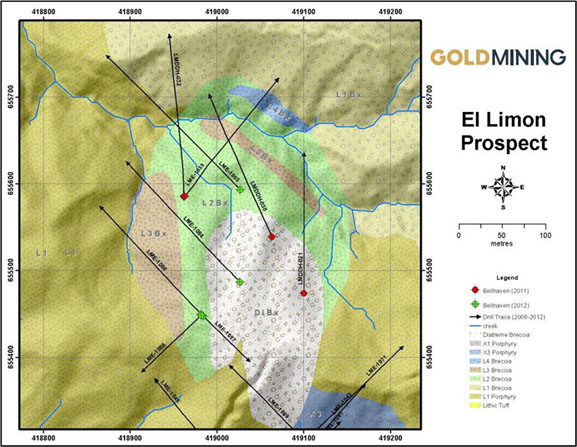
|
7.16 |
EL LIMON PROPSECT ALTERATION |
Alteration at the El Limon prospect is variable as at the other prospects. The L1 porphyry is for the most part, strongly overprinted by argillic alteration assemblages. Near its contact with the X3 porphyry it can exhibit weak-to-moderate biotite-magnetite alteration. Breccia clasts of L1 within the X3 porphyry typically exhibit moderate to strong relic biotite alteration. In the area of drill holes LMDDH-021 and -030, at considerable depth secondary potassium feldspar and magnetite and/or biotite are prevalent.
The L2 porphyry is moderately to strongly overprinted by propylitic assemblages with the development of considerable epidote-calcite patches and partial vein infill. Amphiboles are partially-to-completely replaced by a mix of epidote-calcite-magnetite. Where propylitic alteration is weak the original alteration of actinolite-magnetite prevails.
Secondary biotite alteration defines the L3 porphyry. The biotite is typically medium grained (1- 2 mm length) euhedral, and evenly distributed throughout the porphyry.
|
7.17 |
EL LIMON PROSPECT MINERALIZATION |
Gold-copper mineralization at El Limon is sporadic and associated with the L2 porphyry event and the strong potassic alteration (potassium feldspar-magnetite and biotite-magnetite) event cutting the L1 porphyry at depth in drill holes LMDDH-021 and 030. Mineralization in the potassic zones of LMDDH-021 and 030 is comprised of chalcopyrite disseminations in weakly developed quartz and quartz-magnetite veins. Mineralization in the L2 porphyry and associated L2 breccia of small amounts of chalcopyrite within quartz veins, quartz-magnetite veins, magnetite veins and fine-grained disseminations in the porphyry. Unfortunately, the L2 porphyry is small in extent and the Au-Cu grades observed are even much lower than the grades of the Middle Zone, typically in the 0.20 g/t Au range with less than 0.10% Cu. As a result, further exploration of the El Limon prospect is of low priority.
| Metal Mining Consultants Inc. Effective Date July 6, 2021 |
 |
| GoldMining Inc. NI 43-101 Report – La Mina Project |
Page 63 |
|
8 |
DEPOSIT TYPES |
The La Mina Property hosts copper-gold mineralization associated with sub-volcanic porphyry stocks intruding a late Miocene-age volcanic-sedimentary sequence of the Combia Formation. These rocks are related to an extensive magmatic arc that developed along the northern South American plate margin (the Chocó block margin).
Past and current exploration in and around the La Mina district has been aimed at Au-Cu porphyry, and/or epithermal Au styles of mineralization. In the specific cases of La Cantera Middle Zone, and La Garrucha the principal style of mineralization can be classified as Au-Cu porphyry.
Porphyry deposits are typically large low- or medium-grade deposits usually associated with a combination of gold, copper, plus other base metals. Porphyry deposits occur in a variety of tectonic settings; along the South American Andes Mountains they can be related to the roots of andesitic stratovolcanoes along subduction zones as well as continental-island arc settings. While some older examples of porphyries are known, most are associated with young, Tertiary-aged volcanic-igneous rocks. However, mineralization can extend into the surrounding sedimentary or volcanic host rocks.
Mineralization can occur in various styles and many combinations of disseminations, veins, stockwork, fractures, and breccias. As in the case of La Mina, multi-phase intrusions and inter-mineral phases are important factors in assessing porphyries, along with their wall-rock conditions, host rocks, structural conduits, and various chemical parameters (pH, water content, etc.).
A particular characteristic of porphyry deposits is the extent of their alteration halos as a result of abundant hydrothermal activity streaming from depth; these features in turn drive the applicable exploration methods for “vectoring” towards the center of this type of deposit. Therefore, geochemical surveys are a useful tool to map the large dispersion halos around the core porphyry center using stream sediments, soil sampling, or rock-chip sampling for the principal economic elements of interest or various pathfinder elements.
The dispersed nature of sulfide distribution is also conducive to the application of various geophysical methods, either ground-based or using fixed-wing or helicopter-borne instruments. Magnetics, Induced Polarization, and radiometric geophysical surveys can be successfully used to outline alteration dispersion patterns and have all been applied to varying degrees in exploring the La Mina Property.
Therefore, exploration at La Mina is focused on discovering porphyry-style mineralization using a wide set of exploration techniques for this style of deposit.
| Metal Mining Consultants Inc. Effective Date July 6, 2021 |
 |
| GoldMining Inc. NI 43-101 Report – La Mina Project |
Page 64 |
|
9 |
EXPLORATION |
Since acquiring an option on the Property in mid-2010 and until 2016, Bellhaven advanced exploration by conducting detailed mapping and trenching at La Cantera and Middle Zone, mapping and channel sampling at La Garrucha, mapping, rock-chip sampling and trenching throughout the project area, various ground geophysical surveys, and re-logging and re-interpretation of drill core from previous drilling campaigns. Furthermore, two airborne magnetic surveys have been flown over the La Mina Project at no cost to Bellhaven. AngloGold Ashanti flew the first survey and Colombia Crest flew the second in 2011. Ground magnetic follow-up surveys of geologically favorable areas was completed in mid-2012 and an airborne ZTEM survey was flown over much of the La Mina and La Garrucha licenses in late 2012. All of these data have been incorporated into the geophysical evaluation. Through July 2016, Bellhaven had completed a total of 106 drill holes for a total of 36,694 m. This drilling is summarized in Table 9.1. GoldMining has not conducted any additional exploration since acquiring Bellhaven in 2017.
Within the La Mina Project, there are a total of six zones of interest for copper-gold mineralization outlined in yellow in Figure 9.1. Three of these zones are at least partially drill tested and have combined geological, geochemical and geophysical attributes that suggest that they have potential to host economic gold-copper mineralization (La Cantera, Middle Zone, and La Garrucha). Another zone (El Limon) has been cut by 8 drill holes. Results of El Limon reported limited low grade Au-Cu mineralization but not of the size and tenor to warrant additional exploration. Two other prospects (El Oso and Media Luna) exhibit amenable geophysical and geochemical characteristics (Figure 9.1) and are also considered to be highly prospective.
Table 9‑1 Drilling Completed by Bellhaven at La Mina
|
Area |
Drill Holes |
Meters |
|
La Cantera |
26 |
8,327 |
|
Middle Zone |
54 |
18,803 |
|
El Limon |
9 |
2,923 |
|
La Garrucha |
17 |
6,641 |
| Metal Mining Consultants Inc. Effective Date July 6, 2021 |
 |
| GoldMining Inc. NI 43-101 Report – La Mina Project |
Page 65 |
Figure 9‑1 Exploration Targets at La Mina Project
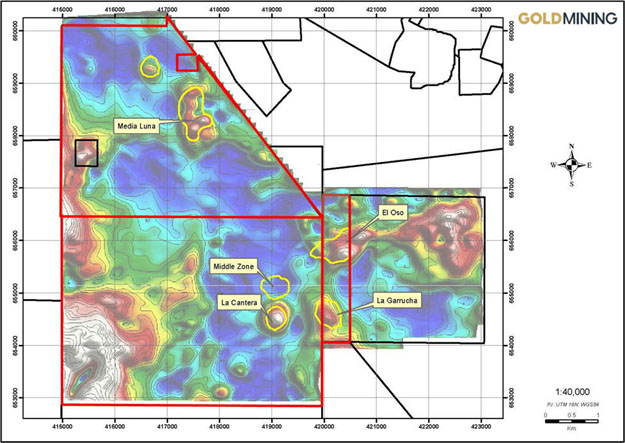
Bellhaven’s drilling programs have been carried out by Kluane Colombia SA, a subsidiary of the Canadian drill contractor Kluane Drilling Ltd. and for a short period of time in 2012 by Andina de Perforaciones S.A. also based in Colombia.
Prior to initiating its drill programs in 2010, Bellhaven completed channel sampling in trenches at Middle Zone where two surface exposures returned results of 19 m grading 0.73 g/t Au and 24 m grading 0.74 g/t Au (0.4 g/t Au cut off) separated by a zone of 40 m of unsampled trench.
In early 2012, a ground-based survey was conducted over the entire eastern half of La Mina. This program consisted of approximately 114-line kilometers of magnetic surveying and was carried out by KTTM Geophysics Limited, an independent geophysical contractor based in Medellin, Colombia.
Principal observations from correlation of the 2010 ground geophysics with geochemistry and geological features were:
|
● |
Anomalously high radiometrics (potassium) likely represents K-silicate (potassic) altered rocks. The high potassium values occur over a distance of 900 m along an approximately north-south trending corridor defined by the La Cantera-Middle Zone targets. High values also occur to the north at El Limon along an approximately east-west belt that is 500-m long. |
|
● |
High-chargeability zones fringing the drilled zones at La Cantera and Middle Zone can be attributed to rocks containing high quantities (typically 5-10 vol%) of pyrite. High-chargeability features are observed at La Cantera and Middle Zone. |
|
● |
The La Cantera stock spatially coincides with a strong resistivity “low” whereas the Middle Zone is characterized by a weakly defined “low”. Another prominent area characterized by a strong resistivity “low” occurs between the El Limon and Middle Zone targets. |
In summary, exploration of the La Mina Property has been carried out using a systematic combination of geology, geochemistry, and geophysics which has identified several anomalous zones of interest. To date four of these targets have been drilled: La Cantera, the Middle Zone, El Limon, and La Garrucha with 106 drill holes completed through July 2016. No additional drilling has been completed since that time.
| Metal Mining Consultants Inc. Effective Date July 6, 2021 |
 |
| GoldMining Inc. NI 43-101 Report – La Mina Project |
Page 66 |
Figure 9‑2 Magnetic Susceptibility Model at 100 m Depth. The Area of the Ground Magnetic Survey is the Red Box in Figure 6.1
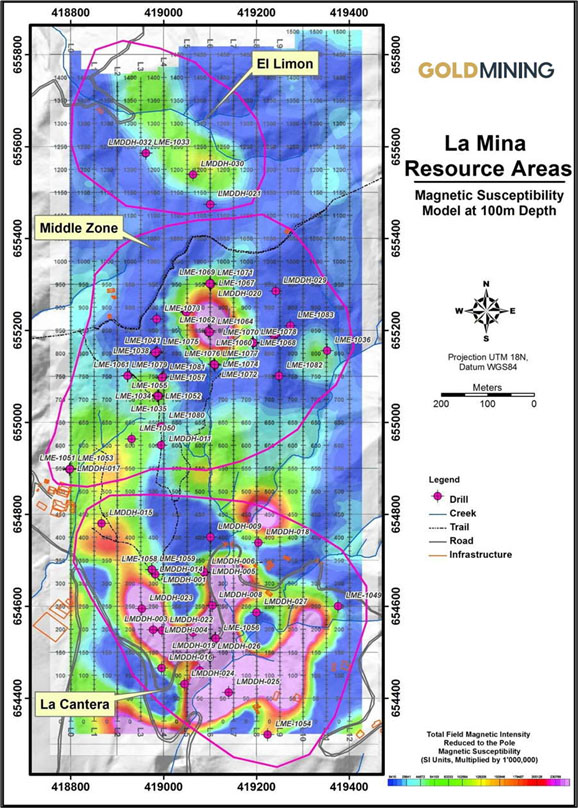
| Metal Mining Consultants Inc. Effective Date July 6, 2021 |
 |
| GoldMining Inc. NI 43-101 Report – La Mina Project |
Page 67 |
|
10 |
DRILLING |
Drilling programs by AngloGold Ashanti (2005) and Bellhaven in (2010- 2013) used HQ, HTW, NTW and BTW core, depending on the drill-hole depth, drill-hole inclination, drill machine availability and ground conditions. The author’s observations at site and review of core logs and assay certificates indicates that the core sampling has been carried out in a professional manner and that there are no biases in recovery or sampling error evident.
Core samples are collected on a nominal 2-m interval, except where occasional structures, core recovery, or lithological breaks are needed. Bellhaven completed a program of re-logging the early AGA holes. Re-logging of its own holes is ongoing as the current geological understanding evolves to acquire a more complete and accurate understanding of the geological lithologies and mineralization controls. Bellhaven’s logging procedure is thorough and includes recording of the following information:
|
● |
Sample Number, From – To. |
|
● |
Alteration Minerals: quartz, biotite, potassium feldspar, actinolite, albite, epidote, chlorite, sericite, calcite and clay. |
|
● |
Mineralization, volume %: chalcopyrite, bornite, chalcocite,pyrite, magnetite, limonite and goethite. |
|
● |
Vein Mineralization, volume %: quartz, quartz-magnetite, pyrite, magnetite-actinolite, anhydrite, and age relationships, etc. |
|
● |
Graphic Log of Alteration, Mineralization, Lithology, Structure, etc. |
|
● |
Alpha-numeric codes for lithology, structure and alteration (early, late and other) |
|
● |
Comments and short description of principal alteration associations, etc. |
A separate geotechnical log records fracture frequency, core recovery, Rock Quality Designation (RQD), and descriptions of fracture types and characteristics. A magnetic susceptibility meter has been in use throughout much of the program; the drill-core technicians collect a nominal three magnetic susceptibility readings per sample interval. The average value is recorded on the log form.
Beginning with drill hole LMDDH-019, core densities are determined approximately every 30 meters using a standard weight in air/weight in water technique. These readings are recorded on a separate log sheet and are entered into the database.
Core is photographed (2 boxes/photograph) in the condition that it is received from the drill site and then it is photographed again after the core has been logged, marked for sampling and cut.
A total of 36,695 m has been drilled on the La Mina Project from 106 core holes that have an average depth of 346.2 m.
|
10.1 |
LA CANTERA DRILLING |
The La Cantera deposit is intersected by a total of 26 diamond drill holes, the first six of which were drilled previous to Bellhaven’s efforts. Table 10.1 below summarizes the drilling locations and depths. For the La Cantera area, a total of 8,327 m have been drilled with an average of 320 m per hole. All drill hole collar locations are surveyed by GPS and identified with well-defined monuments (Figure 10.1). A summary of significant intercepts in drilling completed at La Cantera by Bellhaven (2010 through February 2012) is included in Table 10.2.
| Metal Mining Consultants Inc. Effective Date July 6, 2021 |
 |
| GoldMining Inc. NI 43-101 Report – La Mina Project |
Page 68 |
All drilling on the project by Bellhaven and previous owners has been done with man-portable, diamond drill-core machines. Drill-hole locations are initially located in the field with a hand-held GPS unit or a total station theodolite. Bellhaven’s full-time survey crew surveyed the coordinates of the final drill-hole collars using a total-station theodolite.
At the Middle Zone and La Cantera prospects drill holes have been drilled at azimuths of N45E, N45W and NS with inclinations of -55 to -90 degrees. In the case of La Cantera drilling was completed on a wide-spaced scissor pattern (50- to 100-m spacing) providing complete 3-dimensional coverage of the extent of mineralization that extends to a vertical depth of some 250-500 m (around the low-grade central core); see Figures 7.4 and 7.5 in Section 7.0.
At La Cantera drill holes were drilled at azimuths of E-W (90o), W-E (270o), N45E and S45W with inclinations of -50 to -78 degrees. Core recovery observed has been very good, in excess of 90%, except in some discrete fault-gouge zones of a few meters in length (core length).
In the case of La Cantera, the drilling programs confirmed the ellipsoidal outline of the porphyry complex on surface (coincident with the magnetic signature), its steep vertical attitude, and the occurrence of mineralized porphyry and breccia zones draped around a central low-grade core.
| Metal Mining Consultants Inc. Effective Date July 6, 2021 |
 |
| GoldMining Inc. NI 43-101 Report – La Mina Project |
Page 69 |
Figure 10‑1 La Mina Drill Collar Monuments
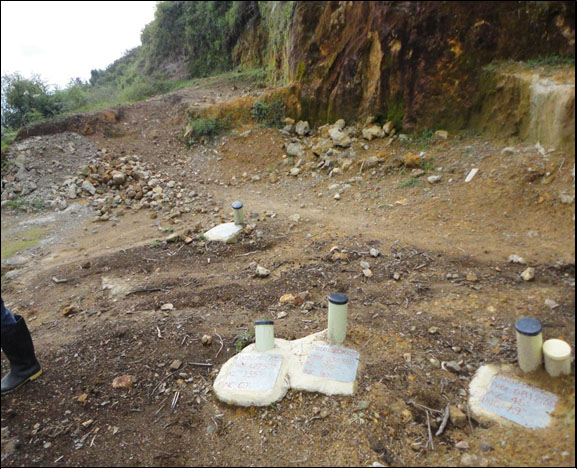
| Metal Mining Consultants Inc. Effective Date July 6, 2021 |
 |
| GoldMining Inc. NI 43-101 Report – La Mina Project |
Page 70 |
Table 10‑1 La Cantera Drilling - All Holes
|
Hole ID |
East (UTM) |
North (UTM) |
Elevation |
Azimuth |
Dip |
EOH |
|
LMDDH-001 |
418982.4 |
654669.3 |
1804.9 |
0 |
-60 |
258.2 |
|
LMDDH-002 |
419111.3 |
654529.9 |
1749.1 |
177 |
-59 |
188.6 |
|
LMDDH-003 |
418977.6 |
654548.4 |
1771.5 |
0 |
-61 |
200.2 |
|
LMDDH-004 |
419111.3 |
654530.3 |
1749.0 |
127 |
-60 |
250.0 |
|
LMDDH-005 |
419088.2 |
654673.0 |
1761.2 |
184 |
-60 |
251.6 |
|
LMDDH-006 |
419087.2 |
654674.4 |
1761.5 |
135 |
-60 |
303.9 |
|
LMDDH-007 |
419078.2 |
654460.4 |
1730.2 |
180 |
-60 |
125.0 |
|
LMDDH-008 |
419105.6 |
654601.6 |
1753.4 |
180 |
-60 |
297.2 |
|
LMDDH-009 |
419101.0 |
654750.0 |
1781.6 |
180 |
-60 |
434.3 |
|
LMDDH-014 |
418974.7 |
654680.1 |
1802.1 |
135 |
-50 |
511.7 |
|
LMDDH-015 |
418866.5 |
654780.1 |
1773.0 |
135 |
-55 |
639.8 |
|
LMDDH-016 |
418995.6 |
654465.4 |
1757.8 |
45 |
-58 |
517.0 |
|
LMDDH-018 |
419204.2 |
654738.3 |
1783.3 |
326 |
.62 |
213.4 |
|
LMDDH-019 |
419063.6 |
654542.6 |
1780.2 |
45 |
-57 |
320.0 |
|
LMDDH-022 |
418996.6 |
654547.2 |
1780.8 |
132 |
-59 |
286.7 |
|
LMDDH-023 |
418953.4 |
654594.3 |
1774.3 |
135 |
-65 |
365.8 |
|
LMDDH-024 |
419045.4 |
654430.6 |
1730.8 |
45 |
-55 |
436.8 |
|
LMDDH-025 |
419140.5 |
654412.3 |
1738.0 |
315 |
-55 |
305.4 |
|
LMDDH-026 |
419099.7 |
654489.1 |
1743.0 |
45 |
-55 |
294.1 |
|
LMDDH-027 |
419200.4 |
654586.6 |
1751.4 |
225 |
-60 |
419.1 |
|
LME-1049 |
419376.2 |
654600.0 |
1786.3 |
225 |
-55 |
501.8 |
|
LME-1054 |
419224.5 |
654320.5 |
1783.2 |
25 |
-55 |
483.4 |
|
LME-1056 |
419112.6 |
654529.4 |
1749.0 |
180 |
-60 |
163.4 |
|
LME-1058 |
418975.1 |
654679.5 |
1802.5 |
135 |
-50 |
68.0 |
|
LME-1059 |
418975.3 |
654680.1 |
1802.5 |
135 |
-50 |
196.6 |
|
LME-1099 |
419449.6 |
653513.8 |
1683.3 |
0 |
-90 |
295.35 |
| Metal Mining Consultants Inc. Effective Date July 6, 2021 |
 |
| GoldMining Inc. NI 43-101 Report – La Mina Project |
Page 71 |
Table 10‑2 La Cantera Deposit Significant Intercepts Through February 2012
|
Hole Number |
From (m) |
To (m) |
Intercept (m) |
Au (g/t) |
Cu (%) |
AuEq (g/t) |
|
LMDDH-07 |
7.6 |
27.9 |
20.3 |
0.74 |
0.40 |
1.43 |
|
LMDDH-08 |
0.7 |
88.0 |
87.3 |
1.07 |
0.30 |
1.59 |
|
LMDDH-08 |
197.1 |
269.7 |
72.7 |
0.88 |
0.39 |
1.55 |
|
LMDDH-09 |
194.8 |
337.2 |
142.4 |
0.70 |
0.29 |
1.20 |
|
LMDDH-14 |
100.0 |
246.0 |
146.0 |
0.93 |
0.33 |
1.51 |
|
LMDDH-14 |
392.0 |
454.0 |
62.0 |
0.75 |
0.38 |
1.40 |
|
LM-DDH-15 |
511.0 |
601.0 |
90.0 |
0.57 |
0.34 |
1.15 |
|
LMDDH-15 |
626.0 |
634.0 |
8.5 |
0.48 |
0.23 |
0.87 |
|
LMDDH-16 |
12.0 |
217.3 |
205.3 |
0.91 |
0.31 |
1.45 |
|
LMDDH-16 |
402.0 |
470.0 |
68.0 |
0.60 |
0.34 |
1.19 |
|
LMDDH-19 |
0.0 |
230.0 |
230.0 |
0.99 |
0.30 |
1.50 |
|
LMDDH-22 |
8.0 |
244.0 |
236.0 |
1.04 |
0.45 |
1.80 |
|
LMDDH-23 |
211.0 |
289.0 |
78.0 |
0.14 |
0.20 |
0.47 |
|
LMDDH-23 |
311.9 |
322.0 |
10.1 |
0.19 |
0.22 |
0.57 |
|
LMDDH-24 |
87.0 |
181.1 |
94.1 |
1.53 |
0.52 |
2.43 |
|
LMDDH-24 |
328.0 |
420.0 |
92.0 |
0.46 |
0.24 |
0.86 |
|
LMDDH-25 |
17.0 |
274.0 |
257.0 |
0.45 |
0.23 |
0.84 |
|
LMDDH-26 |
4.6 |
47.0 |
42.4 |
1.02 |
0.28 |
1.49 |
|
LMDDH-26 |
129.2 |
275.0 |
145.8 |
0.46 |
0.29 |
1.13 |
|
LMDDH-27 |
29.0 |
141.6 |
112.7 |
0.74 |
0.32 |
1.29 |
|
LMDDH-27 |
219.0 |
313.0 |
94.0 |
0.69 |
0.27 |
1.15 |
|
LME-1056 |
40.0 |
158.0 |
118.0 |
1.00 |
0.32 |
1.54 |
|
LME-1059 |
88.1 |
196.6 |
108.5 |
0.75 |
0.33 |
1.32 |
|
10.2 |
MIDDLE ZONE DRILLING |
The Middle Zone deposit resource is based on the intersections from a total of 54 diamond drill holes, all by Bellhaven. For the Middle Zone area, there have been a total of 18,803 m drilled with an average of 348 m per hole. This report is to update the resource model to include the 14 additional holes drilled after the previous report. Table 10.3 below gives the collar locations and starting azimuth and dip for each of these holes.
| Metal Mining Consultants Inc. Effective Date July 6, 2021 |
 |
| GoldMining Inc. NI 43-101 Report – La Mina Project |
Page 72 |
At the Middle Zone, 54 holes have been drilled to date within a generally elongated zone (N45E) in plan that is bounded on the western flank by interpreted faults. The Middle Zone remains open to the southwest, southeast, and at depth. The fault offsets and open targets on the south suggest a possible connection with La Cantera at depth. A summary of the significant intercepts in drilling completed in Middle Zone by Bellhaven which are used to update the resource estimate in this report, are given below in Table 10.4.
Table 10‑3 Middle Zone Collar Surveys
|
Hole ID |
East (UTM) |
North (UTM) |
Elevation |
Azimuth |
Dip |
EOH |
|
LMDDH-010 |
418985.0 |
655150.8 |
1940.1 |
180 |
-60 |
178.30 |
|
LMDDH-011 |
418995.0 |
654950.0 |
1869.7 |
0 |
-62 |
541.02 |
|
LMDDH-012 |
418999.2 |
655099.3 |
1907.7 |
45 |
-61 |
493.78 |
|
LMDDH-013 |
419098.0 |
655198.9 |
1928.0 |
45 |
-60 |
335.28 |
|
LMDDH-017 |
418797.1 |
654897.2 |
1772.9 |
45 |
-62 |
312.42 |
|
LMDDH-020 |
419101.1 |
655300.0 |
1958.2 |
179 |
-57 |
260.60 |
|
LMDDH-028 |
419238.3 |
655187.1 |
1971.2 |
180 |
-70 |
228.30 |
|
LMDDH-029 |
419241.9 |
655285.5 |
1998.7 |
180 |
-70 |
297.18 |
|
LMDDH-031 |
418989.1 |
655056.9 |
1887.5 |
0 |
-90 |
530.35 |
|
LME-1034 |
418990.1 |
655057.4 |
1887.6 |
45 |
-79 |
681.23 |
|
LME-1035 |
418990.2 |
655057.4 |
1887.6 |
45 |
-70 |
689.19 |
|
LME-1036 |
419352.6 |
655155.9 |
1913.1 |
225 |
-85 |
353.56 |
|
LME-1038 |
418985.5 |
655152.3 |
1940.3 |
135 |
-70 |
650.74 |
|
LME-1041 |
418986.4 |
655154.5 |
1940.7 |
45 |
-60 |
504.44 |
|
LME-1043 |
419048.8 |
655240.0 |
1932.1 |
45 |
-60 |
375.82 |
|
LME-1045 |
419047.4 |
655241.5 |
1932.5 |
315 |
-60 |
391.66 |
|
LME-1046 |
419047.6 |
655241.6 |
1932.5 |
0 |
-90 |
473.96 |
|
LME-1048 |
419049.5 |
655239.5 |
1932.0 |
135 |
-60 |
501.35 |
|
LME-1050 |
418931.5 |
654963.5 |
1815.1 |
45 |
-50 |
600.45 |
|
LME-1051 |
418798.7 |
654898.7 |
1773.0 |
45 |
-55 |
539.15 |
|
LME-1052 |
418986.9 |
655058.2 |
1887.5 |
315 |
-70 |
355.09 |
|
LME-1053 |
418798.5 |
654898.5 |
1773.0 |
45 |
-70 |
680.60 |
|
LME-1055 |
418988.7 |
655056.6 |
1887.5 |
135 |
-60 |
427.50 |
|
LME-1057 |
418996.6 |
655096.9 |
1909.3 |
225 |
-60 |
199.30 |
|
LME-1060 |
419096.7 |
655195.7 |
1926.1 |
225 |
-53 |
195.40 |
|
LME-1061 |
418923.3 |
655102.0 |
1881.7 |
45 |
-60 |
199.64 |
|
LME-1062 |
419096.9 |
655199.1 |
1926.2 |
315 |
-55 |
198.00 |
|
LME-1063 |
419237.4 |
655192.6 |
1971.1 |
315 |
-60 |
250.24 |
|
LME-1064 |
419100.1 |
655196.0 |
1926.3 |
135 |
-55 |
198.50 |
|
LME-1065 |
419239.9 |
655190.2 |
1971.2 |
135 |
-52 |
251.46 |
|
LME-1066 |
419241.1 |
655192.9 |
1971.4 |
45 |
-60 |
190.50 |
|
LME-1067 |
419102.2 |
655299.8 |
1958.3 |
135 |
-60 |
260.30 |
|
LME-1068 |
419191.8 |
655174.3 |
1931.4 |
315 |
-70 |
204.21 |
|
LME-1069 |
419101.4 |
655302.9 |
1958.8 |
315 |
-60 |
235.30 |
| Metal Mining Consultants Inc. Effective Date July 6, 2021 |
 |
| GoldMining Inc. NI 43-101 Report – La Mina Project |
Page 73 |
| Hole ID | East (UTM) |
North (UTM) |
Elevation | Azimuth | Dip | EOH |
|
LME-1070 |
419193.7 |
655172.3 |
1931.4 |
135 |
-52 |
245.36 |
|
LME-1071 |
419099.2 |
655302.2 |
1959.5 |
45 |
-55 |
293.10 |
|
LME-1072 |
419108.6 |
655126.9 |
1894.9 |
325 |
-45 |
225.55 |
|
LME-1073 |
418985.5 |
655224.8 |
1952.6 |
135 |
-52 |
307.20 |
|
LME-1074 |
419110.9 |
655124.0 |
1895.1 |
135 |
-70 |
303.27 |
|
LME-1075 |
418982.3 |
655151.7 |
1940.2 |
225 |
-50 |
236.10 |
|
LME-1076 |
419110.0 |
655125.7 |
1894.9 |
225 |
-50 |
39.62 |
|
LME-1077 |
419110.2 |
655125.8 |
1895.0 |
225 |
-65 |
153.92 |
|
LME-1078 |
419193.0 |
655173.4 |
1931.7 |
225 |
-50 |
422.09 |
|
LME-1079 |
418922.5 |
655101.4 |
1880.5 |
315 |
-50 |
147.82 |
|
LME-1080 |
418995.3 |
654991.7 |
1868.1 |
335 |
-60 |
188.36 |
|
LME-1081 |
418998.9 |
655098.6 |
1906.9 |
135 |
-50 |
292.60 |
|
LME-1082 |
419248.7 |
655100.0 |
1939.2 |
315 |
-50 |
322.78 |
|
LME-1083 |
419273.9 |
655231.9 |
1973.8 |
135 |
-50 |
208.78 |
|
LME-1089 |
418694.0 |
655043.5 |
1793.8 |
135 |
-51 |
297.18 |
|
LME-1090 |
418797.4 |
654904.1 |
1774.2 |
45 |
-64 |
596.79 |
|
LME-1091 |
418798.0 |
654902.3 |
1773.4 |
135 |
-50 |
548.94 |
|
LME-1092 |
418796.7 |
654905.4 |
1773.6 |
0 |
-48 |
446.53 |
|
LME-1093 |
418975.7 |
654683.3 |
1801.6 |
45 |
-51 |
400.81 |
|
LME-1094 |
419318.3 |
654805.1 |
1856.2 |
45 |
-65 |
341.07 |
Table 10‑4 Middle Zone deposit Drilling Subsequent to the 2012 Resource
|
Hole Number |
From (m) |
To (m) |
Intercept (m) |
Au (g/t) |
Cu (%) |
AuEq (g/t) |
|
LME-1075 |
95.60 |
109.90 |
14.30 |
0.51 |
0.15 |
0.76 |
|
LME-1075 |
120.40 |
126.10 |
5.70 |
0.95 |
0.18 |
1.27 |
|
LME-1075 |
132.40 |
157.80 |
25.40 |
0.41 |
0.06 |
0.51 |
|
LME-1076 |
19.50 |
24.38 |
4.88 |
0.29 |
0.07 |
0.41 |
|
LME-1076 |
30.48 |
39.62 |
9.14 |
0.26 |
0.24 |
0.67 |
|
LME-1077 |
12.19 |
65.53 |
53.34 |
0.33 |
0.21 |
0.69 |
|
LME-1078 |
16.76 |
27.43 |
10.67 |
0.73 |
0.06 |
0.84 |
| LME-1079 | No Significant Results | |||||
|
LME-1080 |
66.75 |
101.19 |
34.44 |
0.69 |
0.10 |
0.86 |
|
136.55 |
179.26 |
42.71 |
0.72 |
0.08 |
0.85 |
|
|
LME-1081 |
48.76 |
64.00 |
15.24 |
0.39 |
0.11 |
0.58 |
|
LME-1082 |
107.43 |
129.54 |
22.11 |
0.72 |
0.08 |
0.85 |
|
and |
138.68 |
254.50 |
115.82 |
1.01 |
0.08 |
1.15 |
|
including |
138.68 |
202.00 |
63.32 |
1.48 |
0.09 |
1.63 |
| LME-1083 | No Significant Results | |||||
| LME-1089 | No Significant Results | |||||
|
LME-1090 |
530.58 |
548.70 |
18.12 |
0.34 |
0.30 |
0.81 |
| LME-1091 | No Significant Results | |||||
| LME-1092 | No Significant Results | |||||
| LME-1093 | No Significant Results | |||||
| Metal Mining Consultants Inc. Effective Date July 6, 2021 |
 |
| GoldMining Inc. NI 43-101 Report – La Mina Project |
Page 74 |
|
10.3 |
LA GARRUCHA DRILLING |
The La Garrucha deposit resource is known for the intersections of 17 diamond drill holes. In La Garrucha area, there have been a total of 6,641 m drilled with an average of 391-m per hole. Table 10.5 is a summary of these holes and their location. A summary of the significant drill-core intercepts for La Garrucha prospect is provided in Table 10.6.
Table 10‑5 La Garrucha Drill Holes Location and Depth
|
Hole ID |
East (UTM) |
North (UTM) |
Elevation |
Azimuth |
Dip |
EOH |
|
LME-1037 |
419822.24 |
654598.62 |
2008.49 |
90 |
-70 |
380.08 |
|
LME-1039 |
419822.39 |
654598.45 |
2008.76 |
0 |
-90 |
509.93 |
|
LME-1040 |
419833.15 |
654703.30 |
2013.51 |
90 |
-70 |
355.09 |
|
LME-1042 |
419833.33 |
654703.11 |
2013.54 |
0 |
-90 |
391.66 |
|
LME-1044 |
419832.58 |
654702.80 |
2013.41 |
45 |
-70 |
502.92 |
|
LME-1047 |
419833.73 |
654703.22 |
2011.88 |
90 |
-60 |
242.31 |
|
LME-1095 |
419840.83 |
654507.20 |
1994.24 |
45 |
-51 |
280.11 |
|
LME-1096 |
419830.11 |
654667.6 |
2007.10 |
0 |
-90 |
349.81 |
|
LME-1097 |
419830.11 |
654667.56 |
2007.17 |
90 |
-65 |
349.81 |
|
LME-1098 |
419829.85 |
654415.93 |
1981.45 |
90 |
-70 |
360.27 |
|
LME-1100 |
419873.03 |
654308.13 |
1980.78 |
45 |
-65 |
297.18 |
|
LME-1101 |
420026.27 |
654714.28 |
1961.06 |
225 |
-75 |
414.52 |
|
LME-1102 |
420026.62 |
654716.92 |
1961.05 |
270 |
-76 |
422.45 |
|
LME-1103 |
420026.34 |
654715.66 |
1961.15 |
225 |
-60 |
320.04 |
|
LME-1104 |
419940.21 |
654620.09 |
1990.95 |
45 |
-75 |
565.40 |
|
LME-1105 |
420194.53 |
654811.87 |
2004.27 |
225 |
-55 |
614.17 |
|
LME-1106 |
420004.19 |
654621.40 |
1954.82 |
225 |
-68 |
285.59 |
Table 10‑6 La Garrucha Significant Drill Core Intercepts
|
Hole Number |
From (m) |
To (m) |
Intercept (m) |
Au (g/t) |
Cu (%) |
AuEq (g/t) |
|
LME-1037 |
359.00 |
374.10 |
15.10 |
0.49 |
0.08 |
0.62 |
| LME-1039 | No Significant Results | |||||
|
LME-1040 |
161.00 |
169.00 |
8.00 |
0.30 |
0.18 |
0.60 |
|
192.00 |
210.50 |
18.50 |
0.35 |
0.17 |
0.64 |
|
|
258.00 |
355.09 |
97.09 |
0.35 |
0.14 |
0.60 |
|
| LME-1042 | No Significant Results | |||||
|
LME-1044 |
269.10 |
281.94 |
12.84 |
12.84 |
0.09 |
0.99 |
|
LME-1047 |
119.50 |
1239.54 |
10.04 |
0.55 |
0.31 |
1.08 |
|
154.00 |
172.40 |
18.40 |
0.31 |
0.15 |
0.57 |
|
|
178.25 |
242.31 |
64.06 |
0.55 |
0.15 |
0.80 |
|
|
LME-1095 |
248.20 |
280.11 |
31.91 |
0.47 |
0.09 |
0.81 |
|
LME-1096 |
199.64 |
282.00 |
82.36 |
0.48 |
0.17 |
0.76 |
|
LME-1096 |
322.96 |
349.81 |
26.85 |
0.64 |
0.13 |
0.85 |
| LME-1097 | No Significant Results | |||||
| LME-1098 | No Significant Results | |||||
|
LME-1100 |
99.06 |
107.28 |
8.22 |
0.51 |
0.08 |
0.62 |
| Metal Mining Consultants Inc. Effective Date July 6, 2021 |
 |
| GoldMining Inc. NI 43-101 Report – La Mina Project |
Page 75 |
| Hole Number | From (m) | To (m) |
Intercept (m) |
Au (g/t) | Cu (%) | AuEq (g/t) |
|
143.00 |
359.80 |
216.80 |
1.31 |
0.15 |
1.55 |
|
|
379.00 |
397.76 |
18.76 |
0.59 |
0.09 |
0.74 |
|
|
LME-1101 |
94.87 |
174.95 |
80.08 |
0.49 |
0.06 |
0.57 |
|
216.71 |
253.59 |
36.88 |
0.45 |
0.03 |
0.49 |
|
|
278.58 |
374.50 |
95.92 |
0.50 |
0.13 |
0.73 |
|
|
LME-1102 |
7.62 |
13.71 |
6.09 |
0.71 |
0.03 |
0.76 |
|
19.81 |
25.90 |
6.09 |
0.53 |
0.03 |
0.57 |
|
|
52.30 |
60.40 |
8.10 |
0.40 |
0.26 |
0.80 |
|
|
66.50 |
224.62 |
158.12 |
1.01 |
0.17 |
1.26 |
|
|
242.00 |
278.00 |
36.00 |
0.34 |
0.13 |
0.54 |
|
|
LME-1103 |
66.00 |
377.00 |
311.00 |
0.84 |
0.10 |
1.00 |
|
392.80 |
421.20 |
28.40 |
0.34 |
0.04 |
0.41 |
|
|
436.77 |
458.30 |
21.53 |
0.41 |
0.04 |
0.48 |
|
|
476.09 |
537.80 |
61.70 |
0.56 |
0.04 |
0.62 |
|
|
Lme-1104 |
236.50 |
268.00 |
31.50 |
0.44 |
0.11 |
0.60 |
|
355.00 |
426.00 |
71.00 |
1.02 |
0.14 |
1.24 |
|
|
485.65 |
592.25 |
106.60 |
0.56 |
0.11 |
0.72 |
|
|
LME-1105 |
0.00 |
145.00 |
145.00 |
0.51 |
0.15 |
0.73 |
|
168.60 |
200.25 |
31.65 |
0.38 |
0.04 |
0.44 |
|
|
LME-1106 |
38.10 |
50.29 |
12.19 |
0.43 |
0.07 |
0.54 |
|
171.00 |
441.96 |
270.96 |
1.03 |
0.13 |
1.23 |
|
10.4 |
EL LIMON DRILLING |
The El Limon deposit resource is known from the intersections of 9 diamond drill holes. For the El Limon area, there have been a total of 2923 m drilled with an average of 325 m per hole. Table 10.7 is a summary of these holes and their location. A summary of the significant drill-holes intercepts for the El Limon prospect are found below in Table 10.8.
Table 10‑7 El Limon Drill Holes and Locations
|
Hole ID |
East (UTM) |
North (UTM) |
Elevation |
Azimuth |
Dip |
EOH |
|
LMDDH-021 |
419100.48 |
655474.02 |
1974.88 |
0 |
-63 |
359.66 |
|
LMDDH-030 |
419063.61 |
655539.21 |
1970.59 |
335 |
-60 |
381.00 |
|
LMDDH-032 |
418961.77 |
655585.57 |
1949.54 |
0 |
-60 |
414.52 |
|
LME-1033 |
418962.60 |
655585.98 |
1949.45 |
45 |
-68 |
461.77 |
|
LME-1084 |
419026.66 |
655487.08 |
1986.53 |
315 |
-55 |
333.75 |
|
LME-1085 |
419026.95 |
655593.22 |
1917.00 |
315 |
-55 |
353.56 |
|
LME-1086 |
418981.98 |
655450.14 |
1994.02 |
315 |
-51 |
284.98 |
|
LME-1087 |
418984.24 |
655447.90 |
1993.80 |
135 |
-65 |
181.35 |
|
LME-1088 |
418981.84 |
655448.59 |
1994.04 |
225 |
-50 |
152.70 |
| Metal Mining Consultants Inc. Effective Date July 6, 2021 |
 |
| GoldMining Inc. NI 43-101 Report – La Mina Project |
Page 76 |
Table 10‑8 El Limon Significant Drill Intercepts
|
Hole Number |
From (m) |
To (m) |
Intercept (m) |
Au (g/t) |
Cu (%) |
AuEq (g/t) |
|
LMDDH-021 |
283.00 |
359.66 |
76.66 |
0.24 |
0.02 |
0.28 |
|
LMDDH-030 |
38.00 |
247.00 |
209.00 |
0.19 |
0.07 |
0.33 |
|
LMDDH-032 |
4.57 |
44.26 |
39.69 |
0.19 |
0.05 |
0.27 |
|
LMDDH-033 |
9.14 |
365.00 |
355.86 |
0.15 |
0.04 |
0.22 |
|
LME-1084 |
117.34 |
196.29 |
78.95 |
0.31 |
0.10 |
0.47 |
|
234.39 |
283.46 |
49.07 |
0.36 |
0.11 |
0.53 |
|
|
LME-1085 |
18.28 |
60.65 |
42.37 |
0.24 |
0.12 |
0.43 |
|
LME-1086 |
154.22 |
175.80 |
21.58 |
0.31 |
Nil |
0.32 |
| LME-1087 | No Significant Values | |||||
| LME-1088 | No Significant Values | |||||
|
10.5 |
TRENCHING |
Since acquiring the Property in 2010, Bellhaven completed several continuous trenches over the La Cantera and Middle Zone targets. Samples were collected as channels from surface outcrop using hammer and maul, or hand-held pneumatic hammer. Trenches vary in length from 20 m to 50+ m and are generally oriented E-W. 256 trench samples were provided. These samples averaged 0.22 g/t Au and had 58 samples that were valued above 0.3 g/t Au. None of these trenches in the Middle Zone has been incorporated into the resource estimate, but are used in determination of new exploration targets.
|
10.6 |
ROCK SAMPLING AND SOIL GEOCHEMISTRY |
Bellhaven also augmented and significantly extended the original soil and rock-chip sampling done by AGA. Ending July 2012, Bellhaven took a total of 491 rock-chip samples and 4779 soil samples. The rock-chip samples had an average of 0.03 g/t Au with 14 samples of higher than 0.3 g/t Au assays. The soil samples had an average of 0.02 g/t Au with 35 samples of higher that 0.3 g/t Au assays. None of the rock-chip samples or the soil samples were used in the mineral resource estimation.
| Metal Mining Consultants Inc. Effective Date July 6, 2021 |
 |
| GoldMining Inc. NI 43-101 Report – La Mina Project |
Page 77 |
|
11 |
SAMPLE PREPARATION, ANALYSES, AND SECURITY |
Samples from Bellhaven’s exploration and development drilling programs were cut (using a core saw) or split (using a core splitter). The instrument used depends on the level of clay content, in which high clay samples are split to avoid core loss from the core saw’s lubricating water. The cut or split samples are stored in a secure core shed on site until they are shipped to the ALS Minerals sample preparation facility in Bogota (through LMDDH-023) or Medellin (all samples from LMDDH-024 to present), Colombia. The samples were prepared at the ALS Minerals sample preparation facilities and then sent to the ALS Minerals regional analytical facility in Lima, Peru. Samples for check assays are prepared at the SGS facility in Medellin, Colombia, and analyzed at the SGS laboratory in Lima, Peru.
At the La Mina Project site, a field office and employee housing complex are located within walking distance of the La Cantera and Middle Zone prospects. All core from the AngloGold Ashanti (AGA) drill program is stored on site along with all core from Bellhaven’s own drilling programs. A new core shed was constructed in 2011 and has a two-tier core rack system. The pulps, splits, and rejects of prepared samples are currently being transferred directly from the preparation labs to a warehouse rented by Bellhaven in Medellin. Pulps, splits, and rejects currently at La Mina are gradually being moved to the Medellín facility in order to free up space for core to be generated in future drill programs.
The core sample procedure begins with checking of driller-placed core blocks for accuracy followed by photographs of consecutive pairs of core boxes. The core then undergoes detailed geotechnical and geological logging. Data recorded in geotechnical and geological logs are entered into the project database using a two-person parallel input protocol. Technicians identify the nominal 2-m sample intervals with wooden core blocks and mark the length of the core with a “cut line” to guide the core cutting. The technicians take care not to mix intervals of significantly different core recovery in the same sample, resulting in some sample intervals that are shorter than the nominal length. All core boxes (metal) are clearly tagged with hole ID and from/to information.
Core marked for sampling was cut or split by Bellhaven technicians (under geological supervision) using a standard electric masonry core saw mounted on a secure steel stand or by a manual Longyear core splitter. Standard safety equipment (hard hat, ear plugs and eye protection) are used by the core cutters and their helpers. The half-core is placed in plastic bags and tagged with a sample number marked on the outside of the bag and a corresponding sample tag inside the bag. Each bag is securely closed. The unused cut half of the core is then placed back in its correct place in the core box and stored for later reference. Blanks (5%), standards (5-12% depending on the nature of the material), preparation duplicates (5%) and field duplicates (2%) are inserted in the sample stream during this stage.
Regular drill-core samples are collected in lots of 25–76 and shipped by company vehicle to ALS Minerals for preparation and analysis. Early in the drilling program samples were dispatched to the ALS preparation laboratory in Bogota. However in early 2011 with the addition of an ALS preparation facility in Medellin, samples are dispatched directly to ALS in Medellin for preparation and then forward by ALS to the ALS laboratory in Lima, Peru. Beginning in early 2013 (La Garrucha drill holes LME-1100 to LME-1106) core samples were dispatched to Actlabs Colombia in Rio Negro, Colombia for preparation and analysis. As noted, several QA/QC steps are included in sample preparation. At the preparation facility each sample is coarse crushed to 70% less than 2 mm size. A 1kg split of each sample is routinely pulverized to 85% passing 75 μms. A final pulp of 250-300 g is sent for analysis to the ALS Minerals laboratory in Lima.
| Metal Mining Consultants Inc. Effective Date July 6, 2021 |
 |
| GoldMining Inc. NI 43-101 Report – La Mina Project |
Page 78 |
Gold, copper, and ICP analyses at the ALS Minerals Lima lab are carried out as follows:
|
● |
Gold: Fire Assay, 50/30 g charge, Atomic Absorption finish |
|
● |
Over-range (>10ppm) results for gold are analyzed by Fire Assay with a Gravimetric finish. |
|
● |
Copper and other elements: 4-acid digestion and ICP-AES analysis, including Cu, Ag, Al, As, Ba, Be, Bi, Ca, Co, Cr, Fe, Ga, K, La, Mg, Mn, Mo, Na, Ni, P, Pb, S, Sc, Sr, Th, Ti, Tl, U, V, W and Zn. |
The ALS Minerals laboratory in Lima, Peru is registered to ISO 9001:2008 and has received ISO 17025:2005 accreditation for certain specific methods, such as fire assay/AA gold.
The Actlabs Colombia laboratory in Rio Negro, Colombia is ISO 9001 certified and provides the company with significant turn-around-time on its drill core analyses as the result of a combined preparation and analytical facility in Colombia. Analytical preparation and procedures for gold fire assay and base and trace metal ICP-AES analysis is identical to that of ALS and SGS.
Check assay samples are collected in lots of varying size and shipped by company vehicle to the SGS laboratory in Medellin for preparation, then forwarded by SGS/ALS to the analytical facility in Lima, Peru. At the preparation facility, each sample is coarse crushed to 95% less than 2 mm size. The final sample is pulverized to 95% passing 105 μms, and approximately 250 gr is sent to the analytical lab.
Gold, copper, and ICP analyses at the SGS Lima lab are carried out as follows:
|
● |
Gold: Fire Assay, 30 g charge, Atomic Absorption finish |
|
● |
Over-range (>3 g/t) results for gold are analyzed by 30 g, Fire Assay with a Gravimetric finish |
|
● |
Copper and other elements: 4-acid digestion and ICP-AES analysis, including Cu, Ag, Al, As, Ba, Be, Bi, Ca, Co, Cr, Fe, Ga, K, La, Mg, Mn, Mo, Na, Ni, P, Pb, S, Sc, Sr, Th, Ti, Tl, U, V, W and Zn |
The SGS laboratory in Lima, Peru, has received accreditation to ISO/IEC 17025:2006 for mineral assay procedures. The preparation laboratory in Medellin is registered to ISO 9001:2008 for storage and preparation of samples.
|
11.1 |
STANDARD, BLANK, AND DUPLICATE SAMPLES |
Bellhaven commenced its Quality Assurance – Quality Control (QA-QC) program with its first hole, LMDDH-007. The system involved regular insertion of blanks, standards, and duplicates into the sample stream. Coarse and pulp duplicates are included in the protocol. In addition, approximately 10% of all samples are sent to the SGS laboratory in Lima as part of a check assay program. Certified reference materials (CRMs), including blanks and standards, were purchased from two Canadian suppliers, WCM Minerals in Burnaby British Columbia and CDN Laboratories in Burnaby, British Columbia. These include the following CRMs: blanks numbered BL110, BL111, BL112, BL113, BL115 and standards numbered CGS27, CM13, CM14, CU156, CU157, CU158, CU159, CU164, CU175, CU185, PM434, PM436, PM438, PM446 and PM447. The standards cover low, medium, and high grades monitored within +/- 2 standard deviations around the certified mean value of each.
| Metal Mining Consultants Inc. Effective Date July 6, 2021 |
 |
| GoldMining Inc. NI 43-101 Report – La Mina Project |
Page 79 |
The results of the analyses on the CRM’s are included in this report. In all cases, the charts are annotated with the name of the reference material and the certified values for the elements of interest (the copper series of reference materials) as determined by WCM/CDN shown in the yellow box. The individual analyses are noted by the blue/black markers. The certified or accepted value is the solid black/blue line. Lines indicating ±2 and ±3 standard deviations (Std. Dev.) are shown by the dashed green and red lines, respectively. The number of determinations, mean, and standard deviation for all of the analyses are shown in the top right-hand corner of the graph. The 3rd standard deviation was chosen as a limit for acceptable deviation from the certified means. This is currently the industry standard for both certified standards and blanks.
The information shown below is specific to the Middle Zone resource (from LMDDH-010 onward).
|
11.1.1 |
STANDARD RESULTS |
Fifteen standards were used in Middle Zone drilling (Figures 11.1 through 11.25), distributed randomly but with consideration for the size of assay lots. By and large, the results were consistent with expected results for both gold and copper. Out of 500 measurements for Au, only one fell outside of the allowable 3 standard deviations. Out of 300 Cu measurements, only 10 fell outside of the allowable 3 standard deviations.
Using 2 standard deviations departure from the accepted value as a benchmark, only 13 Au determinations and 34 Cu determinations were outside an acceptable range.
Figure 11‑1 Reference Material CU156 Performance for Au
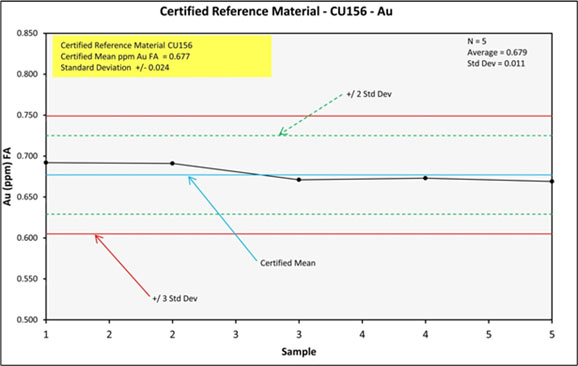
| Metal Mining Consultants Inc. Effective Date July 6, 2021 |
 |
| GoldMining Inc. NI 43-101 Report – La Mina Project |
Page 80 |
Figure 11‑2 Reference Material CU157 Performance for Au
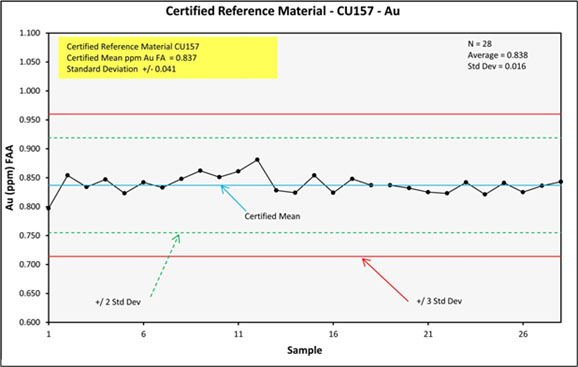
Figure 11‑3 Reference Material CU158 Performance for Au
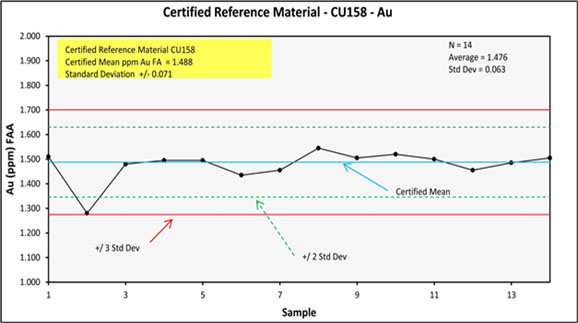
| Metal Mining Consultants Inc. Effective Date July 6, 2021 |
 |
| GoldMining Inc. NI 43-101 Report – La Mina Project |
Page 81 |
Figure 11‑4 Reference Material CU159 Performance for Au
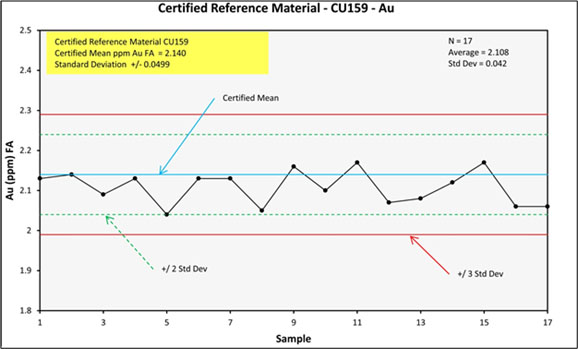
Figure 11‑5 Reference Material CU164 Performance for Au
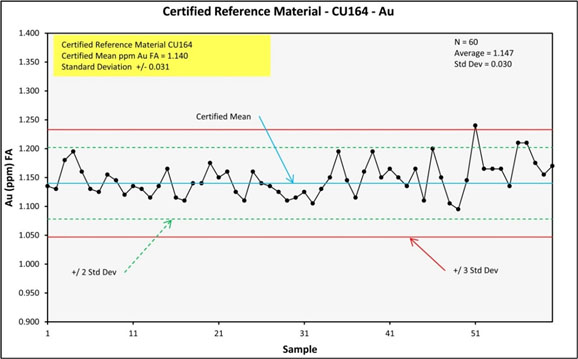
| Metal Mining Consultants Inc. Effective Date July 6, 2021 |
 |
| GoldMining Inc. NI 43-101 Report – La Mina Project |
Page 82 |
Figure 11‑6 Reference Material CU175 Performance for Au
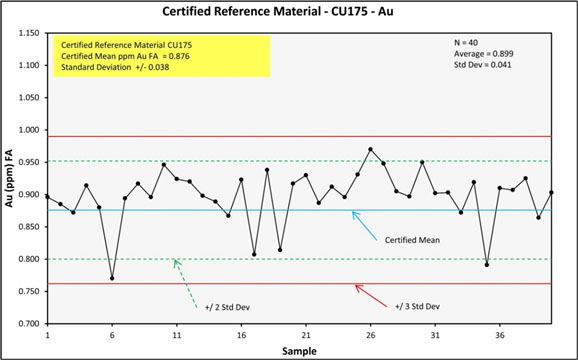
Figure 11‑7 Reference Material CU184 Performance for Au

| Metal Mining Consultants Inc. Effective Date July 6, 2021 |
 |
| GoldMining Inc. NI 43-101 Report – La Mina Project |
Page 83 |
Figure 11‑8 Reference Material CM13 Performance for Au
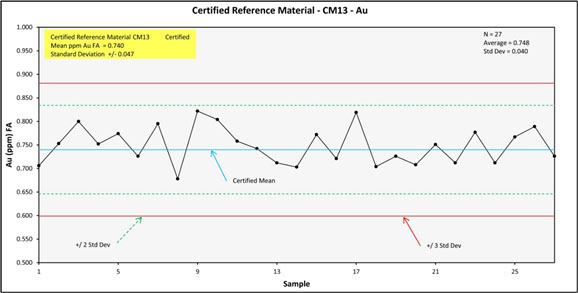
Figure 11‑9 Reference Material CM14 Performance for Au
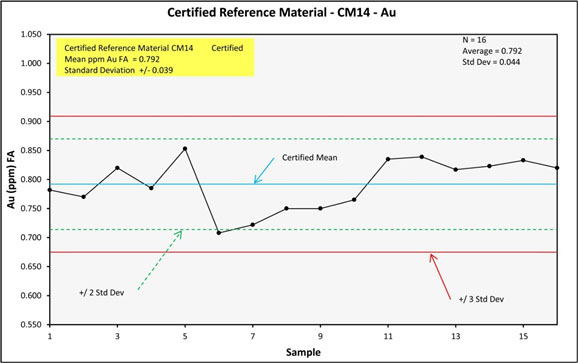
| Metal Mining Consultants Inc. Effective Date July 6, 2021 |
 |
| GoldMining Inc. NI 43-101 Report – La Mina Project |
Page 84 |
Figure 11‑10 Reference Material CGS27 Performance for Au
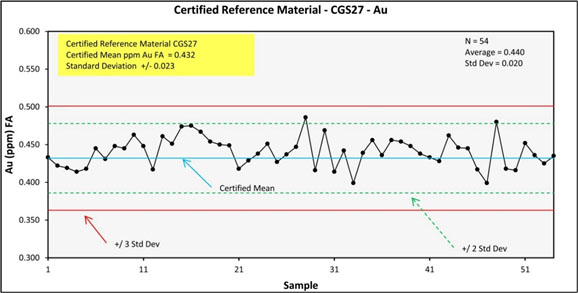
Figure 11‑11 Reference Material PM434 Performance for Au
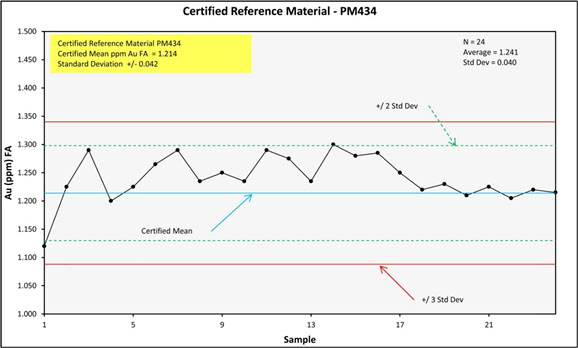
| Metal Mining Consultants Inc. Effective Date July 6, 2021 |
 |
| GoldMining Inc. NI 43-101 Report – La Mina Project |
Page 85 |
Figure 11‑12 Reference Material PM436 Performance for Au
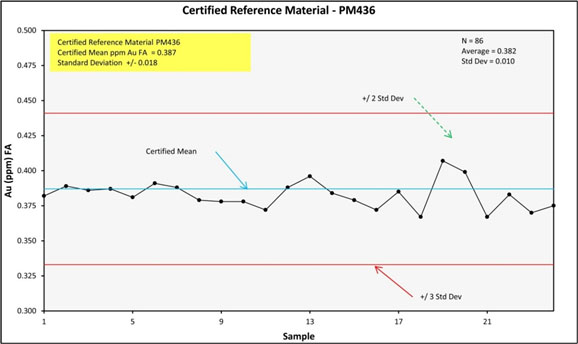
Figure 11‑13 Reference Material PM438 Performance for Au
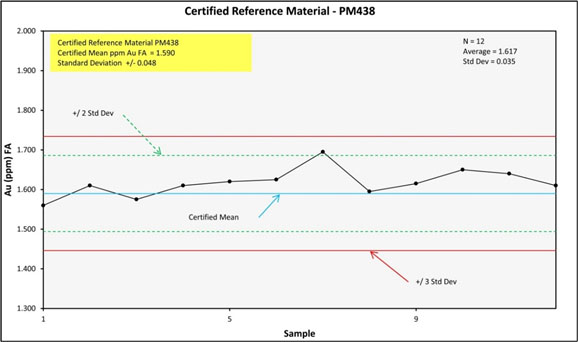
| Metal Mining Consultants Inc. Effective Date July 6, 2021 |
 |
| GoldMining Inc. NI 43-101 Report – La Mina Project |
Page 86 |
Figure 11‑14 Reference Material PM446 Performance for Au
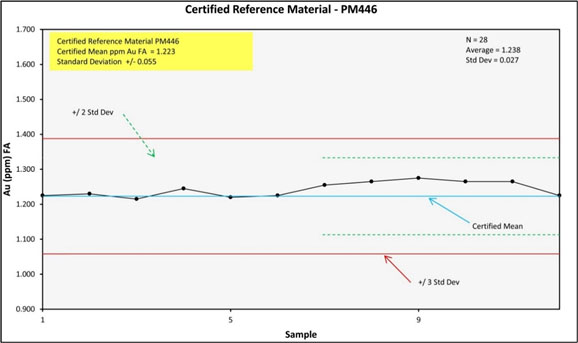
Figure 11‑15 Reference Material PM447 Performance for Au
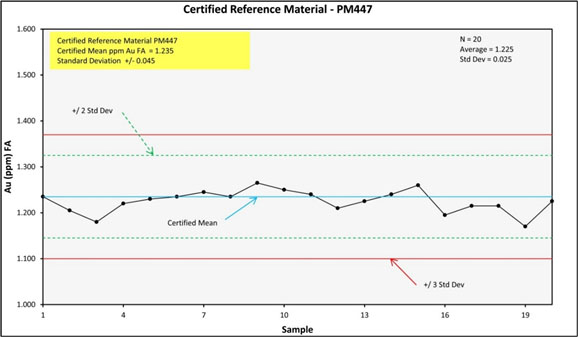
| Metal Mining Consultants Inc. Effective Date July 6, 2021 |
 |
| GoldMining Inc. NI 43-101 Report – La Mina Project |
Page 87 |
Figure 11‑16 Reference Material CU156 Performance for Cu
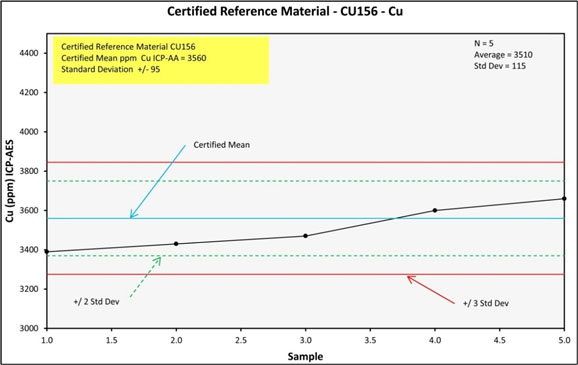
Figure 11‑17 Reference Material CU157 for Cu
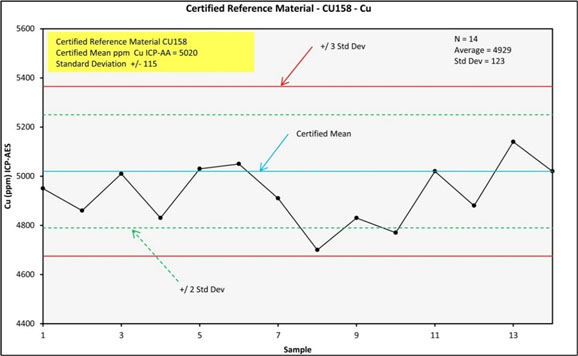
| Metal Mining Consultants Inc. Effective Date July 6, 2021 |
 |
| GoldMining Inc. NI 43-101 Report – La Mina Project |
Page 88 |
Figure 11‑18 Reference Material CU158 Performance for Cu
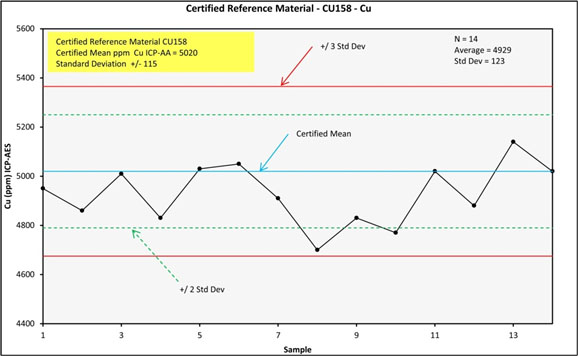
Figure 11‑19 Reference Material CU159 Performance for Cu
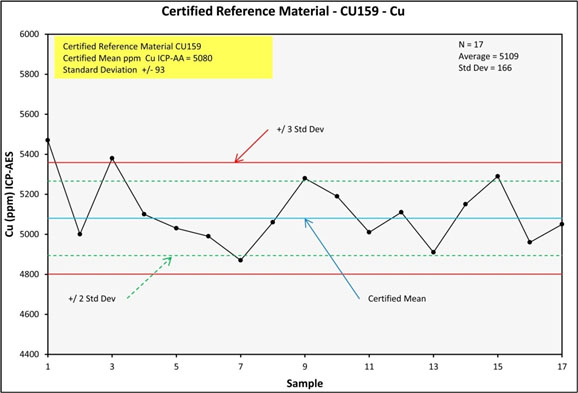
| Metal Mining Consultants Inc. Effective Date July 6, 2021 |
 |
| GoldMining Inc. NI 43-101 Report – La Mina Project |
Page 89 |
Figure 11‑20 Reference Material CU164 Performance for Cu
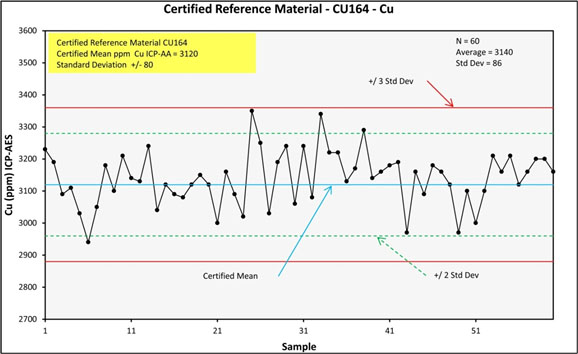
Figure 11‑21 Reference Material CU175 Performance for Cu

| Metal Mining Consultants Inc. Effective Date July 6, 2021 |
 |
| GoldMining Inc. NI 43-101 Report – La Mina Project |
Page 90 |
Figure 11‑22 Reference Material CU184 Performance for Cu
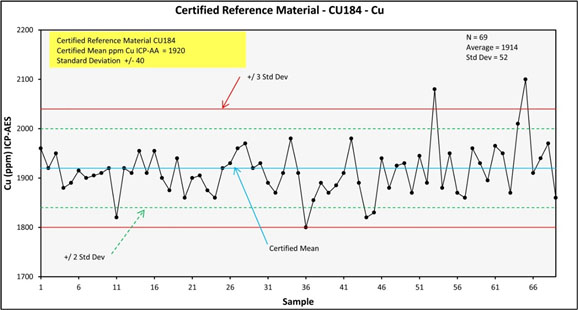
Figure 11‑23 Reference Material CM13 Performance for Cu
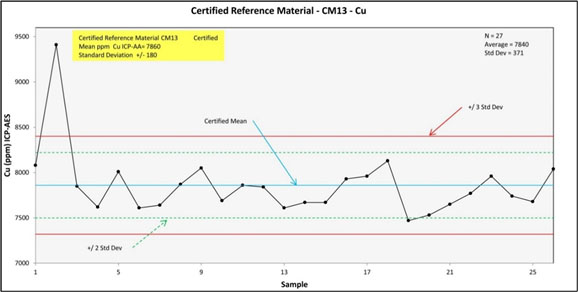
| Metal Mining Consultants Inc. Effective Date July 6, 2021 |
 |
| GoldMining Inc. NI 43-101 Report – La Mina Project |
Page 91 |
Figure 11‑24 Reference Material CM14 Performance for Cu
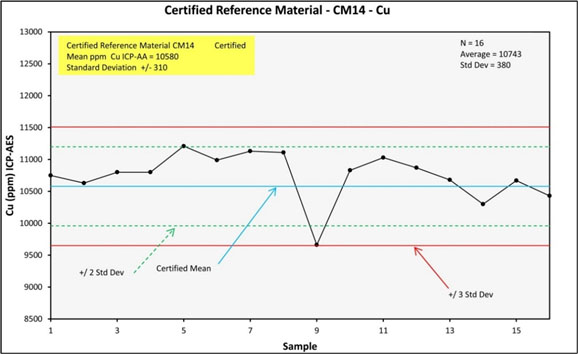
Figure 11‑25 Reference Material CGS27 Performance for Cu
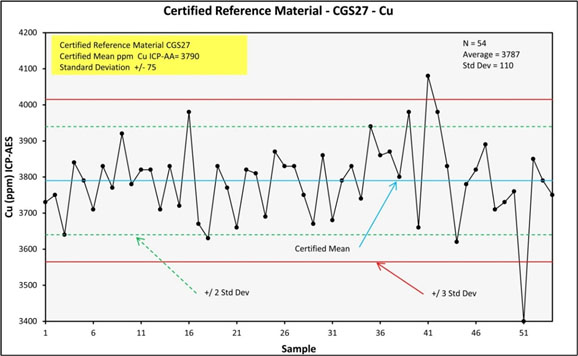
| Metal Mining Consultants Inc. Effective Date July 6, 2021 |
 |
| GoldMining Inc. NI 43-101 Report – La Mina Project |
Page 92 |
|
11.1.2 |
BLANK RESULTS |
Five standard blanks were used in the Middle Zone (Figures 11.26-11.35 below). The gold results were again very good, with only six samples out of a total of 258 exceeding the 3rd standard deviation line. Copper also performed well in most cases, with 38 out of 258 samples falling outside of the 3rd standard deviation. Of these failures, just under half are at levels that fall well within ten times the copper reporting limit and therefore are not significant from a statistical standpoint. There are a few cases where review is warranted; and the Company is following up on this. BL110 and BL111 have statistically significant busts (three and two successive samples, respectively), and BL115 shows a number of busts that will be reviewed. Such a failure rate for certified blank materials is well within industry norms.
Figure 11‑26 Reference Material - Blank BL110 Performance for Au
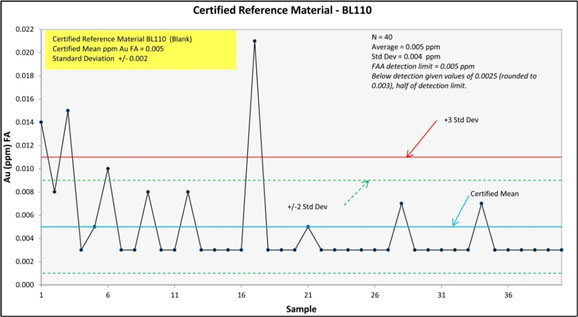
Figure 11‑27 Reference Material - Blank BL111 Performance for Au

| Metal Mining Consultants Inc. Effective Date July 6, 2021 |
 |
| GoldMining Inc. NI 43-101 Report – La Mina Project |
Page 93 |
Figure 11‑28 Reference Material - Blank BL112 Performance for Au
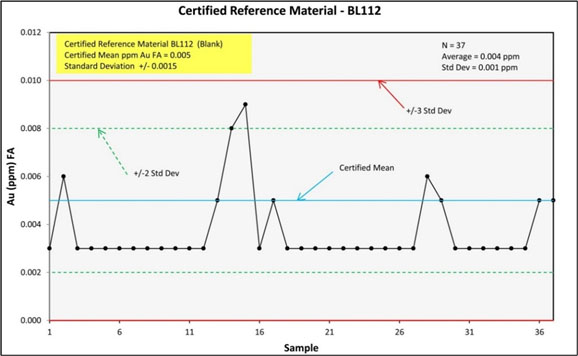
Figure 11‑29 Reference Material - Blank BL113 Performance for Au
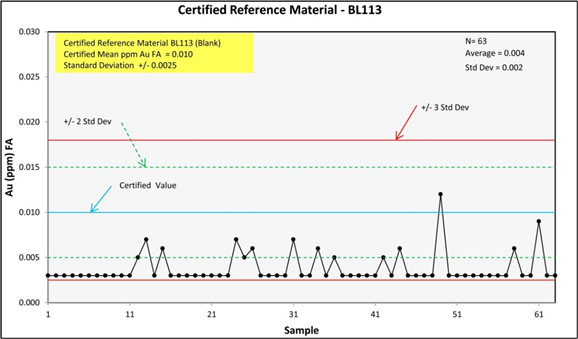
| Metal Mining Consultants Inc. Effective Date July 6, 2021 |
 |
| GoldMining Inc. NI 43-101 Report – La Mina Project |
Page 94 |
Figure 11‑30 Reference Material - Blank BL115 Performance for Au
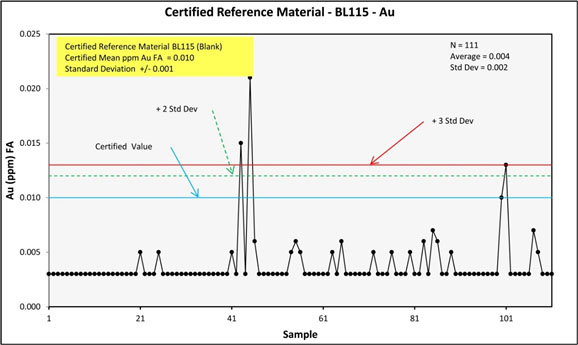
Figure 11‑31 Reference Material - Blank BL110 Performance for Cu
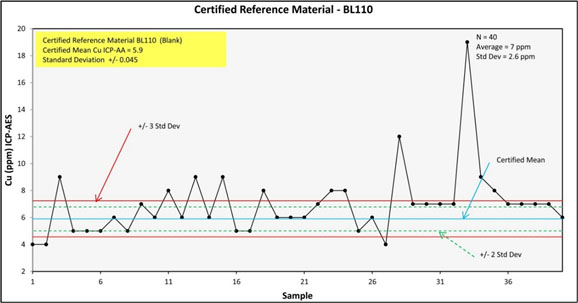
| Metal Mining Consultants Inc. Effective Date July 6, 2021 |
 |
| GoldMining Inc. NI 43-101 Report – La Mina Project |
Page 95 |
Figure 11‑32 Reference Material - Blank BL111 Performance for Cu
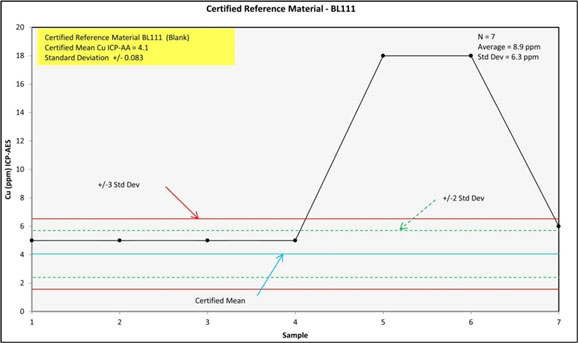
Figure 11‑33 Reference Material - Blank BL112 Performance for Cu
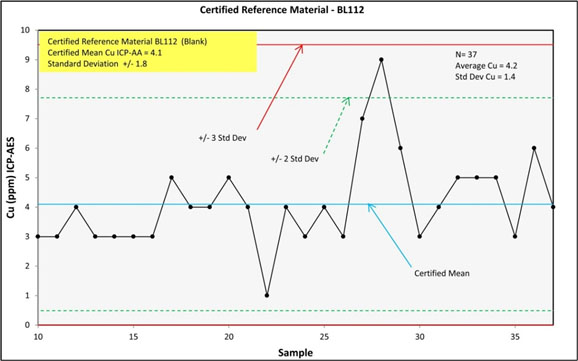
| Metal Mining Consultants Inc. Effective Date July 6, 2021 |
 |
| GoldMining Inc. NI 43-101 Report – La Mina Project |
Page 96 |
Figure 11‑34 Reference Material - Blank BL113 Performance for Cu
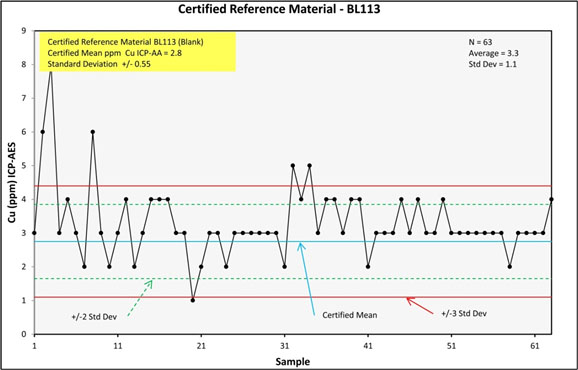
Figure 11‑35 Reference Material - Blank BL115 Performance for Cu
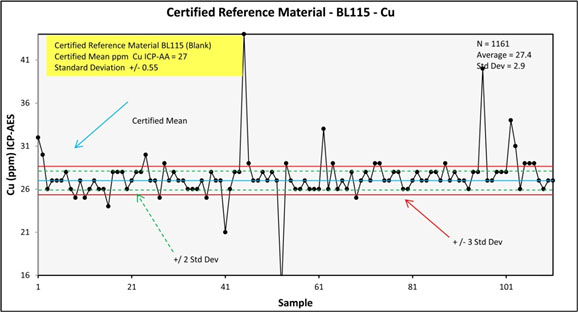
| Metal Mining Consultants Inc. Effective Date July 6, 2021 |
 |
| GoldMining Inc. NI 43-101 Report – La Mina Project |
Page 97 |
|
11.1.3 |
DUPLICATE TYPES AND RESULTS |
Three duplicate sample types are routinely generated during sampling of drill core at La Mina:
|
● |
Field duplicates are generated on-site at La Mina. Subsequent to sawing and packing half of the core as per normal sampling, an additional ¼ of the remaining core is cut and sent under a different sample number. |
|
● |
Coarse duplicates are generated at the preparation lab in Medellin. It is a split of the original coarse crush, which is relabeled and processed through pulverization. |
|
● |
Pulp duplicates are generated at the preparation lab in Medellin. It is a split of the final pulverized sample, which is relabeled and sent to the analytical lab. |
The Middle Zone coarse, pulp, and field duplicates were collected in the following frequency on a hole-by-hole basis: 1% globally of all sampled intervals, 1.5% of samples assaying near cutoff grades for gold (0.3 g/t), and 2.5% for all intervals assaying above gold cutoff. In total, 164 coarse duplicates, 165 pulp duplicates, and 63 field duplicates were analyzed. There is excellent agreement between the coarse and pulp duplicates, and nearly all fall within the 10% range. The results are shown graphically in Figures 11.36-11.41 below.
Figure 11‑36 Au Analyses (FA AA) for Preparation Duplicate Samples
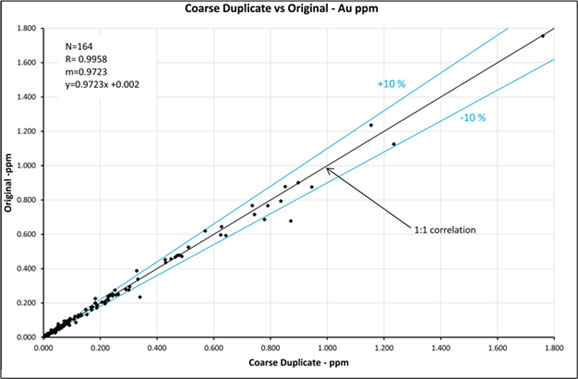
| Metal Mining Consultants Inc. Effective Date July 6, 2021 |
 |
| GoldMining Inc. NI 43-101 Report – La Mina Project |
Page 98 |
Figure 11‑37 Au Analyses (FA AA) for Preparation Duplicate Samples

Figure 11‑38 Au Analyses (FA AA) for Preparation Duplicate Samples
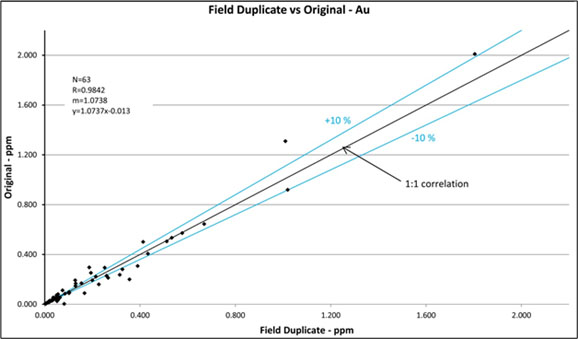
| Metal Mining Consultants Inc. Effective Date July 6, 2021 |
 |
| GoldMining Inc. NI 43-101 Report – La Mina Project |
Page 99 |
Figure 11‑39 Cu Analyses (ICP-AES) for Preparation Duplicate Samples
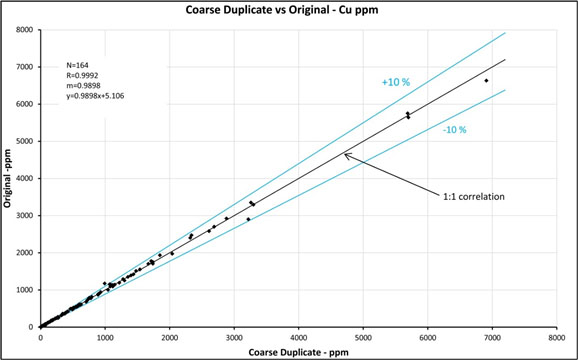
Figure 11‑40 Cu Analyses (ICP-AES) for Preparation Duplicate Samples
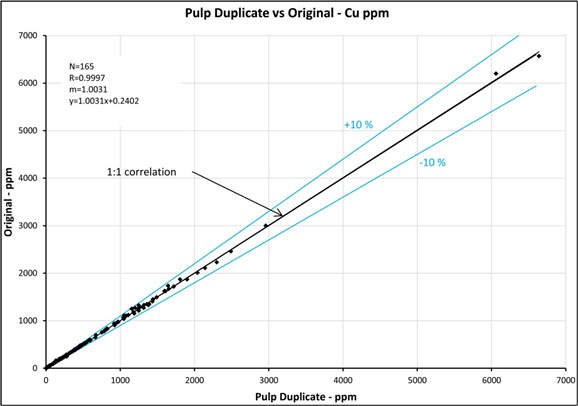
| Metal Mining Consultants Inc. Effective Date July 6, 2021 |
 |
| GoldMining Inc. NI 43-101 Report – La Mina Project |
Page 100 |
Figure 11‑41 Cu Analyses (ICP-AES) for Preparation Duplicate Samples
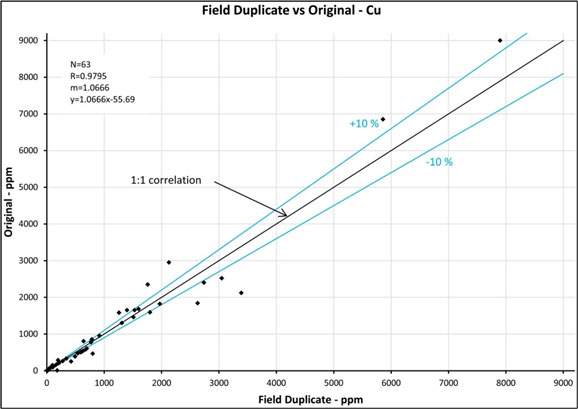
|
11.2 |
INDEPENDENT CHECK ASSAY PROGRAM |
Bellhaven conducted a check assay study for the Middle Zone resource to accompany the standards, blanks, and duplicates program. Company geologists selected a suite of samples based on geological and grade variation for assay by a fully independent laboratory in order to further validate the resource and investigate possible laboratory or method bias. The first phase of this study is complete, with the second phase pending. The initial phase involved 70 check samples sent from intervals in 13 Middle Zone drill holes, distributed through a range of grades, alteration types, and intensities of weathering. The check assay value (reported by SGS) was compared with the original value for both gold and copper (originating from ALS Laboratories). The check value is considered acceptable if it falls within 10% of the original value, according to the following formula:
Absolute value| (original value – check value) | / (average of values) < 10%.
Of the 70 check samples for Middle Zone completed to date, only three gold values were flagged as failing the above formula (Figure 11.42). In one case, the check value was higher than the original value. No values fell outside acceptable limits for copper (Figure 11.43). Four certified standards and blanks were inserted into the sample set, all of which fell within acceptable ranges.
For the three gold exceptions, re-check samples were sent to ALS Laboratories with different sample numbers. In each case, the two closest values were chosen and the outlier discarded. The two values were then subjected to the above formula to assure that they fell into the same compliance criteria. In all three cases acceptable values were obtained. These accepted values were then averaged and entered into the database (Figure 11.44). Two certified standards and two blanks were inserted into the sample set, all of which fell within acceptable ranges.
| Metal Mining Consultants Inc. Effective Date July 6, 2021 |
 |
| GoldMining Inc. NI 43-101 Report – La Mina Project |
Page 101 |
As an additional check, three to five samples from intervals close to each flagged re-check sample were re-assayed for gold. Out of 12 samples, all but one fell within acceptable check assay limits, and the one non-compliant value was greater in the re-check than the original. These are included in Figure 11.44.
Figure 11‑42 Original vs Check Sample Comparison for Middle Zone - Au
The Blue Dotted lines are +/- 10% from the Mean
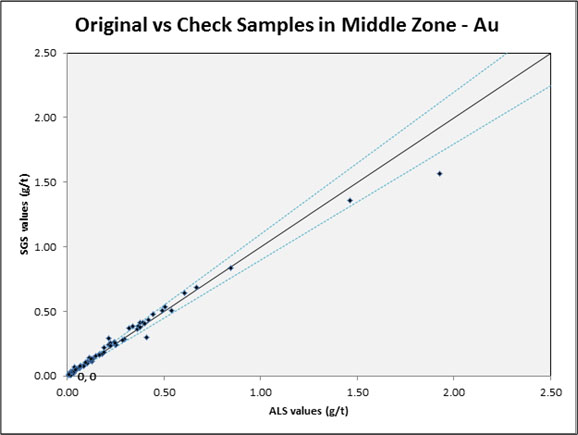
| Metal Mining Consultants Inc. Effective Date July 6, 2021 |
 |
| GoldMining Inc. NI 43-101 Report – La Mina Project |
Page 102 |
Figure 11‑43 Original vs Check Sample Comparison for Middle Zone - Cu
The Blue Dotted Lines are +/- 10% from the Mean
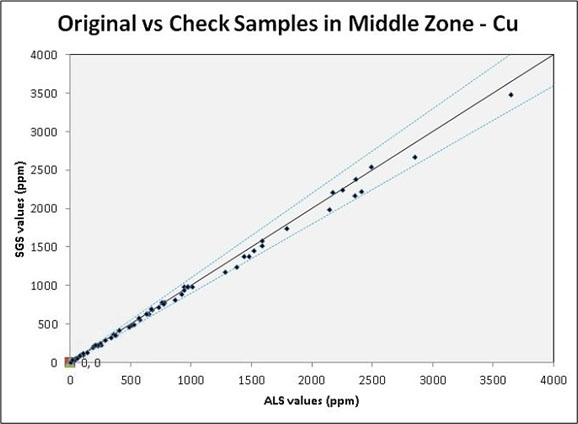
| Metal Mining Consultants Inc. Effective Date July 6, 2021 |
 |
| GoldMining Inc. NI 43-101 Report – La Mina Project |
Page 103 |
Figure 11‑44 Original Assays vs Rechecks - with Outliers Rejected
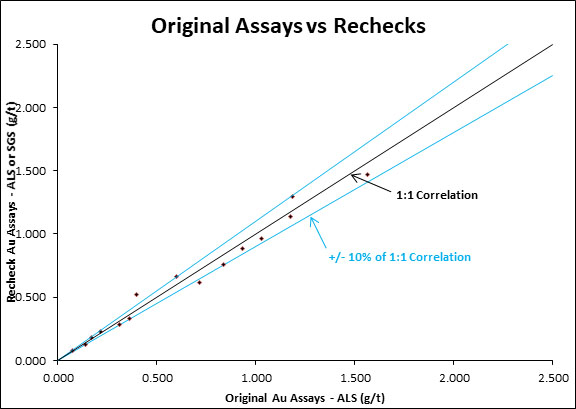
|
11.3 |
SUMMARY OF QA/QC PROGRAM |
Bellhaven’s QA/QC program consisted of certified standards, blanks, two types of lab duplicates and one type of field duplicate, as well as a check assay program involving a second analytical laboratory. The accuracy of the assays for gold and copper appears to be very good, as measured by the performance of analytical control samples. The repeatability or precision of the assay data for both copper and gold, as measured by duplicate and replicate assays, is also well within industry norms. Furthermore, the confirmation by an independent lab of gold and copper values for a selected suite of Middle Zone samples further enhances the credibility of the data. The fact that two accredited laboratories produced data that are so highly correlative is significant. Taken in its entirety, the quality assurance program from the Middle Zone deposit confirms that the data are of sufficient quality to support this resource calculation.
The methodology used to monitor the quality control during the drilling at the La Mina Project also exceeds industry norms. Company geologists routinely compare quality control data against certified values. The data and charts presented here document the follow-up assessment that occurs on the relatively rare occasions when values are returned that fall outside industry guidelines for quality. When assays for standards exceed certified values by more than 3 standard deviations, Bellhaven has investigated and addressed the concerns. Similarly when replicates or duplicates disagree by more than 10%, one can see follow-up analyses in the database. Hence, a complete review of the quality control data and Company practices tends to boost confidence in the assay data that are the building blocks of the resource models.
| Metal Mining Consultants Inc. Effective Date July 6, 2021 |
 |
| GoldMining Inc. NI 43-101 Report – La Mina Project |
Page 104 |
The quality control data for Middle Zone gold assays is particularly strong. Standards and blanks show almost no significant outliers beyond the 3rd standard deviation from certified values (one out of 500 cases for standards, 6 out of 258 cases for blanks). Even using the more stringent 2nd standard deviation, a relatively insignificant number of values were flagged (13 out of 500 cases for standards, 9 out of 258 cases for blanks). As documented above, many of the failures on blanks occurred at concentrations less than 10x the lower reporting limit of the method. At these low levels, an analytical method is much less reliable as precision is very high. The data from standards and blanks for gold indicate acceptable accuracy and do not identify any major episodes of contamination in the lab.
Gold assays from the coarse and pulp duplicates show good correlation and nearly all fall within ±10% of a 1:1 correlation. Since Company geologists collected data on duplicates at the crushing and pulverizing stages of sample preparation, we can see from the above data that there are no major problems with sub-sampling of the Middle Zone samples for gold. This level of agreement is well beyond industry norms. This type of duplicate data suggests that the sample prep laboratory is performing well, the geological materials pose no extraordinary challenges, and the precision of the analytical data is within expectations.
As expected, the field duplicates show significantly more scatter in the gold assays than laboratory duplicates do. It is important to see an improvement in duplicate performance from field duplicates to coarse lab duplicates. GoldMining geologists should review the methodology for field duplicates in order to ensure equitable assessments of sampling error for future sampling programs. Using a +20% precision envelope, we can see that most gold duplicates group nicely. Given that this comparison is between half core (original) and quarter core (duplicate) taken at the core saw, such correlation is certainly acceptable. It is recommended that future field duplicates be of comparable mass and volume, so the geologists should select either equal quarter core splits or half core splits.
The independent lab check assay program also results in good agreement between gold in the data sets, with only three sample pairs out of 70 differing by more than 10%. Subsequent re-check samples on these three cases (with a number of surrounding samples being checked) resulted in assay pairs with acceptable precision. The confirmation of the tenor of mineralization from an independent laboratory provides added confidence. The ongoing comparison between independent labs will also provide a fallback position from which to evaluate drift or bias over time. This will become important as the resource is upgraded to potentially economic measured & indicated categories.
The quality control results for copper are also very good. While, there may be some subtle evidence of drifting bias at low concentration ranges in the laboratory method, the overall accuracy and precision of the copper data are sufficient to support this resource calculation.
Regarding the copper results for the analytical control samples and blanks, only 10 out of 330 standard determinations fell outside the 3rd standard deviation from the accepted copper values. The copper values in most certified blanks fell below the acceptable maximum values, but there were numerous failures at low concentration ranges (less than 10x the lower reporting limit for copper). The total number of failures was 38 out of 258 samples. The failures occurred with three certified blanks (BL110, BL111, and BL115). In the first two cases, the successive failures are limited in duration and do not suggest a prolonged problem at the lab. In the case of BL115, the number of successive busts does warrant a more detailed review. Analytical failures of low-level standards or blanks could indicate contamination or some sort of drift in calibration at the low end of a method’s operational range.
| Metal Mining Consultants Inc. Effective Date July 6, 2021 |
 |
| GoldMining Inc. NI 43-101 Report – La Mina Project |
Page 105 |
To evaluate this apparent systematic trend noted in the copper blanks and standards, Figure 11.45 below arranges both standard and blank failures by analysis date. The chart tracks the specific cases of failure of standards and blanks when compared against a conservative two standard deviations threshold. Percentage failure (y-axis) is defined as the percentage of the standard or blank measurement over (or under) the threshold value for that specific standard or blank. The chart excludes the majority of standards and blank measurements, since these fell within the above thresholds. Note that from the beginning of Middle Zone drilling in August 2010 to September 2011, there is a consistent positive bias to the copper results. The curve is almost bell shaped with its apex occurring in March 2011. The bias appears to neutralize or perhaps become weakly negative from September 2011 to mid-March 2012, possibly returning to a subtle positive bias thereafter.
Figure 11‑45 Changes in the Magnitude of Difference between Standards and Blanks for Copper Plotted against Date of Analysis
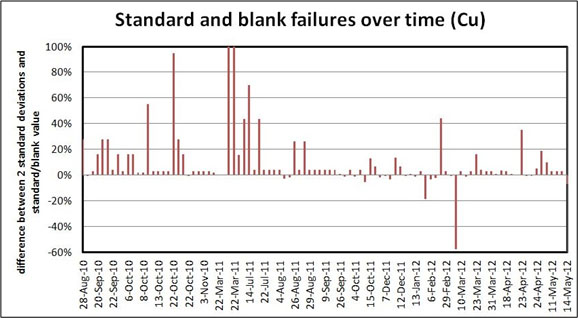
If confirmed, this pattern could indicate some kind of drift in the copper baseline assay results. Contamination could also play a part in the positive bias, but it may be difficult to confirm that. However, it is important to point out that most of these failures occur at very low levels – well below the average grade of the Middle Zone resource. For that reason, it is unlikely that the apparent drift in low level copper values that may be in evidence here would have any material effect on these mineral resources.
As with gold, pulp and coarse duplicates for copper show good correlation, while the field duplicates show a significantly larger spread. Using the 10% precision envelope, the chart shows only one failure of a coarse duplicate at higher copper concentrations. The pulp duplicates perform even better. Again, having data for both coarse and pulp duplicates build confidence that there are no significant sub-sampling problems for copper with the Middle Zone samples.
The field duplicates do show more scatter, suggesting that sampling error increases when dealing with geological materials in the field. However, as the coefficient of correlation remains high and the scatter is largely contained with a + 20% precision envelope, the sampling variability at Middle Zone is well in line with expectations. Improved consistency may result from collecting consistent quarter core samples for field duplicates in the future.
The two independent laboratories confirm the levels of copper mineralization based on the check assay program so far. The agreement between the two labs was excellent, with no values out of 70 pairs flagged outside the + 10% precision envelope for samples containing at least 500 ppm copper.
| Metal Mining Consultants Inc. Effective Date July 6, 2021 |
 |
| GoldMining Inc. NI 43-101 Report – La Mina Project |
Page 106 |
|
12 |
DATA VERIFICATION |
With 106 holes completed by Bellhaven and other previous owners, complemented by various and extensive surface geochemistry in streams, soils, and bedrock, the author concludes that an industry-standard program of QA-QC appropriate to the early-stage of exploration has been in place for most if not all of this work.
Since taking an option on the property and until 2016, the Bellhaven sampling and assaying programs were controlled by a systematic application of certified standards and blanks, along with Bellhaven’s own field duplicate and laboratory duplicate checks. The use of an independent international preparation and assay laboratory, ALS Chemex, adds additional assurance that assay results are representative of the mineralization encountered on the property.
As an additional verification and check on the overall level of copper-gold grades reported for the porphyry mineralization at La Mina, the author independently collected samples from drill core representing the current drill programs. The samples were collected by Mr. Wilson or under Mr. Wilson’s supervision in the case of selecting half-core for quartering by saw cutter.
This verification sampling is intended only as a check of the general level of copper-gold mineralization found at La Mina, but is not intended as a comprehensive QA-QC assessment for the purposes of resource estimation.
The results of the check assays compared to the Bellhaven originals are within acceptable precision. GoldMining put no limitations on the author’s review of the exploration site.
During the authors’ site visit, logging procedures, sample collection and preparation procedures were reviewed.
|
12.1 |
ASSAY CERTIFICATE AND DRILL HOLE DATABASE VALIDATION |
Five percent (157) random sample intervals from the 3,082 intervals in the GoldMining drill-hole database were selected for validation. The results were compared to the assay lab certified assay values that were in the database. No discrepancies were identified between the two data sources. It was noticed that when the assay reported on the certificate were at the lower detection limit (LDL), and recorded as such, that recorded the LDL value in the database. The author recommends that GoldMining record half the value of the LDL in the database when further test results are not available. A sample of the drill-hole database and assay certificate validation is shows in Table 12.1.
| Metal Mining Consultants Inc. Effective Date July 6, 2021 |
 |
| GoldMining Inc. NI 43-101 Report – La Mina Project |
Page 107 |
Table 12‑1 Example of Database Validation Table
| ALS Minerals Certificate Values |
GoldMining Database |
|||||||||||
| Method |
Au- AA24 |
Cu- AA61 |
ME- MS61 |
ME- MS61 |
ME- ICP61 |
|||||||
|
Element |
Au |
Cu |
Ag |
Cu |
Cu |
Au |
Ag |
Cu |
||||
|
DHD |
Sample |
Certificate No |
From |
To |
ppm | ppm | ppm | ppm | ppm | ppm | ppm | ppm |
|
LMDDH-003 |
10004238 |
LI06080367 |
18 |
20 |
0.144 |
3160 |
1.65 |
3360 |
0.144 |
1.7 |
3360 |
|
|
LMDDH-005 |
10004358 |
LI06079859 |
166 |
168 |
0.175 |
1010 |
.98 |
1110 |
0.175 |
1.0 |
1110 |
|
|
LMDDH-006 |
10004559 |
LI06084114 |
128 |
130 |
0.451 |
2740 |
1.54 |
3180 |
0.451 |
1.5 |
3180 |
|
|
LMDDH-007 |
AEC-3051 |
BG10118180 |
56.3 |
58.3 |
0.091 |
<0.5 |
1605 |
0.91 |
0.5 |
1605 |
||
|
LMDDH-009 |
AEC-2902 |
BG10113238 |
230.8 |
232.8 |
0.969 |
2.8 |
6290 |
0.969 |
2.8 |
6290 |
||
|
LMDDH-014 |
AEC-4223 |
BG10174944 |
441 |
442.9 |
0.235 |
2 |
2860 |
0.235 |
2 |
2860 |
||
|
LMDDH-015 |
AEC-4331 |
BG10180592 |
100.5 |
102 |
0.01 |
<0.5 |
10 |
0.01 |
0.5 |
10 |
||
|
LMDDH-016 |
AEC-4889 |
BG11017902 |
316 |
318 |
0.155 |
<0.5 |
287 |
0.155 |
0.5 |
287 |
||
|
LMDDH-022 |
AEC-5876 |
BG11048966 |
240.2 |
242 |
0.262 |
0.7 |
2070 |
0.262 |
0.7 |
2070 |
||
|
LMDDH-025 |
AEC-6178 |
BG11075204 |
86.55 |
89 |
0.6 |
1 |
2260 |
0.6 |
1 |
2260 |
||
|
LMDDH-026 |
AEC-6617 |
MD11079058 |
90 |
92 |
0.07 |
<0.5 |
449 |
0.07 |
0.5 |
449 |
||
|
LMDDH-027 |
AEC-7058 |
MD11088602 |
373 |
375 |
0.08 |
0.9 |
1055 |
0.08 |
0.9 |
1055 |
||
|
12.2 |
CURRENT INSPECTION AND DATA VALIDATION |
The current inspection for the Project was carried out on June 12, 2021 by Mauricio Castañeda who visited the property including the exploration facilities known as “Hacienda La Mina”, located in the village (Vereda) of La Mina, municipality of Fredonia in the department of Antioquia, Colombia. While during the visit there was no active exploration work ongoing, Mr. Castañeda was able inspect the Project infrastructure including the core storage, logging areas, sample preparation areas and the office and related building infrastructure. Mr. Castañeda also met with the geological team and technicians to review the geological maps and sections, inspect drill core, review the digital database, observe the location of drill collars and collect a number of core samples to validate and confirm existing information.
The visit was accompanied and supported by exploration geologist Diego Fernando Gomez, along with the support of his support team, both for geological discussions and review and for visiting and reviewing the facilities.
| Metal Mining Consultants Inc. Effective Date July 6, 2021 |
 |
| GoldMining Inc. NI 43-101 Report – La Mina Project |
Page 108 |
LA MINA PROJECT - FACILITIES
On Saturday, June 12, 2021, a visit was made to the exploration facilities known as “Hacienda La Mina”, located in the village (Vereda) of La Mina, municipality of Fredonia in the department of Antioquia, Colombia.
Figure 12‑1 Gravel road from Fredonia town to La Mina Project. (source: Mauricio Castañeda, June 12, 2021)

| Metal Mining Consultants Inc. Effective Date July 6, 2021 |
 |
| GoldMining Inc. NI 43-101 Report – La Mina Project |
Page 109 |
Figure 12‑2 Gate at the entrance of the facilities provides security to the drill cores, and other reliable information. (Source: Mauricio Castañeda, June 12, 2021)
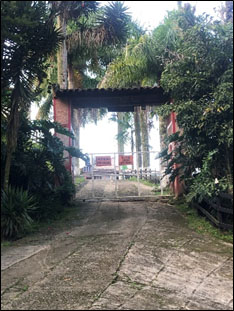
Figure 12‑3 Geology office and accommodation house. (Source: Mauricio Castañeda, June 12, 2021)
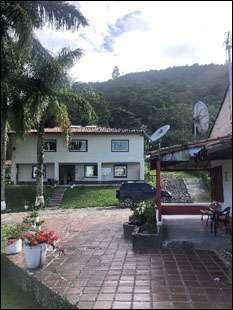
| Metal Mining Consultants Inc. Effective Date July 6, 2021 |
 |
| GoldMining Inc. NI 43-101 Report – La Mina Project |
Page 110 |
Figure 12‑4 Electricity supply by regional grid interconnection. (Source: Mauricio Castañeda, June 12, 2021)
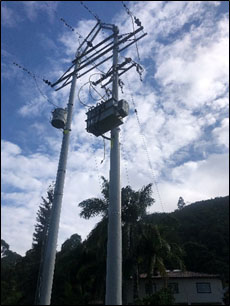
At the moment, the La Mina project is not carrying out any exploration activity. However, the facilities and drillcore storage area are being properly maintained. The facilities are suitable for storage of drilling cores, storage of the laboratory analysis rejects, core shed for logging and sampling, and an office equipped with all the technology to operate exploration processes with international standards and good practices. In addition, there are two houses for the accommodation of exploration professionals and technicians.
| Metal Mining Consultants Inc. Effective Date July 6, 2021 |
 |
| GoldMining Inc. NI 43-101 Report – La Mina Project |
Page 111 |
Figure 12‑5 Warehouse drill-core storage. (Source: Mauricio Castañeda, June 12, 2021)
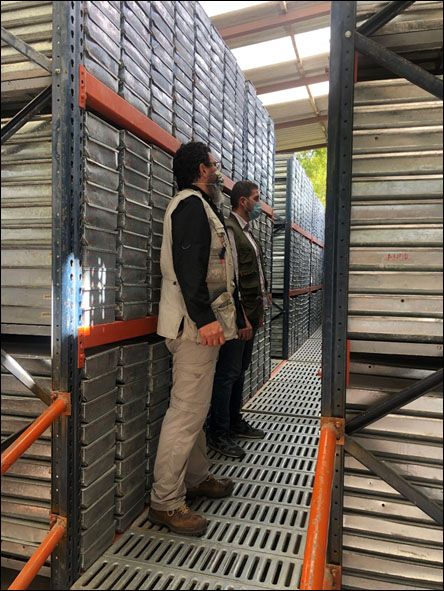
| Metal Mining Consultants Inc. Effective Date July 6, 2021 |
 |
| GoldMining Inc. NI 43-101 Report – La Mina Project |
Page 112 |
Figure 12‑6 Pulp rejects storage. (Source: Mauricio Castañeda, June 12, 2021)
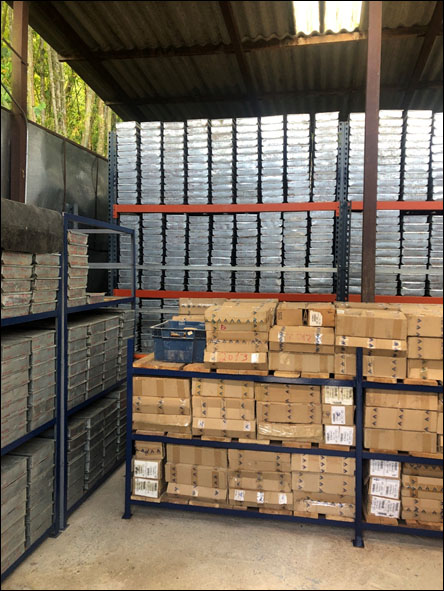
| Metal Mining Consultants Inc. Effective Date July 6, 2021 |
 |
| GoldMining Inc. NI 43-101 Report – La Mina Project |
Page 113 |
Figure 12‑7 Core shed for core logging and sampling. (Source: Mauricio Castañeda, June 12, 2021)
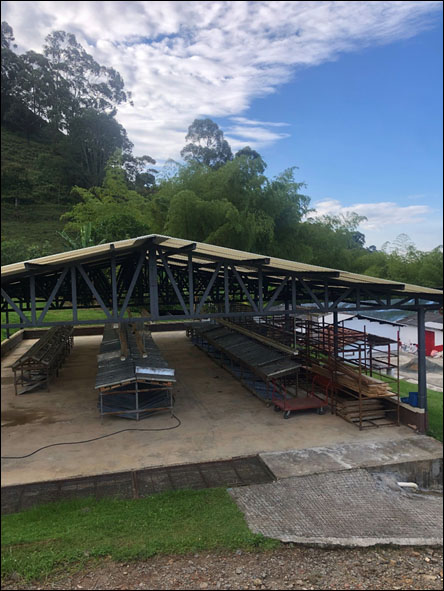
| Metal Mining Consultants Inc. Effective Date July 6, 2021 |
 |
| GoldMining Inc. NI 43-101 Report – La Mina Project |
Page 114 |
Figure 12‑8 Technician demonstrating core cutting procedures. (Source: Mauricio Castañeda, June 12, 2021)
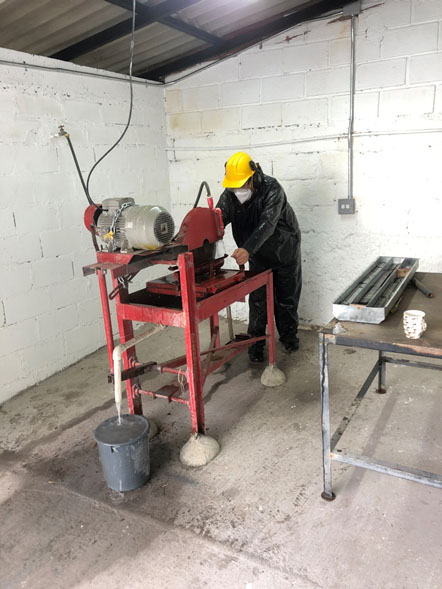
| Metal Mining Consultants Inc. Effective Date July 6, 2021 |
 |
| GoldMining Inc. NI 43-101 Report – La Mina Project |
Page 115 |
Figure 12‑9 Core logging facilities. (Source: Mauricio Castañeda, June 12, 2021)
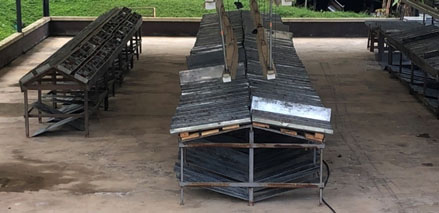
VERIFICATION LA MINA PROJECT
During the field visit to the La Mina Project, it was possible to verify and analyze geological information from maps and geological sections of the La Mina mining project that correlate with representative drill cores.
| Metal Mining Consultants Inc. Effective Date July 6, 2021 |
 |
| GoldMining Inc. NI 43-101 Report – La Mina Project |
Page 116 |
Figure 12‑10 Geology and model review by plan view and systematic sections – La Mina, Fredonia. (Source: Mauricio Castañeda, June 12, 2021)
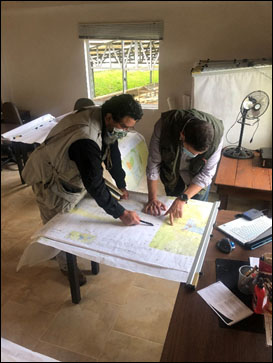 |
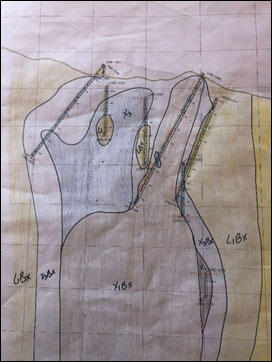 |
The drill core, a product of the drilling campaigns in previous years, are mainly stored in industrial aluminum metal boxes, duly labeled and organized in shelves arranged under the roof to protect them from deterioration.
The logging of some type or representative sections in the drilling cores was carried out where the existence of the host rock and zones hosting gold, silver and copper mineralization of the La Mina project could be validated. Additionally, random sections of mineralized core samples were selected, cut and sampled to validate the grades and concentrations previously reported in the La Mina project.
During the review of the core and the corresponding drill logs, it was possible to verify the proper labeling of the boxes, core and the sample correlation. Observations lead the author to conclude the suitability, experience, financial capacity and responsibility for international standards and good industry practices.
| Metal Mining Consultants Inc. Effective Date July 6, 2021 |
 |
| GoldMining Inc. NI 43-101 Report – La Mina Project |
Page 117 |
Figure 12‑11 Well organized core trays storage. (Source: Mauricio Castañeda, June 12, 2021)
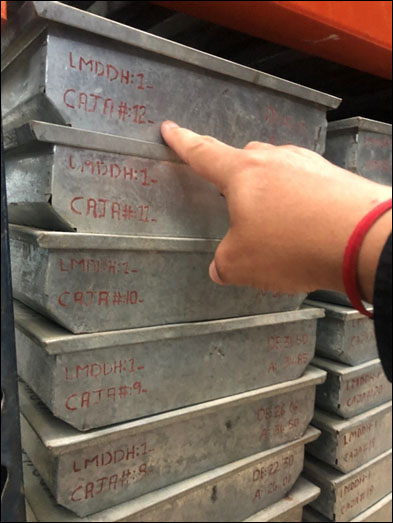
VERIFICATION CHECK SAMPLES
A total of 8 intervals from 3 different core holes, 1 from La Cantera deposit, 2 from Middle Zone deposit, were selected by Mr. Castañeda during the current site visit for quartering (sawing in half the remaining half core intervals) and re-assaying as a duplicate check on previously reported assay values. The check samples were collected under the supervision by Mr. Castañeda and delivered to the Bureau Veritas preparation laboratory in Medellín city; the assays were subsequently processed by the Bureau Veritas laboratory in Lima, Peru. The gold, silver, and copper assays collected by Mr. Castañeda of the ¼-core from both La Cantera and Middle Zone holes matched well with the original ½ core assays reported by the ALS Chemex laboratory. The coarse duplicate and the coarse blank material used as control samples for the check samples at Bureau Veritas laboratory also checked with good results. There were different detection limits reported by the different labs (ALS Chemex, Ag 0.5 ppm, Cu 1 ppm; Bureau Veritas Ag 0.1ppm, Cu 0.1 ppm). However, the difference in detection limits did not appear to have any material impact in the results showing strong correlation, and confirming the validity of the initially reported assays.
| Metal Mining Consultants Inc. Effective Date July 6, 2021 |
 |
| GoldMining Inc. NI 43-101 Report – La Mina Project |
Page 118 |
In the following table is the list and details of the samples selected and evaluated as duplicate checks samples for La Mina Project.
Table 12‑2 Original samples and assay results from the intervals selected for resampling by the QP (initial sampling as reported from the ALS Chemex lab).

Table 12‑3 Check samples collected by the QP to be compared to the initial ½ core samples (results as determined by Bureau Veritas.)

| Metal Mining Consultants Inc. Effective Date July 6, 2021 |
 |
| GoldMining Inc. NI 43-101 Report – La Mina Project |
Page 119 |
Figure 12-12 ¼-core for duplicate checks ready for sampling as prepared under the supervision of the QP during the current site visit (Source: Mauricio Castañeda, June 12, 2021)
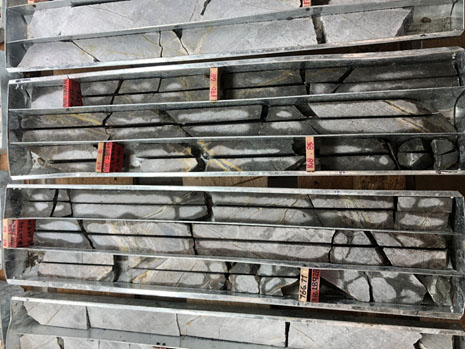
Mr. Castañeda has plotted the duplicate (check assays) collected on the current site inspection for Au, Ag, and Cu as a comparison to the original assays on the corresponding 3 graphs. All elements correlate well in all zones with no discrepancies of any materiality noted by the author.
| Metal Mining Consultants Inc. Effective Date July 6, 2021 |
 |
| GoldMining Inc. NI 43-101 Report – La Mina Project |
Page 120 |
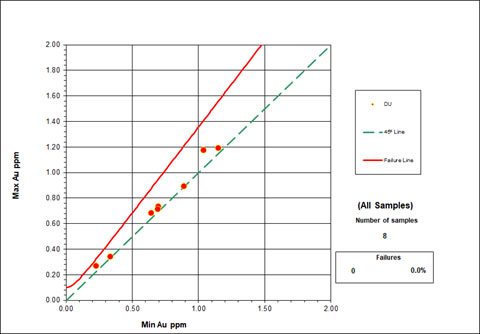
Figure 12-13: Original Vs. Check Samples in Middle Zone and La Cantera – Au.
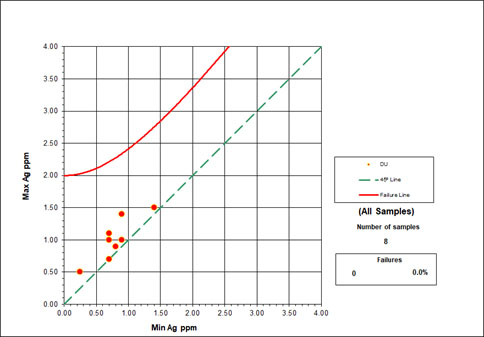
Figure 12-14: Original Vs. Check Samples in Middle Zone and La Cantera – Ag.
| Metal Mining Consultants Inc. Effective Date July 6, 2021 |
 |
| GoldMining Inc. NI 43-101 Report – La Mina Project |
Page 121 |
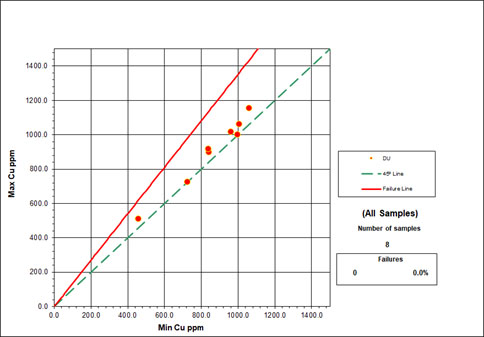
Figure 12-15: Original Vs. Check Samples in Middle Zone and La Cantera – Cu.
Verification of reliable data
During the site visit, digital data, and the drill core data was verified and the geologist of the project display all the information required during the visit. The information is available in good standing and well organized.
| Metal Mining Consultants Inc. Effective Date July 6, 2021 |
 |
| GoldMining Inc. NI 43-101 Report – La Mina Project |
Page 122 |
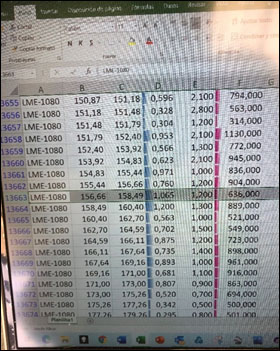
Figure 12-16. Spreadsheet showing data randomly inspected during the site visit. Drill-hole, intervals and assays results Au, Ag and Cu. (Source: Mauricio Castañeda, June 12, 2021)
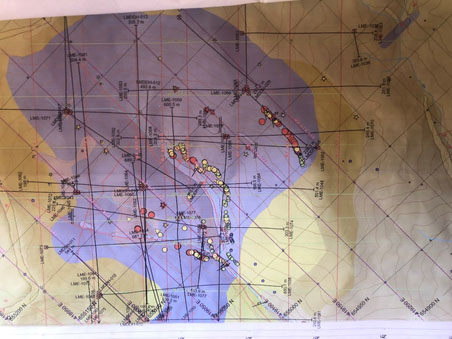
Figure 12-17.: Plan view geology map with drill holes reviewed Middle Zone. (Source: Mauricio Castañeda, June 12, 2021)
| Metal Mining Consultants Inc. Effective Date July 6, 2021 |
 |
| GoldMining Inc. NI 43-101 Report – La Mina Project |
Page 123 |
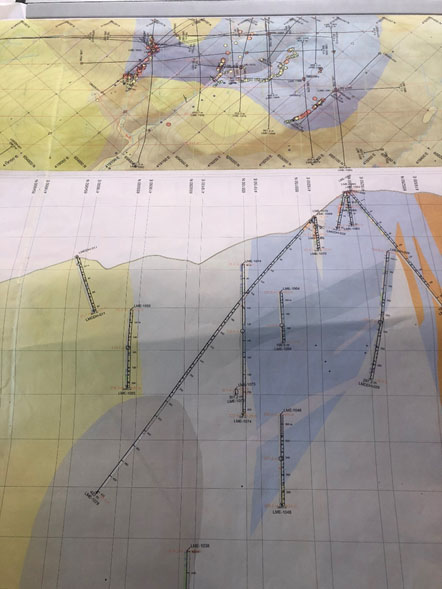
Figure 12‑12: Plan view & Section geology map with drill holes reviewed Middle Zone. (Source: Mauricio Castañeda, June 12, 2021)
| Metal Mining Consultants Inc. Effective Date July 6, 2021 |
 |
| GoldMining Inc. NI 43-101 Report – La Mina Project |
Page 124 |
|
13 |
MINERAL PROCESSING AND METALLURGICAL TESTING |
|
13.1 |
SUMMARY |
Bellhaven Exploraciones contracted Resource Development Inc. (RDi) to undertake a scoping level metallurgical study for La Mina porphyry gold and copper prospect in Colombia.
RDi received four composite samples for the metallurgical study. There were three samples from the La Cantera prospect consisting of average grade, low grade and high grade and one sample from the Middle Zone prospect. The samples assayed 0.306% to 0.476% Cu and 0.727 g/t to 1.454 g/t Au. Sequential copper analysis indicated that two of the four composites contained significant amount of oxide and secondary copper.
The metallurgical test work undertaken included sample preparation and characterization, Bond’s ball millwork index determinations, in-place bulk density measurements, gravity tests, direct cyanidation and carbon-in-leach tests and rougher and cleaner flotation tests.
The samples had a Bond’s ball mill work index of 10.22 to 14.0, which is typically within the range of porphyry copper ores.
Gravity concentration tests indicated that one could not produce a high-grade concentrate that could be directly smelted. Hence, gravity circuit may not be applicable for this deposit.
Whole ore cyanide leach tests extracted over 80% of the gold from three of the four composites. The cyanide consumption was high because of leaching copper minerals along with gold.
Flotation process using a simple reagent suite consisting of potassium amyl xanthate (PAX), Aeropromotor 404 and methyl isobutyl carbinal recovered 85% to 90% of the gold and copper in the rougher concentrate. Regrinding of rougher concentrate followed by two stages of cleaner flotation in open-circuit tests produced a concentrate assaying over 26% Cu and ±50 g/t Au for three of the four composite samples.
An overall recovery of 79% for gold and 84% for copper were projected for the flotation process flowsheet based on assuming 83% of gold and 88% of copper in the rougher flotation process and 95% recovery for both metals in the cleaner flotation process.
However, docked cycle tests need to be performed to confirm these recoveries in the next phase of testing.
|
13.2 |
METALLURGICAL INTRODUCTION |
Bellhaven Exploraciones contracted Resource Development Inc. (RDi) to undertake a scoping metallurgical study to evaluate the various processing options to recover copper and gold.
RDi received four composite samples for the study. There were three samples from the La Cantera prospect consisting of average grade, low grade and high grade and one sample from the Middle Zone prospect.
The scoping studies undertaken included sample preparation and characterization, Bond’s ball mill work index determinations, gravity tests, direct cyanidation and carbon- in-leach tests and rougher and cleaner flotation tests. This Technical Report summarizes the test procedures and results obtained in the study.
| Metal Mining Consultants Inc. Effective Date July 6, 2021 |
 |
| GoldMining Inc. NI 43-101 Report – La Mina Project |
Page 125 |
|
13.2.1 |
METALLURGICAL TEST WORK |
RDI received coarse drill-core rejects for the metallurgical study. These samples were composited to make four representative composite samples for the study. They are listed in Table 14.1.
Table 13‑1 Description of Composite Samples
|
Composite No |
Description |
|
1 |
La Cantera prospect, average grade |
|
2 |
Middle Zone prospect |
|
3 |
La Cantera, high grade |
|
4 |
La Cantera prospect, low grade |
|
13.2.2 |
SAMPLE PREPARATION AND CHARACTERIZATION |
The composite samples were stage crushed to P100 of 6 mesh, thoroughly blended and riffle split into two parts. One part was stored in drums for later work. The other half of each composite was blended and split into 1 kg charges using a twenty-way rotary splitter. The 1 kg charges were weighed, bagged and stored in the freezer to avoid oxidation.
A 1 kg charge for each composite was pulverized to 150 mesh, blended and representative splits taken out for head analyses. The samples were submitted for gold assay using one-assay-ton fire-assay procedure, sequential copper analyses and ICP analyses. The test results are summarized in Tables 13.2 to 13.4.
The test results indicate the following:
|
● |
The gold content in these samples varied from 0.727 g/t to 1.454 g/t. |
|
● |
The total copper content varied from 0.306% to 0.476%. The majority of the copper in composite No.2 and No. 3 was primary copper whereas other two composites had significant amount of oxide and secondary copper (Table 3). |
|
● |
ICP analyses indicated that the composite samples had only traces of other sulfide minerals (i.e. Zn, Pb, As, Ni, Mo, etc.). |
Table 13‑2 Head Analysis of Bellhaven Samples
|
|
Composite No. |
|||
| Element |
1 |
2 |
3 |
4 |
|
Au, g/t |
1.207 |
0.727 |
1.427 |
1.454 |
|
CuTotal,ppm |
3520 |
3320 |
4760 |
3060 |
|
CuAcid sol,ppm |
1468 |
82 |
393 |
856 |
|
CuCNsol,ppm |
1092 |
65 |
299 |
425 |
Table 13‑3 Proportion of Different Forms of Copper in the Bellhaven Samples
|
|
Composite No. |
|||
| Element |
1 |
2 |
3 |
4 |
|
CuAcid sol,% |
41.7 |
2.5 |
8.3 |
28 |
|
CuCNsol,% |
31.0 |
2.0 |
6.3 |
13.9 |
|
CuCPrimary,% |
27.3 |
95.5 |
85.4 |
58.1 |
| Metal Mining Consultants Inc. Effective Date July 6, 2021 |
 |
| GoldMining Inc. NI 43-101 Report – La Mina Project |
Page 126 |
Table 13‑4 ICP Analyses of Composite Samples
|
Composite No. |
||||
|
Element |
1 |
2 |
3 |
4 |
|
Al |
6.95 |
7.48 |
6.41 |
7.94 |
|
Ca |
0.89 |
1.26 |
3.36 |
1.79 |
|
Fe |
7.96 |
5.51 |
6.81 |
7.33 |
|
K |
4.62 |
3.89 |
3.57 |
4.53 |
|
Mg |
0.68 |
0.84 |
0.88 |
1.02 |
|
Na |
1.99 |
2.01 |
1.89 |
2.25 |
|
Ti |
0.19 |
0.14 |
0.21 |
0.24 |
|
Element, ppm |
||||
|
As |
<10 |
<10 |
<10 |
<10 |
|
Ba |
837 |
1267 |
783 |
1062 |
|
Bi |
<10 |
<10 |
<10 |
<10 |
|
Cd |
9 |
6 |
7 |
8 |
|
Co |
14 |
11 |
12 |
13 |
|
Cr |
30 |
36 |
30 |
30 |
|
Cu |
3533 |
3233 |
4359 |
3061 |
|
Mn |
520 |
502 |
741 |
595 |
|
Mo |
17 |
29 |
100 |
20 |
|
Ni |
<5 |
<5 |
<5 |
<5 |
|
Pb |
12 |
11 |
<10 |
11 |
|
Sr |
307 |
408 |
487 |
433 |
|
V |
110 |
99 |
84 |
105 |
|
W |
<10 |
<10 |
<10 |
<10 |
|
Zn |
132 |
95 |
105 |
167 |
|
13.3 |
IN-PLACE BULK DENSITIES |
RDi received rock samples from the various parts of the prospect for in-place bulk density measurements. We used the standard procedure of waxing the dried core samples and determining the water displacement volume to calculate the in-place bulk densities. The results for the 16 samples are given in Table 13.5. The bulk densities ranged from 2.48 to 2.98 g/cc.
| Metal Mining Consultants Inc. Effective Date July 6, 2021 |
 |
| GoldMining Inc. NI 43-101 Report – La Mina Project |
Page 127 |
Table 13‑5 In Place Bulk Densities for the Selected Core Samples
|
Sample Code |
Au Grade |
Target |
Hole ID |
Depth |
Rock |
SG |
|
D1 |
AVG Medium Grade |
La Cantera |
DDH-08 |
26.00 |
EIB |
2.53 |
|
D2 |
AVG Medium Grade |
La Cantera |
DDH-08 |
36.90 |
EIB |
2.54 |
|
D3 |
AVG Medium Grade |
La Cantera |
DDH-08 |
50.80 |
EIB |
2.64 |
|
D4 |
High Grade |
La Cantera |
DDH-08 |
204.00 |
EIB |
2.67 |
|
D5 |
High Grade |
La Cantera |
DDH-08 |
217.17 |
EIB |
2.98 |
|
D6 |
Low Grade |
La Cantera |
DDH-08 |
49.10 |
EIB |
2.51 |
|
D7 |
Low Grade |
La Cantera |
DDH-08 |
63.50 |
EIB |
2.58 |
|
D8 |
High Grade |
La Cantera |
DDH-09 |
265.27 |
Diorite Cantera |
2.58 |
|
D 9 |
High Grade |
La Cantera |
DDH-09 |
289.00 |
Diorite Cantera |
2.63 |
|
D10 |
High Grade |
La Cantera |
DDH-09 |
294.30 |
EIB |
2.75 |
|
D11 |
AVG Medium Grade |
Middle Zone |
DDH-13 |
40.80 |
X3 Porphyry |
2.62 |
|
D12 |
AVG Medium Grade |
Middle Zone |
DDH-13 |
49.80 |
X3 Porphyry |
2.48 |
|
D13 |
AVG Medium Grade |
Middle Zone |
DDH-13 |
54.00 |
X3 Porphyry |
2.54 |
|
D14 |
AVG Medium Grade |
Middle Zone |
DDH-13 |
78.25 |
X3 Porphyry Breccia |
2.56 |
|
D15 |
Low Grade |
La Cantera |
DDH-09 |
227.50 |
EIB |
2.64 |
|
D16 |
Low Grade |
La Cantera |
DDH-09 |
233.60 |
EIB |
2.62 |
|
13.4 |
BALL MILL WORK INDICES |
Ball Mill work indices were determined at 100 mesh for the four composite samples. The test data are given in Appendix B and the results are summarized in Table 13.6.
Table 13‑6 Bond's Ball Mill Work Index @ 100 Mesh
|
Composite No |
Area |
BWI |
|
1 |
La Cantera average grade |
10.22 |
|
2 |
Middle Zone |
11.96 |
|
3 |
La Cantera high grade |
14.00 |
|
4 |
La Cantera low grade |
12.85 |
These results indicate that the ore hardness is within the range for the porphyry ores. The La Cantera high-grade sample had the highest work index.
|
13.5 |
GRIND STUDIES |
A series of grind tests with 1 kg charges were performed in a laboratory rod mill at 50% solids for all the composite samples to establish the grind time-grind size relationship. Laboratory rod mill simulates a ball mill-cyclone circuit in actual operation. The ores were ground for varying times and the ground pulp was wet screened on 400-mesh.
| Metal Mining Consultants Inc. Effective Date July 6, 2021 |
 |
| GoldMining Inc. NI 43-101 Report – La Mina Project |
Page 128 |
Both the plus 400-mesh and the minus 400-mesh fractions were filtered and dried and the plus 400 mesh was then dry screened. All the size fractions were weighed and the size distributions were calculated.
The test data are given in Appendix C. The grind times required to achieve the desired grind sizes for each composite were determined from the grind data.
|
13.6 |
GRAVITY TESTS |
The objective of the gravity testing was to determine if one could recover free gold, especially coarse gold, from the ore in a concentrate which could be directly smelted.
The four composite samples (1 kg charges) were ground to P80 of 65, 100, and 150 mesh and subjected to gravity concentration using a laboratory Knelson concentrator. The gravity concentrate was subjected to cleaner gravity concentration using Gemeni table.
The test data are summarized in Table 7 to 10. The test results indicate that gravity concentrate recovered 11% to 28% of the gold in 0.4% to 2.8% of the weight. The concentrate grade ranged from 2 g/t to 115 g/t Au.
Since the concentrate grade was too low to treat it separately and there may not be any coarse gold in the deposit, a gravity circuit may not be needed for this deposit.
Table 13‑7 Gravity Test Results for Composite No. 1
|
|
Recovery % |
Grade |
|||||
| Product |
Wt |
Au |
Cu |
S |
Au, g/t |
Cu, g/t |
S, % |
|
P80 65 mesh (T-1) |
|||||||
|
Gemeni Conc. |
0.4 | 28.5 | 4.5 | 5.6 | 114.68 | 48,600 | 4.01 |
|
Gemeni Tails |
11.4 | 27.1 | 10.4 | 8.6 | 3.53 | 3660 | 0.20 |
|
Cal. Knelson Conc. |
11.8 | 55.6 | 14.9 | 14.1 | 7.02 | 5070 | 0.32 |
|
Knelson Tails |
88.2 | 44.4 | 85.1 | 85.9 | 0.75 | 3870 | 0.26 |
|
Cal. Feed |
100.0 | 100.0 | 100.0 | 100.0 | 1.49 | 4012 | 0.27 |
|
P80 100 mesh (T-2) |
|||||||
|
Gemeni Conc. |
1.7 | 20.3 | 14.9 | 22.1 | 14.63 | 35000 | 3.71 |
|
Gemeni Tails |
13.7 | 23.9 | 16.4 | 14.2 | 2.09 | 4660 | 0.29 |
|
Cal. Knelson Conc. |
15.4 | 44.2 | 31.3 | 36.3 | 3.45 | 7960 | 0.66 |
|
Knelson Tails |
84.6 | 55.8 | 68.7 | 63.7 | 0.79 | 3100 | 0.21 |
|
Cal Feed |
100.0 | 100.0 | 100.0 | 100.0 | 1.20 | 3894 | 0.28 |
|
P80 150 mesh (T-3) |
|||||||
|
Gemeni Conc. |
2.8 | 23.0 | 27.0 | 36.9 | 8.71 | 39400 | 3.57 |
|
Gemeni Tails |
7.4 | 13.9 | 10.6 | 10.4 | 1.99 | 5880 | 0.38 |
|
Cal. Knelson Conc. |
10.2 | 36.8 | 37.6 | 47.2 | 3.84 | 15088 | 1.26 |
|
Knelson Tails |
89.8 | 63.2 | 62.4 | 52.8 | 0.75 | 2850 | 0.16 |
|
Cal. Feed |
100.0 | 100.0 | 100.0 | 100.0 | 1.07 | 4102 | 0.27 |
| Metal Mining Consultants Inc. Effective Date July 6, 2021 |
 |
| GoldMining Inc. NI 43-101 Report – La Mina Project |
Page 129 |
Table 13‑8 Gravity Test Results for Composite No.2
|
|
Recovery % |
Grade |
|||||
| Product |
Wt |
Au |
Cu |
S |
Au, g/t |
Cu, g/t |
S, % |
|
P80 65 mesh (T-4) |
|||||||
|
Gemeni Conc. |
0.9 |
18.9 |
2.5 |
19.7 |
21.45 |
9640 |
30.15 |
|
Gemeni Tails |
10.7 |
15.8 |
12.4 |
10.5 |
1.44 |
3900 |
1.29 |
|
Cal. Knelson Conc. |
11.6 |
34.7 |
14.8 |
30.2 |
2.93 |
4326 |
3.43 |
|
Knelson Tails |
88.4 |
65.3 |
85.2 |
69.8 |
0.72 |
3250 |
1.04 |
|
Cal. Feed |
100 |
100 |
100 |
100 |
0.98 |
3357 |
1.32 |
|
P80 100 mesh (T-5) |
|||||||
|
Gemeni Conc. |
1.4 |
28.1 |
5.5 |
27.8 |
20.37 |
13190 |
23.65 |
|
Gemeni Tails |
12.2 |
18.4 |
16.9 |
15.6 |
1.51 |
4560 |
1.5 |
|
Cal. Knelson Conc. |
13.6 |
46.6 |
22.5 |
43.4 |
3.43 |
5437 |
3.75 |
|
Knelson Tails |
86.4 |
53.4 |
77.5 |
56.6 |
0.62 |
2960 |
0.77 |
|
Cal. Feed |
100 |
100 |
100 |
100 |
1 |
3297 |
1.18 |
|
P80 150 mesh (T-6) |
|||||||
|
Gemeni Conc. |
1.9 |
17.7 |
7.3 |
38.1 |
9.05 |
12320 |
25.92 |
|
Gemeni Tails |
10 |
18.6 |
21.9 |
22 |
1.85 |
7190 |
2.91 |
|
Cal. Knelson Conc. |
11.9 |
36.3 |
29.2 |
60.1 |
3.02 |
8024 |
6.65 |
|
Knelson Tails |
88.1 |
63.7 |
70.8 |
39.9 |
0.72 |
2640 |
0.6 |
|
Cal. Feed |
100 |
100 |
100 |
100 |
0.99 |
3283 |
1.32 |
Table 13‑9 Gravity Test Results for Composite No. 3
|
|
Recovery % |
Grade |
|||||
| Product |
Wt |
Au |
Cu |
S |
Au, g/t |
Cu, g/t |
S, % |
|
P80 65 mesh (T-7) |
|||||||
|
Gemeni Conc. |
1.2 |
12.8 |
6.4 |
5.6 |
18.97 |
25800 |
4.86 |
|
Gemeni Tails |
10.5 |
16.8 |
14.8 |
7.2 |
2.95 |
7070 |
0.74 |
|
Cal. Knelson Conc. |
11.7 |
29.5 |
21.2 |
12.7 |
4.65 |
9052 |
1.18 |
|
Knelson Tails |
88.3 |
70.5 |
78.8 |
87.3 |
1.47 |
4470 |
1.07 |
|
Cal. Feed |
100.0 |
100.0 |
100.0 |
100.0 |
1.84 |
5007 |
1.08 |
|
P80 100 mesh (T-8) |
|||||||
|
Gemeni Conc. |
1.1 |
18.3 |
4.7 |
4.2 |
33.87 |
20300 |
4.79 |
|
Gemeni Tails |
6.6 |
11.8 |
6.3 |
2.3 |
3.80 |
4730 |
0.46 |
|
Cal. Knelson Conc. |
7.7 |
30.1 |
11.0 |
6.5 |
8.27 |
7044 |
1.10 |
|
Knelson Tails |
92.3 |
69.9 |
89.0 |
93.5 |
1.61 |
4750 |
1.34 |
|
Cal. Feed |
100.0 |
100.0 |
100.0 |
100.0 |
2.12 |
4927 |
1.32 |
|
P80 150 mesh (T-9) |
|||||||
|
Gemeni Conc. |
2.5 |
14.9 |
12.2 |
13.0 |
14.81 |
24300 |
4.87 |
|
Gemeni Tails |
6.8 |
14.0 |
14.3 |
9.0 |
5.21 |
10660 |
1.26 |
|
Cal. Knelson Conc. |
9.4 |
28.9 |
26.5 |
22.0 |
7.82 |
14372 |
2.24 |
|
Knelson Tails |
90.6 |
71.1 |
73.5 |
78.0 |
1.99 |
4110 |
0.82 |
|
Cal. Feed |
100.0 |
100.0 |
100.0 |
100.0 |
2.54 |
5070 |
0.95 |
| Metal Mining Consultants Inc. Effective Date July 6, 2021 |
 |
| GoldMining Inc. NI 43-101 Report – La Mina Project |
Page 130 |
Table 13‑10 Gravity Test Results for Composite No. 4
| Recovery % | Grade | ||||||
| Product | Wt | Au | Cu | S | Au, g/t | Cu, g/t | S, % |
|
P80 65 mesh (T-10) |
|||||||
|
Gemeni Conc. |
1.9 | 19.8 | 7.5 | 16.4 | 16.53 | 13190 | 2.29 |
|
Gemeni Tails |
7.4 | 13.6 | 8.9 | 8.8 | 2.95 | 4030 | 0.32 |
|
Cal. Knelson Conc. |
9.3 | 33.4 | 16.4 | 25.2 | 5.74 | 5911 | 0.72 |
|
Knelson Tails |
90.7 | 66.6 | 83.6 | 74.8 | 1.17 | 3080 | 0.22 |
|
Cal. Feed |
100.0 | 100.0 | 100.0 | 100.0 | 1.59 | 3343 | 0.27 |
|
P80 100 mesh (T-11) |
|||||||
|
Gemeni Conc. |
1.1 | 20.1 | 6.1 | 8.5 | 13.87 | 16890 | 2.13 |
|
Gemeni Tails |
14.0 | 30.3 | 15.3 | 11.2 | 1.71 | 3450 | 0.23 |
|
Cal. Knelson Conc. |
15.1 | 50.4 | 21.4 | 19.7 | 2.63 | 4463 | 0.37 |
|
Knelson Tails |
84.9 | 49.6 | 78.6 | 80.3 | 0.46 | 2920 | 0.27 |
|
Cal. Feed |
100.0 | 100.0 | 100.0 | 100.0 | 0.79 | 3153 | 0.29 |
|
P80 150 mesh (T-12) |
|||||||
|
Gemeni Conc. |
2.6 | 11.5 | 12.4 | 25.5 | 2.78 | 14720 | 2.66 |
|
Gemeni Tails |
8.6 | 23.2 | 14.8 | 16.5 | 1.73 | 5400 | 0.53 |
|
Cal. Knelson Conc. |
11.2 | 34.7 | 27.3 | 42.0 | 1.98 | 7593 | 1.03 |
|
Knelson Tails |
88.8 | 65.3 | 72.7 | 58.0 | 0.47 | 2560 | 0.18 |
|
Cal. Feed |
100.0 | 100.0 | 100.0 | 100.0 | 0.64 | 3125 | 0.28 |
|
13.7 |
WHOLE ORE CYANIDATION LEACH TESTS |
Whole Ore Cyanidation and carbon-in-leach tests were performed on the four composites to determine the metal extractions and reagent consumptions.
Each composite sample (1 kg charge) was ground to P80 of 200 mesh and slurried with water to a density of 40% solids. The slurried sample was adjusted to a pH of 11 with lime and a cyanide concentration of 1 g/l. For the carbon-in-leach tests, 20 g/l of carbon was also added to the slurry. The samples were bottle rolled for 48 hours. Kinetic samples were taken at 6, 24 and 48 hours for whole ore cyanidation tests and assayed for gold and copper. The pH and NaCN concentration were adjusted to 11 and 1 g/l respectively at 6 and 24 hours. After 48 hours, the samples were filtered and the test residues thoroughly washed and dried. The dry residues were pulverized and assayed for gold and copper.
The test results are summarized in Tables 13.11 and 13.12.
The test results indicate the following:
|
● |
Gold extractions were reasonable (>80%) for composite No’s. 2 to 4. The gold extraction from composite No. 1 was only 31.3%. |
|
● |
The copper extractions for these samples ranged from 44% to 71%. |
|
● |
The NaCN consumption was high (i.e. 1.7 to 4.4 kg/t). |
| Metal Mining Consultants Inc. Effective Date July 6, 2021 |
 |
| GoldMining Inc. NI 43-101 Report – La Mina Project |
Page 131 |
There appears to be no robbing components in these ores based on direct cyanidation and CIL tests.
Table 13‑11 Cyanidation Leach Test Results (P80 = 200 Mesh)
|
|
Composite No |
|||||||
|
1 |
2 |
3 |
4 |
|||||
| Parameter |
Au |
Cu |
Au |
Cu |
Au |
Cu |
Au |
Cu |
|
Extraction % |
||||||||
|
6 hrs. |
8.6 |
28.8 |
33.7 |
15.5 |
10.3 |
22.3 |
7.4 |
17.8 |
|
24 hrs. |
24.1 |
31.4 |
80.6 |
29.5 |
62.9 |
54.4 |
59.5 |
31.5 |
|
48 hrs. |
31.3 |
48.8 |
86.2 |
44.3 |
84.5 |
70.7 |
90.2 |
34.8 |
|
Residue, g/t |
0.61 |
2120 |
0.1 |
320 |
0.21 |
402 |
0.06 |
2042 |
|
Cal. Feed g/t |
0.89 |
4140 |
0.72 |
575 |
1.35 |
1372 |
0.63 |
3125 |
|
NaCN Consumption, Kg/t |
4.363 |
1.791 |
3.268 |
2.858 |
||||
Table 13‑12 Carbon-in-Leach (CIL) Test Results
|
|
Composite No |
|||||||
|
1 |
2 |
3 |
4 |
|||||
| Parameter |
Au |
Cu |
Au |
Cu |
Au |
Cu |
Au |
Cu |
|
Extraction % (48 hrs) |
41.3 |
49.4 |
86.8 |
42.6 |
85.7 |
72.9 |
84.9 |
34.7 |
|
Carbon g/t |
12.2 |
241.2 |
21.26 |
518 |
41.06 |
4920 |
20.2 |
2184 |
|
Residue, g/t |
0.54 |
2082 |
0.1 |
322 |
0.21 |
390 |
0.11 |
2050 |
|
Cal. Feed g/t |
0.91 |
4115 |
0.73 |
561 |
1.49 |
1439 |
0.73 |
3139 |
|
NaCN Consumption, Kg/t |
4.035 |
1.89 |
3.64 |
3.193 |
||||
|
13.8 |
FLOTATION TESTS |
|
13.8.1 |
ROUGHER FLOTATION |
Flotation tests were undertaken with the primary objective of producing a copper- and gold-rich sulfide mineral concentrate. The process variables evaluated included grind size, collectors (potassium amyl xanthate (PAX), Aero Promotors 404 and 3418A) and sulfidization of the ore in the grinding circuit. There were six rougher flotation tests run with each of the four composites.
The process parameters for the flotation tests are given in Table 13.13. The flotation test data are given in Appendix F and the results are summarized in Tables 13.14 to 13.16. The test results indicated the following:
|
● |
Gold recovery of 85% to 90% can be obtained in the rougher flotation concentrate along with similar recoveries for copper. |
|
● |
These recoveries were achieved with a simple reagent suite consisting of potassium amyl xanthate (PAX), Aeropromotor 404. |
|
● |
Sulfidization was found to be detrimental instead of beneficial for these samples. |
| Metal Mining Consultants Inc. Effective Date July 6, 2021 |
 |
| GoldMining Inc. NI 43-101 Report – La Mina Project |
Page 132 |
Table 13‑13 Flotation Process Test Parameter
|
Test No |
Composite No |
Grind P80, mesh |
Reagents, g/t |
||||
|
PAX |
AP 404 |
MIBC |
Na2S |
3418 A |
|||
|
1 |
1 |
100 |
100 |
100 |
40 |
2000 |
- |
|
2 |
1 |
150 |
100 |
100 |
40 |
2000 |
- |
|
3 |
1 |
200 |
100 |
100 |
40 |
2000 |
- |
|
4 |
1 |
150 |
100 |
100 |
40 |
- |
- |
|
5 |
1 |
150 |
- |
- |
40 |
2000 |
100 |
|
6 |
1 |
150 |
- |
100 |
40 |
2000 |
100 |
|
7 |
2 |
100 |
100 |
100 |
40 |
- |
- |
|
8 |
2 |
150 |
100 |
100 |
40 |
- |
- |
|
9 |
2 |
200 |
100 |
100 |
40 |
- |
- |
|
10 |
2 |
150 |
100 |
- |
40 |
- |
- |
|
11 |
2 |
150 |
- |
- |
40 |
- |
100 |
|
12 |
2 |
150 |
- |
100 |
40 |
- |
100 |
|
13 |
4 |
100 |
100 |
100 |
40 |
1000 |
- |
|
14 |
4 |
150 |
100 |
100 |
40 |
1000 |
- |
|
15 |
4 |
200 |
100 |
100 |
40 |
1000 |
- |
|
16 |
4 |
150 |
100 |
100 |
40 |
- |
- |
|
17 |
4 |
150 |
- |
- |
40 |
1000 |
100 |
|
18 |
4 |
150 |
- |
100 |
40 |
1000 |
100 |
|
19 |
3 |
100 |
100 |
100 |
40 |
- |
- |
|
20 |
3 |
150 |
100 |
100 |
40 |
- |
- |
|
21 |
3 |
200 |
100 |
100 |
40 |
- |
- |
|
22 |
3 |
150 |
100 |
- |
40 |
- |
- |
|
23 |
3 |
150 |
- |
- |
40 |
- |
100 |
|
24 |
3 |
150 |
- |
100 |
40 |
- |
100 |
| Metal Mining Consultants Inc. Effective Date July 6, 2021 |
 |
| GoldMining Inc. NI 43-101 Report – La Mina Project |
Page 133 |
Table 13‑14 Flotation Test Results for Composite No. 1
|
|
Concentrate Recovery (9 min. float time) |
Concentrate Grade |
|||
| Product |
Wt |
Au |
Cu |
Au, g/t |
Cu, % |
|
Test No 1 |
|||||
|
Rougher Conc |
3.9 |
13.6 |
7.3 |
3.37 |
0.7403 |
|
Rougher Tails |
96.1 |
86.4 |
92.7 |
0.86 |
0.3800 |
|
Cal. Head |
100.0 |
100.0 |
100.0 |
0.96 |
0.3940 |
|
Test No 2 |
|||||
|
Rougher Conc |
6.1 |
94.0 |
88.9 |
12.02 |
6.3531 |
|
Rougher Tails |
93.9 |
6.0 |
11.1 |
<0.10 |
0.0514 |
|
Cal. Head |
100.0 |
100.0 |
100.0 |
0.78 |
0.4342 |
|
Test No 3 |
|||||
|
Rougher Conc |
6.6 |
71.8 |
91.2 |
12.22 |
5.1777 |
|
Rougher Tails |
93.4 |
28.2 |
8.8 |
0.34 |
0.0352 |
|
Cal. Head |
100.0 |
100.0 |
100.0 |
1.13 |
0.3751 |
|
Test No 4 |
|||||
|
Rougher Conc |
6.9 |
96.8 |
90.8 |
20.75 |
4.9856 |
|
Rougher Tails |
93.1 |
3.2 |
9.2 |
<0.10 |
0.0374 |
|
Cal. Head |
100.0 |
100.0 |
100.0 |
1.47 |
0.3779 |
|
Test No 5 |
|||||
|
Rougher Conc |
5.7 |
33.0 |
28.9 |
5.60 |
2.0329 |
|
Rougher Tails |
94.3 |
67.0 |
71.1 |
0.69 |
0.3020 |
|
Cal. Head |
100.0 |
100.0 |
100.0 |
0.97 |
0.4008 |
|
Test No 6 |
|||||
|
Rougher Conc |
7.7 |
57.0 |
72.6 |
7.11 |
3.9677 |
|
Rougher Tails |
92.3 |
43.0 |
27.4 |
0.45 |
0.1254 |
|
Cal. Head |
100.0 |
100.0 |
100.0 |
0.97 |
0.4227 |
| Metal Mining Consultants Inc. Effective Date July 6, 2021 |
 |
| GoldMining Inc. NI 43-101 Report – La Mina Project |
Page 134 |
Table 13‑15 Flotation Test Results for Composite No. 2
|
|
Concentrate Recovery (9 min. float time) |
Concentrate Grade |
|||
| Product |
Wt |
Au |
Cu |
Au, g/t |
Cu, % |
|
Test No 7 |
|||||
|
Rougher Conc |
8.6 |
77.0 |
87.5 |
7.45 |
3.2684 |
|
Rougher Tails |
91.4 |
23.0 |
12.5 |
0.21 |
0.0442 |
|
Cal. Head |
100.0 |
100.0 |
100.0 |
0.83 |
0.3222 |
|
Test No 8 |
|||||
|
Rougher Conc |
10.2 |
93.2 |
88.7 |
6.06 |
3.1202 |
|
Rougher Tails |
89.8 |
6.8 |
11.3 |
<0.10 |
0.0452 |
|
Cal. Head |
100.0 |
100.0 |
100.0 |
0.66 |
0.3592 |
|
Test No 9 |
|||||
|
Rougher Conc |
10.5 |
79.9 |
87.0 |
5.76 |
2.9573 |
|
Rougher Tails |
89.5 |
20.1 |
13.0 |
0.17 |
0.0518 |
|
Cal. Head |
100.0 |
100.0 |
100.0 |
0.76 |
0.3572 |
|
Test No 10 |
|||||
|
Rougher Conc |
10.7 |
93.6 |
91.2 |
6.11 |
3.0482 |
|
Rougher Tails |
89.3 |
6.4 |
8.8 |
<0.10 |
0.0350 |
|
Cal. Head |
100.0 |
100.0 |
100.0 |
0.70 |
0.3572 |
|
Test No 11 |
|||||
|
Rougher Conc |
10.4 |
80.9 |
90.8 |
6.16 |
3.0248 |
|
Rougher Tails |
89.6 |
19.1 |
8.2 |
0.17 |
0.0356 |
|
Cal. Head |
100.0 |
100.0 |
100.0 |
0.80 |
0.3477 |
|
Test No 12 |
|||||
|
Rougher Conc |
10.3 |
83.6 |
88.9 |
6.25 |
3.0045 |
|
Rougher Tails |
89.7 |
16.4 |
11.1 |
0.14 |
0.0430 |
|
Cal. Head |
100.0 |
100.0 |
100.0 |
0.77 |
0.3467 |
| Metal Mining Consultants Inc. Effective Date July 6, 2021 |
 |
| GoldMining Inc. NI 43-101 Report – La Mina Project |
Page 135 |
Table 13‑16 Flotation Test Results for Composite No. 4
|
|
Concentrate Recovery (9 min. float time) |
Concentrate Grade |
|||
| Product |
Wt |
Au |
Cu |
Au, g/t |
Cu, % |
|
Test No 13 |
|||||
|
Rougher Conc |
5.3 |
73.9 |
74.9 |
10.73 |
4.8051 |
|
Rougher Tails |
94.7 |
26.1 |
25.1 |
0.21 |
0.0894 |
|
Cal. Head |
100.0 |
100.0 |
100.0 |
0.76 |
0.3375 |
|
Test No 14 |
|||||
|
Rougher Conc |
6.0 |
79.0 |
78.0 |
10.12 |
4.3742 |
|
Rougher Tails |
94.0 |
21.0 |
22.0 |
0.17 |
0.0782 |
|
Cal. Head |
100.0 |
100.0 |
100.0 |
0.76 |
0.3341 |
|
Test No 15 |
|||||
|
Rougher Conc |
5.9 |
86.0 |
79.2 |
9.80 |
4.4733 |
|
Rougher Tails |
94.1 |
14.0 |
20.8 |
0.10 |
0.0736 |
|
Cal. Head |
100.0 |
100.0 |
100.0 |
0.67 |
0.3327 |
|
Test No 16 |
|||||
|
Rougher Conc |
6.8 |
80.9 |
73.6 |
4.08 |
3.6364 |
|
Rougher Tails |
93.2 |
19.1 |
26.4 |
0.07 |
0.0946 |
|
Cal. Head |
100.0 |
100.0 |
100.0 |
0.34 |
0.3338 |
|
Test No 17 |
|||||
|
Rougher Conc |
6.6 |
57.5 |
77.4 |
9.15 |
4.0718 |
|
Rougher Tails |
93.4 |
42.5 |
22.6 |
0.48 |
0.0840 |
|
Cal. Head |
100.0 |
100.0 |
100.0 |
1.05 |
0.3478 |
|
Test No 18 |
|||||
|
Rougher Conc |
6.6 |
82.0 |
78.3 |
9.04 |
4.0440 |
|
Rougher Tails |
93.4 |
18.0 |
21.7 |
0.14 |
0.0794 |
|
Cal. Head |
100.0 |
100.0 |
100.0 |
0.73 |
0.3413 |
|
13.9 |
2016 MET TESTS |
It was realized after the initial metallurgical work of November 15, 2011 that opportunities existed to enhance potential gold recoveries by:
|
1. |
Direct cyanide leaching of the second cleaner tails. |
|
2. |
Ultra-fine grinding of the second cleaner tails followed by cyanide leaching. |
|
3. |
Bioleaching of the second cleaner tails followed by cyanide leaching. |
|
4. |
Refining of the flotation process without the use of cyanide. |
The fourth option was particularly intriguing because it offered the possibility for increasing both gold and copper recoveries and doing so without deploying cyanide. Bellhaven engaged Research Development Inc. (“InterPro”, based in Denver, Colorado) in 2016 to review the four options on a preliminary basis and did not undertake additional metallurgical test work. After conducting its investigation of the four options outlined above, InterPro determined that gold recoveries could be increased through the cyanide leaching of the second cleaner tails (Options 1, 2, and 3).
| Metal Mining Consultants Inc. Effective Date July 6, 2021 |
 |
| GoldMining Inc. NI 43-101 Report – La Mina Project |
Page 136 |
Examination of Option 4 (further refining of the flotation process without the use of cyanide) determined that both gold and copper recoveries could be increased by adding a scavenger circuit after the rougher flotation cells to treat the rougher tails (where gold and copper are lost). The scavenger concentrate would then be piped to the cleaner flotation cells. Following the cleaner flotation process (where gold and copper are also lost), the cleaner flotation tails would then be routed to a re-grinding circuit to liberate additional gold- and copper-bearing sulfide minerals, which would again be passed back to the rougher flotation circuit. Option 4 essentially adds additional flotation time and more grinding to the overall processing plan. The addition of these steps to the process should increase the copper recovery from 88% (November, 2011 metallurgical study) to 91% and increase the gold recovery from 90% (November, 2011 metallurgical study) to 93%. InterPro is of the opinion that these recoveries can be incorporated into a future, updated NI 43-101 resource estimate and PEA for the La Mina Project. Two significant impacts of Option 4 elevating gold and copper recoveries are:
|
1. |
No cyanide will be required to attain additional gold or copper recoveries. |
|
2. |
Little additional capital will be required to a contemplated processing plant. |
|
13.10 |
METALLURGICAL CONCLUSIONS |
The preliminary metallurgical tests indicate that the La Mina samples (La Cantera and the Middle Zone) are amenable to standard flotation and gold recovery by cyanidation. The results of the preliminary tests presented in this section are positive.
Further in-depth tests need to be run for prefeasibility studies. New samples may be needed since oxidation of previous samples is a concern in tropical climates.
|
13.11 |
RECOMMENDATIONS |
Further metallurgical tests need to be run on the Cantera and the Middle Zone material. As indicated in this report, the resource material is only in the inferred category and with the drill needed to move this into the measured and indicated categories, metallurgical tests need to be conducted on those cores. The following are some recommendations for future studies:
|
● |
All core needs to be stored in plastic sleeves with either the air removed or nitrogen added to prevent oxidation. |
|
● |
The testwork moving forward needs to include lock cycle tests to produce samples for concentrate grades and sufficient cleaner tails to conduct a separate study on the effectiveness of cyanide leaching on the cleaner tails and determine if the first or second cleaner should be leached. The difference is in the size of the cyanide leach plant for the cleaner tails. |
|
● |
Testwork has yet to begin on 11 core sample rejects on the fresh La Garrucha material. The program includes preliminary grinding, rougher flotation tests, and preliminary optimization of both grinding and flotation as necessary and production of cleaner samples for cyanide leaching. As positive results are assembled, lock cycle tests will be conducted on composite samples from this area. These results when defined will further set the flowsheet. |
Depending on recovery of gold from the cleaner tails, GoldMining might consider some sort of leach operation of the pyrite for the cleaner tails.
| Metal Mining Consultants Inc. Effective Date July 6, 2021 |
 |
| GoldMining Inc. NI 43-101 Report – La Mina Project |
Page 137 |
|
14 |
MINERAL RESOURCE ESTIMATE |
The Mineral Resource statement presented herein represents the mineral resource evaluation prepared for the La Cantera deposit and Middle Zone deposit at the La Mina Project. Wireframes were created for 3 geologic groups at La Cantera and 5 geologic lithologies at Middle Zone. Grades within each group and lithology were estimated using inverse distance techniques in VulcanTM block models using GoldMining’s drillhole database.
This section describes the resource estimation methodology and summarizes the key assumptions considered for mineral resource estimates. In the opinion of the author, the resource evaluation reported herein is a reasonable representation of the global gold, copper and silver mineral resources found in the La Mina Project at the current level of sampling. Mineral resources are not mineral reserves and have not demonstrated economic viability. There is no certainty that all or any part of the mineral resource will be converted into mineral reserve.
Based upon database audits performed by the author, the current drilling information is sufficiently reliable to interpret with confidence the boundaries for gold, copper, and silver mineralization and that the assay data are sufficiently reliable to support mineral resource estimation. Vulcan Software Version 9.1.7 was used to construct the geological solids, prepare assay data for geostatistical analysis, construct the block model, estimate metal grades and tabulate mineral resources.
La Cantera and Middle Zone occur on the La Mina Concession and could be supported and developed by a common infrastructure.
|
14.1 |
RESOURCE ESTIMATION PROCEDURES |
All exploration sampling has been used in the geological modeling process. The drill hole data were resurveyed, transformed and validated in the Vulcan software, which was then used for the Mineral Resource modeling. The statistics have been completed using a combination of Vulcan, Microsoft Excel and Sage 2001. Geostatistics have been completed in Vulcan and Sage 2001 and grade interpolation has been undertaken in Vulcan. Compilation of the final model was also undertaken in Vulcan.
Vulcan software, in common with other mining software systems, relies on a block modeling approach to represent a deposit as a series of 3-D blocks to which grade attributes, and virtually any other attributes can be assigned. The software provides numerous means by which attributes can be assigned, and optimization routines are provided that allow block splitting, such that complex deposit outline details are not lost or smoothed out by regular size blocks. In generating the resource model, sub blocks were used to accurately honor all deposit outlines. The approach used to build the final model is described briefly below.
|
14.2 |
LA CANTERA RESOURCES ESTIMATE |
|
14.2.1 |
DATABASE FOR GEOLOGIC MODEL |
The drill-hole database for the La Mina resource estimation was provided by GoldMining in digital format and was imported into Vulcan modeling software. The database included a total of 106 drill holes. Of those 106 drill holes, 26 pertained to the La Cantera deposit.
Statistical analysis has been undertaken of the La Mina data, summary statistics histograms have been calculated and the results of the analysis were compared to determine if suitable geological domains could be identified to be used in the Mineral Resource Estimation. The statistical investigations included descriptive and distribution analyses and assessments of outlier statistics. This section will discuss and review the data and details that pertain to the La Cantera deposit. Histograms and Log histograms have been plotted for sample gold, copper and silver assays. In all cases the data displays a positively skewed log normal distribution.
The 26 holes for La Cantera contain 3,913 intervals containing assays and lithology records, with an average interval length of 1.99 m. The assay table contains assays of 34 elements, and lithology table contains 12 different lithology types. Figures 14.3 and 14.4 illustrate the distribution of lithology groups in the La Cantera area only.
| Metal Mining Consultants Inc. Effective Date July 6, 2021 |
 |
| GoldMining Inc. NI 43-101 Report – La Mina Project |
Page 138 |
Figure 14‑1 Plan View of La Cantera Drilling - Not to Scale
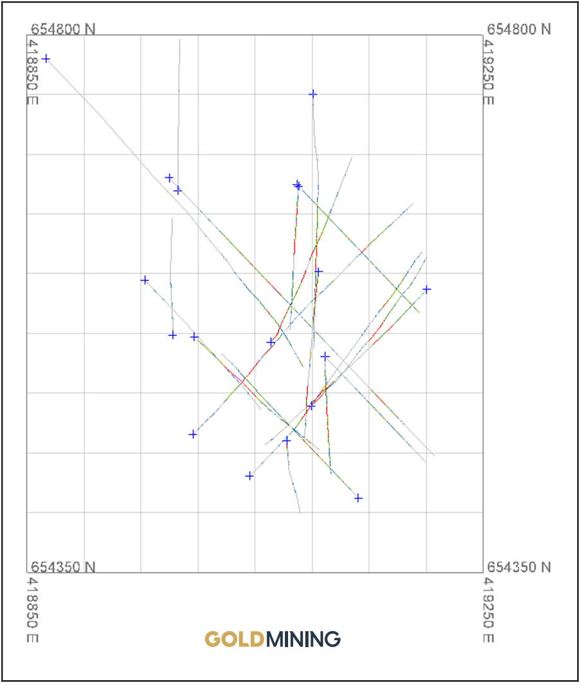
| Metal Mining Consultants Inc. Effective Date July 6, 2021 |
 |
| GoldMining Inc. NI 43-101 Report – La Mina Project |
Page 139 |
Figure 14‑2 Isometric View La Cantera Drilling - Not to Scale
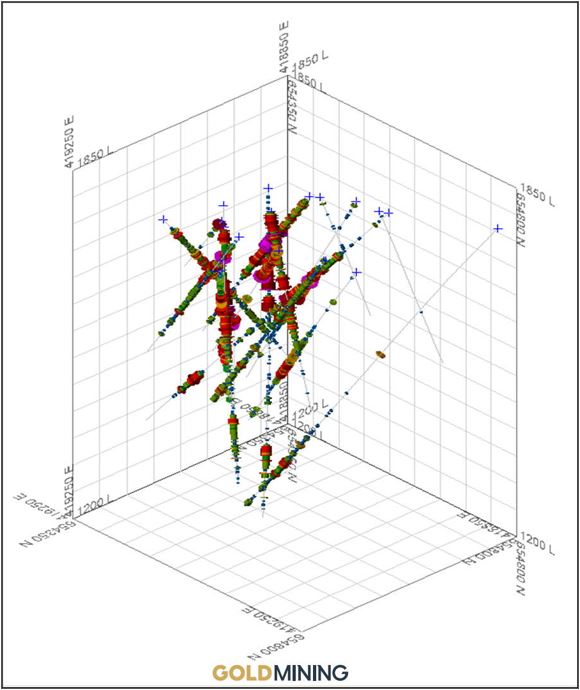
| Metal Mining Consultants Inc. Effective Date July 6, 2021 |
 |
| GoldMining Inc. NI 43-101 Report – La Mina Project |
Page 140 |
Figure 14‑3 Distribution of Lithology
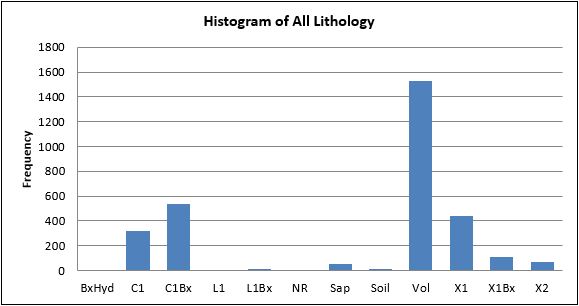
Figure 14‑4 Distribution of Major Lithologies at La Cantera
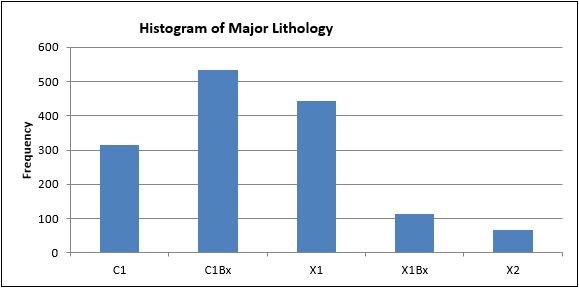
| Metal Mining Consultants Inc. Effective Date July 6, 2021 |
 |
| GoldMining Inc. NI 43-101 Report – La Mina Project |
Page 141 |
Figure 14‑5 Incremental Histogram for La Cantera Gold Data
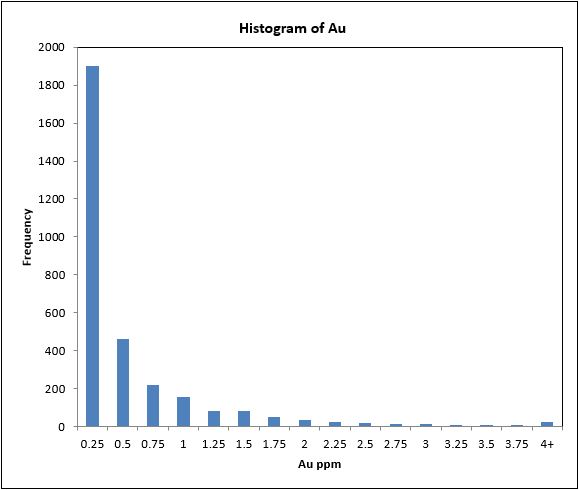
| Metal Mining Consultants Inc. Effective Date July 6, 2021 |
 |
| GoldMining Inc. NI 43-101 Report – La Mina Project |
Page 142 |
Figure 14‑6 Incremental Histogram for La Cantera Silver Data
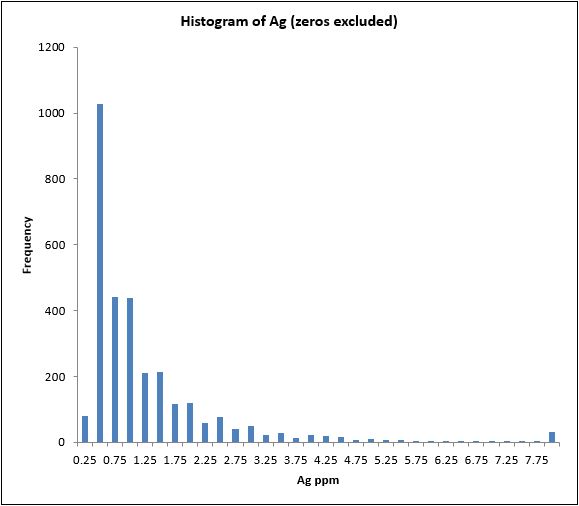
| Metal Mining Consultants Inc. Effective Date July 6, 2021 |
 |
| GoldMining Inc. NI 43-101 Report – La Mina Project |
Page 143 |
Figure 14‑7 Incremental Histogram for La Cantera Copper Data
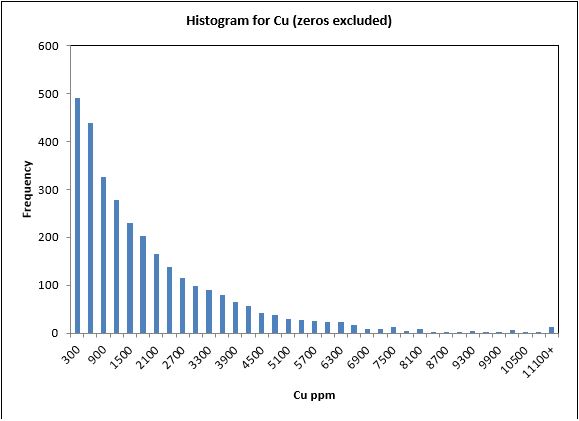
|
14.2.2 |
GEOLOGIC MODEL |
Bellhaven created the first set of sections, a total of 12, for the La Cantera area. These sections were hand drawn on maps that had drill-hole traces plotted. The sections were a combination of North, North-East by South-West and North-West by South-East bearing sections. Figure 14.8 is a sample of one of these sections. Figure 14.9 illustrates the section layout at La Cantera, and the 12 sections that included interpreted geology.
The four main lithology types in the La Cantera area were grouped into two lithology groups for the purpose of the Vulcan geologic model. The C1 and C1Bx types were grouped together into a C group and X1 and X1Bx were group into the X group. The C1 and C1Bx types were determined to have the same mineral composition, as were the X1 and X1Bx types. A third group was created to account for mineralization in the volcanic host rock. The C group is the primary group of interest, as it is the most mineralized with the highest grades. The X and Volcanic groups are also mineralized, but not to the same extent as the C group.
In Vulcan, the C group and X group lithologies were modeled in bench sections every 50 m to a depth of 450 m. The geologic interpretation for each bench was made using the section profile intercepts at each bench, along with intercepts of diamond drilling. Based on the author’s experience with porphyry mineral deposits in the Cauca Belt, it can be reasonably assumed that the porphyry flares out at depth. This interpretation of the porphyry shape increases the potential volume of mineralized C-type porphyry, but it also proportionally increases the volume of barren X-group porphyry. Current drilling shows the pipe to be open at depth, however for this model a bottom depth of 600-m, or the 1050-m elevation, was chosen as a limit to grade estimation. Anything deeper than this is too speculative for grade estimation or geological inference.
| Metal Mining Consultants Inc. Effective Date July 6, 2021 |
 |
| GoldMining Inc. NI 43-101 Report – La Mina Project |
Page 144 |
While there is limited sampling to support grade estimate to the depth of 650-m, the grade of copper and gold in the porphyry is robust to the bottom of the data set, and the geostatistics indicate very high vertical continuity of the porphyry mineralization. Therefore, it is reasonably assumed that mineralization can be projected to 650-m depth. Additional drilling will be required to verify the depth and extent of the pipe, the geological continuity of the rock units and the grade continuity of the porphyry. Figure 14.10 illustrates the shape of the breccia pipe and the bench polygons used to create the geologic wireframes. The outer polygons displayed in orange represent the C lithology group, while the inner polygons colored in purple represent the mostly barren X group.
Figure 14.11 includes the addition of a volcanic zone group, which is a 50-m buffer from the C type lithology. Drilling results indicate that the volcanic host rock around the breccia pipe could be mineralized within 50-m of the contact with the porphyry. Figure 14.12 illustrates the wireframes created from the bench polygons that were used to flag lithology boundaries in the block model, which will ultimately affect grade estimation parameters.
| Metal Mining Consultants Inc. Effective Date July 6, 2021 |
 |
| GoldMining Inc. NI 43-101 Report – La Mina Project |
Page 145 |
Figure 14‑8 Bellhaven Geologic Interpretation Section LC419105
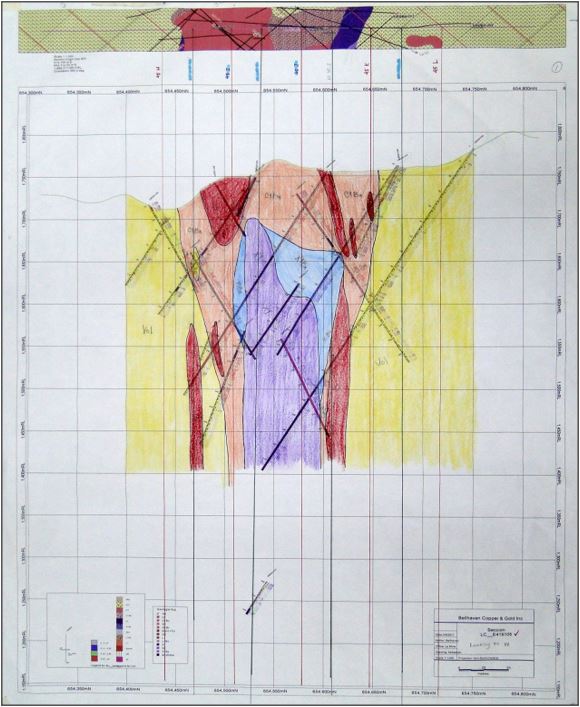
| Metal Mining Consultants Inc. Effective Date July 6, 2021 |
 |
| GoldMining Inc. NI 43-101 Report – La Mina Project |
Page 146 |
Figure 14‑9 Bellhaven Sections with Geologic Interpretation for La Cantera
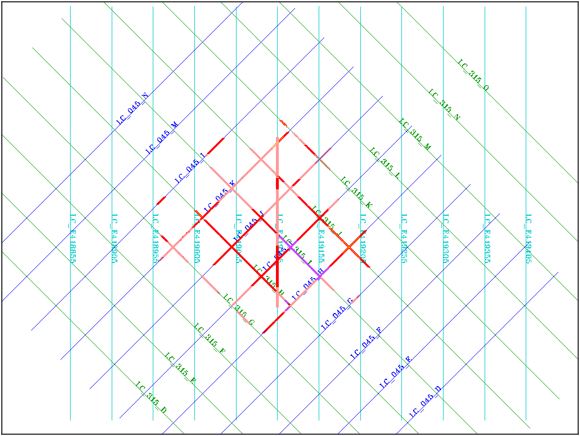
| Metal Mining Consultants Inc. Effective Date July 6, 2021 |
 |
| GoldMining Inc. NI 43-101 Report – La Mina Project |
Page 147 |
Figure 14‑10 Bench Section Profiles of C and X in Vulcan
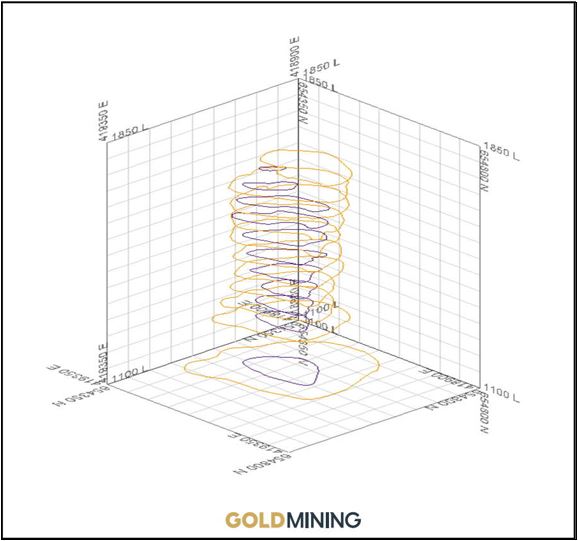
| Metal Mining Consultants Inc. Effective Date July 6, 2021 |
 |
| GoldMining Inc. NI 43-101 Report – La Mina Project |
Page 148 |
Figure 14‑11 Bench Section Profiles Including Volcanic Buffer
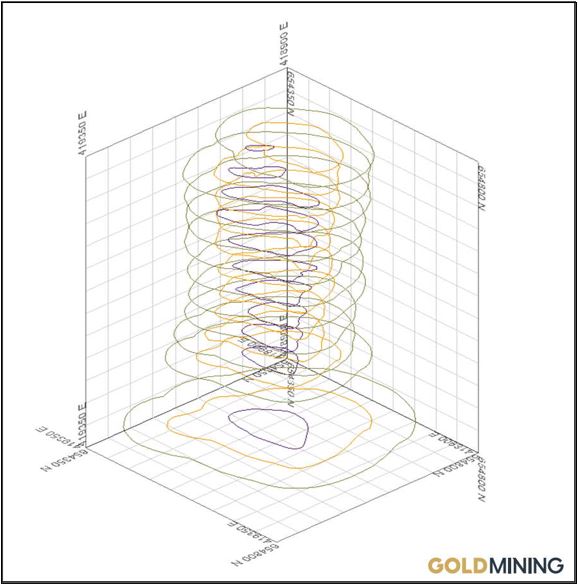
| Metal Mining Consultants Inc. Effective Date July 6, 2021 |
 |
| GoldMining Inc. NI 43-101 Report – La Mina Project |
Page 149 |
Figure 14‑12 Wireframes of C, X and Volcanic Boundaries
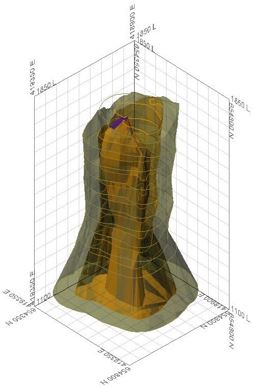 |
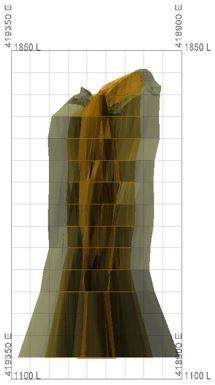 |
|
14.2.3 |
TOPOGRAPHY |
GoldMining provided 2-m contours for the La Cantera area. This was used to create a surface wireframe in Vulcan to represent the surface topography. The topography was used to limit the surface extent of the C and X group wireframes.
|
14.2.4 |
BLOCK MODEL |
A block model was created in Vulcan for the La Cantera area of La Mina. The block model utilizes parent and sub-blocking methods to best define the geologic interpretations in the block model. The parent block size for the La Cantera block measure 10-m cubed, and the sub-blocks have a minimum size of 2-m cubed. Table 14.1 highlights the parameters used to build the La Cantera block model.
The block model included variables to store lithology, gold grade, copper grade, silver grade, distance to nearest gold sample, number of gold samples used, number of drill holes used and depth. The lithology wireframes for the C, X and Volcanic groups were used to flag the lithology codes in the block model variable for lithology. Figure 14.13 shows two slices through the block model showing blocks colored by lithology.
| Metal Mining Consultants Inc. Effective Date July 6, 2021 |
 |
| GoldMining Inc. NI 43-101 Report – La Mina Project |
Page 150 |
Table 14‑1 La Cantera Block Model Parameters
|
Parameter |
X |
Y |
Z |
|
Origin |
418,600 |
6,540,000 |
1,150 |
|
Extent |
419,800 |
6,553,000 |
2,100 |
|
Parent Block Size |
10 |
10 |
10 |
|
Sub-Block Minimum Size |
2 |
2 |
2 |
|
Bearing |
Plunge |
Dip |
|
|
Rotation |
90 |
0 |
0 |
| Metal Mining Consultants Inc. Effective Date July 6, 2021 |
 |
| GoldMining Inc. NI 43-101 Report – La Mina Project |
Page 151 |
Figure 14‑13 Block Model Showing Lithology of La Cantera
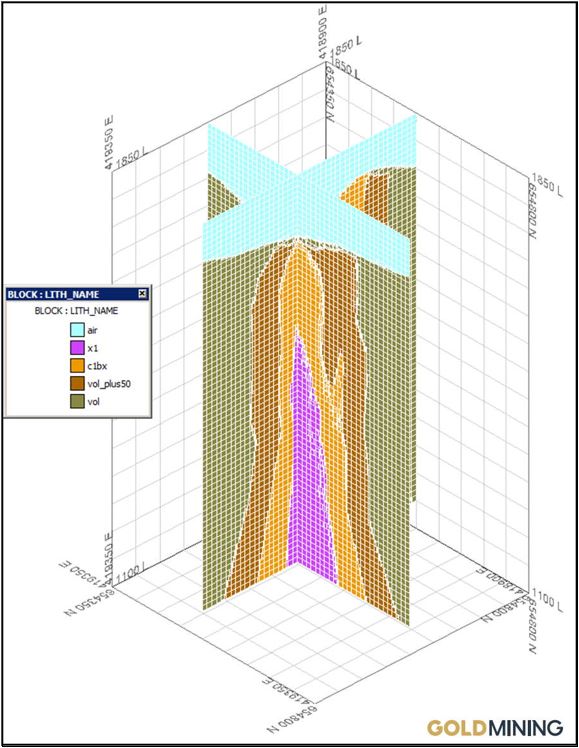
| Metal Mining Consultants Inc. Effective Date July 6, 2021 |
 |
| GoldMining Inc. NI 43-101 Report – La Mina Project |
Page 152 |
|
14.2.5 |
GRADE ESTIMATION |
Based on variography, ordinary Kriging was used to estimate grades in the block model. Kriging yields the best unbiased estimate at each individual model block location. Three estimations were setup for each element; one for each lithology group. Gold, copper and silver grades were estimated into the block model. For each estimation run the block selection was restricted to within the respective lithology group. Hard boundaries were also set for estimations to restrict samples used; only samples matching the respective lithology group could be used for grade estimation. For all estimations, sample intervals were only used if they were greater than 1.5 m in length. The search parameters were the same for estimates of gold, silver and copper. A minimum of 3 samples was required to estimate a block, and no more than 21 samples were used per block. No more than 3 samples from a single drill hole were allowed per estimated bock. For ordinary Kriging estimation, the nugget value was set to 0.184. Table 14.2 outlines the parameters used for ordinary Kriging. Figure 14.14 shows a section through the search ellipsoid showing the strong vertical continuity and anisotropy of the mineralization.
Table 14‑2 Parameters for Ordinary Kriging Based on Nested Variography
|
Model Type |
Sill Differential |
Bearing (Rot. About Z) |
Plunge (Rot. About Y) |
Dip (Rot. About X) |
Major Axis |
Semi- Major Axis |
Minor Axis |
|
Spherical |
0.137 |
48 |
17 |
-27 |
23 |
70 |
135 |
|
Spherical |
0.269 |
56 |
-11 |
-3 |
118 |
32 |
290 |
| Metal Mining Consultants Inc. Effective Date July 6, 2021 |
 |
| GoldMining Inc. NI 43-101 Report – La Mina Project |
Page 153 |
Figure 14‑14 La Cantera Ellipsoids
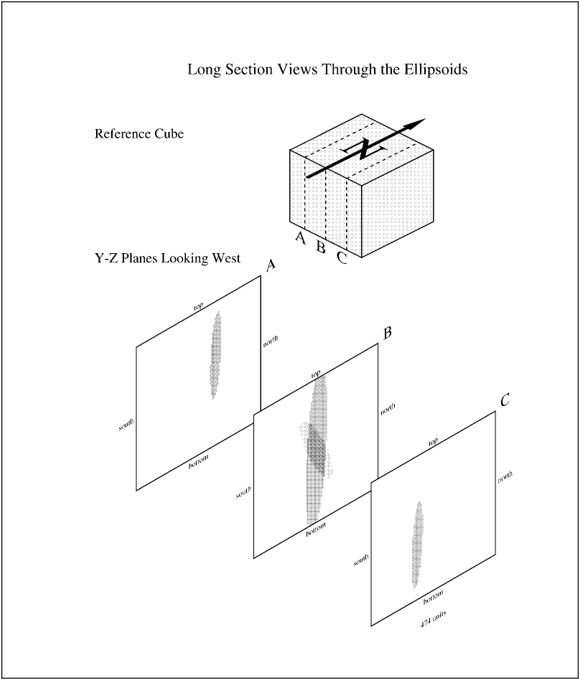
| Metal Mining Consultants Inc. Effective Date July 6, 2021 |
 |
| GoldMining Inc. NI 43-101 Report – La Mina Project |
Page 154 |
Figure 14‑15 La Cantera Block Model Slice Showing Pit Constrained Au Estimated Grades
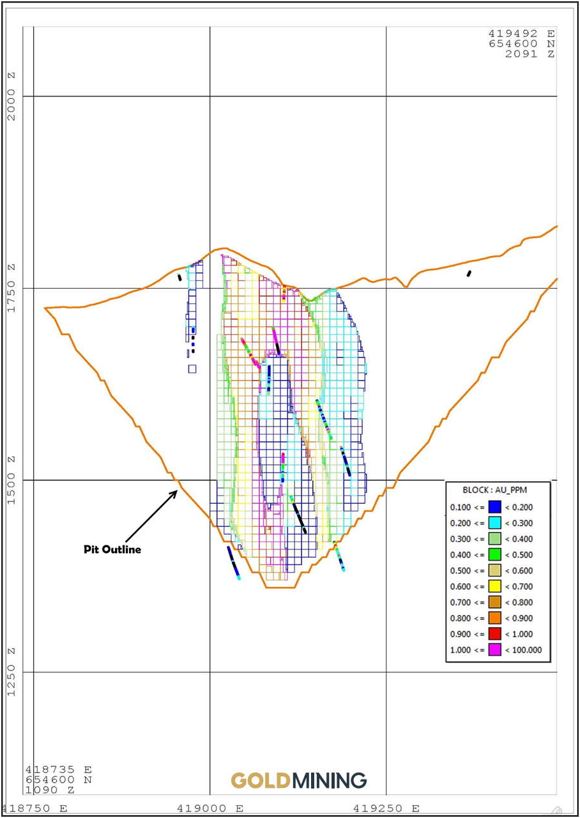
| Metal Mining Consultants Inc. Effective Date July 6, 2021 |
 |
| GoldMining Inc. NI 43-101 Report – La Mina Project |
Page 155 |
Figure 14‑16 La Cantera Block Slice Showing Pit Constrained Cu Estimated Grades
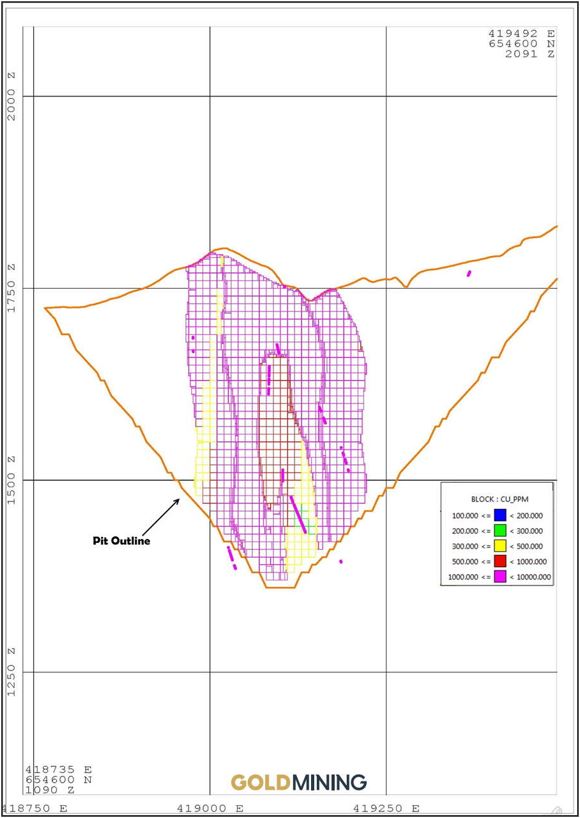
| Metal Mining Consultants Inc. Effective Date July 6, 2021 |
 |
| GoldMining Inc. NI 43-101 Report – La Mina Project |
Page 156 |
|
14.2.6 |
BLOCK MODEL VALIDATION |
The author has undertaken a thorough validation of the resultant interpolated model in order to confirm the estimation parameters, to check that the model represents the input data on both local and global scales, and to check that the estimate is not biased.
Visual validation provides a local validation of the interpolated block model on a local block scale, using visual assessments and validation plots of sample grades verses estimated block grades. A thorough visual inspection of cross-sections, long-sections and bench/level plans, comparing the sample grades with the block grades has been undertaken, which demonstrates good correlation between local block estimates and nearby samples, without excessive smoothing in the block model.
Figures 14.15 and 14.16 demonstrate that Au and Cu mineralization estimates were constrained by geological shapes. At the deeper portions of the model, the distribution of the estimated grades is not propagated into the outer volcanic halo or into the mostly barren X1 core. Based on geology and geophysics, the interpretation in this district is that these near surface mineralized porphyries are apotheoses of deeper, larger intrusive bodies. The interpreted shape of the La Cantera porphyries used in this model is a reasonable representation of that interpretation. While mineralization appears to continue below the limits of this model to depth, GoldMining will need to drill several deep holes in order to support any estimation of grades below the 1050-m level.
|
14.2.7 |
DENSITY |
A density of 2.7 tonnes per cubic meter was used for the tonnage estimates, based on daily measurements performed by Bellhaven geologists on drill-core samples (e.g., the observed global density for La Cantera is 2.714 t/cu m based on 100 determinations from drill holes LM-DDH-019 as well as LM-DDH-027).
|
14.2.8 |
INFERRED AND INDICATED MINERAL RESOURCES |
The geology, deposit type, and mineralogy at La Cantera are well understood. Indicated Mineral Resources are defined as estimated mineralization within 35 meters of a mineralized composite. An additional constraint was that the estimation within 35 m had to come from a minimum of two drill holes. The drilling density at 35 m, combined with the estimation search and number of drillholes, established continuity of identified mineralization within the deposit. Additionally, recent metallurgical testing has allowed the QP confidence to classify mineralization as Indicated Mineral Resources. Table 14.3 shows the different cutoff grades and the associated tonnes, ounces and pounds for the La Cantera deposit constrained by pit designs.
A gold price of US$ 1,600 per ounce, a processing cost of US$ 8.10/ tonne, and a gold recovery of 93% to determine cut-off grades and pit limits. Copper was not used in the determination of the cut-off grade. Due to the uncertainty of gold prices and recovery, the author recommends that a base cut-off grade of 0.25 g/t Au is appropriate for reporting resources for the La Cantera deposit. Given the style of mineralization, the author is of the opinion that the entire mineral deposit, as currently modeled, has a reasonable likelihood of economic extraction by openpit mining the La Cantera Resource Estimates.
| Metal Mining Consultants Inc. Effective Date July 6, 2021 |
 |
| GoldMining Inc. NI 43-101 Report – La Mina Project |
Page 157 |
Table 14‑3 Pit Constrained Resources for La Cantera
|
Cut-off |
Metric |
Pit Constrained Resources |
|||
| Grad (g/t Au) |
Tonnes ('000) |
Au |
Ag |
Cu |
AuEq |
|
Indicated Resources |
|||||
|
0.15 |
24,300 |
0.69 |
1.79 |
0.27 |
1.09 |
|
0.20 |
20,462 |
0.79 |
1.96 |
0.30 |
1.23 |
|
0.25 |
18,024 |
0.86 |
2.05 |
0.32 |
1.33 |
|
0.30 |
16,449 |
0.92 |
2.14 |
0.33 |
1.41 |
|
0.35 |
15,050 |
0.98 |
2.22 |
0.34 |
1.48 |
|
Inferred Resources |
|||||
|
0.15 |
15,657 |
0.58 |
1.62 |
0.26 |
0.96 |
|
0.20 |
13,413 |
0.65 |
1.75 |
0.28 |
1.06 |
|
0.25 |
12,034 |
0.69 |
1.84 |
0.29 |
1.13 |
|
0.30 |
11,028 |
0.73 |
1.91 |
0.30 |
1.18 |
|
0.35 |
9,858 |
0.78 |
1.97 |
0.32 |
1.25 |
Table 14‑4 Total Resources with 0.25 g/t Cut-off for La Cantera
|
|
Metric |
Grades |
Contained Metal |
||||||
| Deposit | Tonnes (‘000) |
Au (g/t) |
Ag (g/t) |
Cu (%) |
AuEq (g/t) |
Au (oz) |
Ag (oz) |
Cu (lbs, ‘000) |
AuEq (oz) |
|
Indicated Resources |
|||||||||
|
La Cantera |
18,024 |
0.86 |
2.05 |
0.32 |
1.33 |
498,346 |
1,187,917 |
125,586 |
769,033 |
|
Inferred Resources |
|||||||||
|
La Cantera |
12,034 |
0.69 |
1.84 |
0.29 |
1.12 |
266,956 |
711,883 |
78,190 |
435,123 |
|
14.3 |
MIDDLE ZONE RESOURCE ESTIMATION |
|
14.3.1 |
DATABASE FOR GEOLOGIC MODEL |
The drill-hole database for the Middle Zone resource estimation was provided by GoldMining in digital format and was imported into Vulcan modeling software. The database is inclusive of all 106 drill holes, including the 54 drill holes (Figure 14.17, 14.18) that pertain to the Middle Zone deposit. Table 14.5 outlines the data in the drill-hole database provided by GoldMining.
The 54 holes for the Middle Zone contain 8,955 assay intervals and lithology records, with an average interval length of 1.99 m. The assay table contains assays of 34 elements; and the lithology table contains 16 different lithology types. Figures 14.19 through 14.23 illustrate the distribution of lithology groups in the Middle Zone area only.
Table 14‑5 Total Project Drill Holes
|
Area |
Drill Holes |
Meters |
|
La Cantera |
26 |
8,327 |
|
Middle Zone |
54 |
18,803 |
|
El Limon |
9 |
2,923 |
|
La Garrucha |
17 |
6,641 |
| Metal Mining Consultants Inc. Effective Date July 6, 2021 |
 |
| GoldMining Inc. NI 43-101 Report – La Mina Project |
Page 158 |
Figure 14‑17 Plan View of Middle Zone Drilling
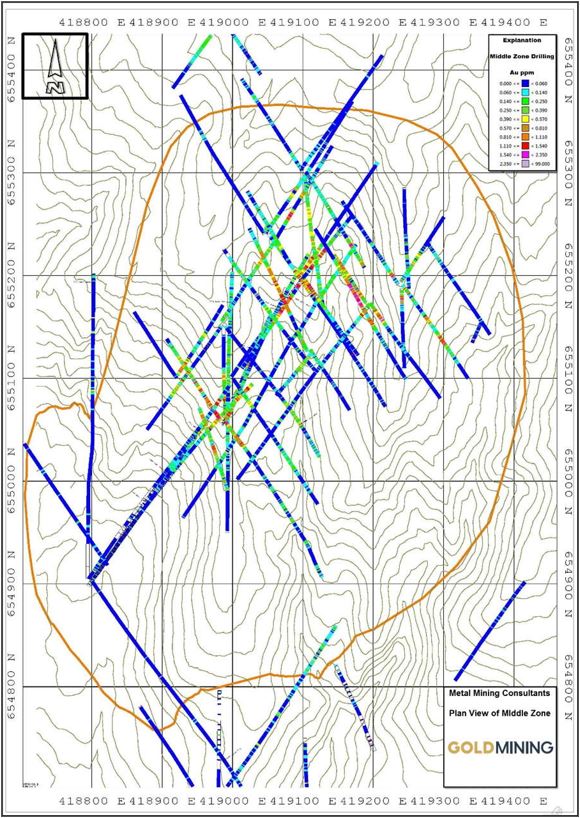
| Metal Mining Consultants Inc. Effective Date July 6, 2021 |
 |
| GoldMining Inc. NI 43-101 Report – La Mina Project |
Page 159 |
Figure 14‑18 Isometric View of Middle Zone Drilling
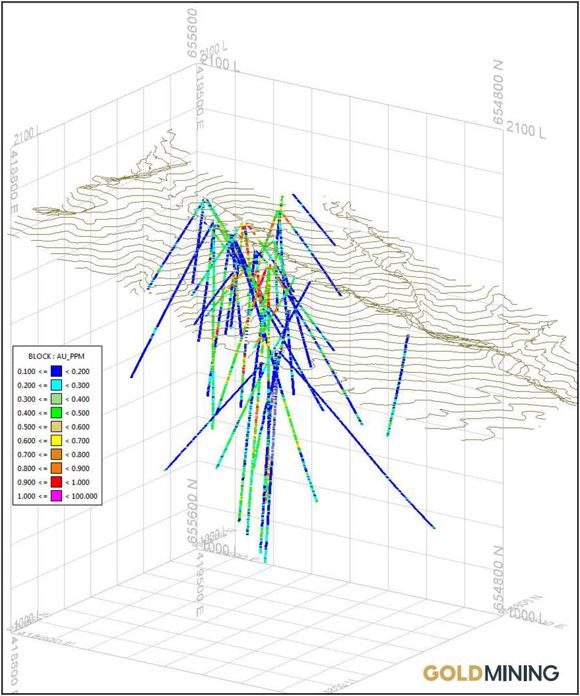
| Metal Mining Consultants Inc. Effective Date July 6, 2021 |
 |
| GoldMining Inc. NI 43-101 Report – La Mina Project |
Page 160 |
Figure 14‑19 Distribution of Lithology - Middle Zone
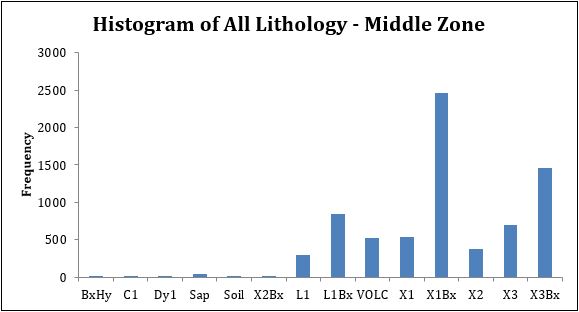
Figure 14‑20 Distribution of Major Lithologies - Middle Zone
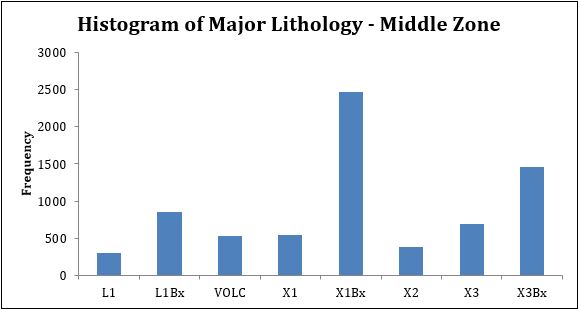
| Metal Mining Consultants Inc. Effective Date July 6, 2021 |
 |
| GoldMining Inc. NI 43-101 Report – La Mina Project |
Page 161 |
Figure 14‑21 Histogram for Middle Zone Gold Data
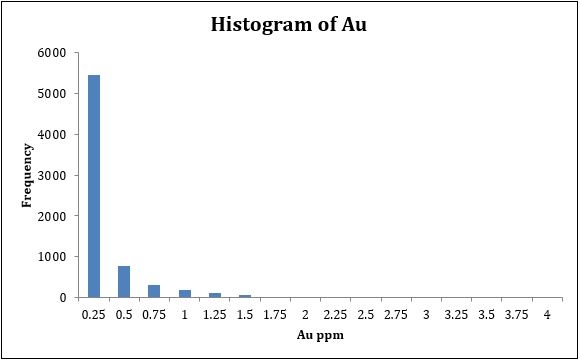
Figure 14‑22 Histogram of Silver Data - Middle Zone
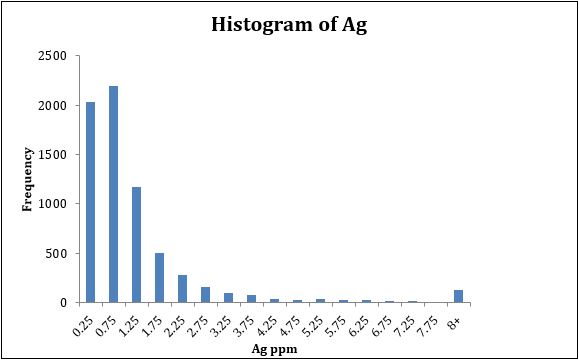
| Metal Mining Consultants Inc. Effective Date July 6, 2021 |
 |
| GoldMining Inc. NI 43-101 Report – La Mina Project |
Page 162 |
Figure 14‑23 Histogram of Copper Data - Middle Zone
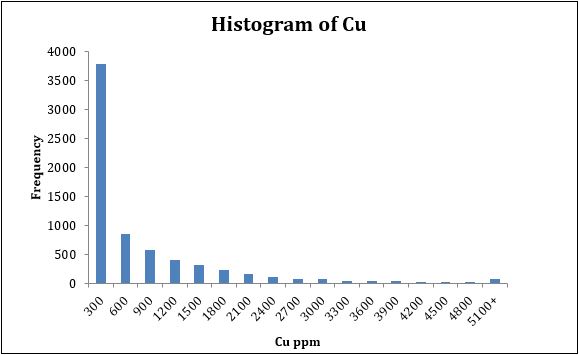
|
14.3.2 |
GEOLOGIC MODEL |
Bellhaven created the first set of sections, a total of 15, for the Middle Zone area. These sections were hand drawn on maps that had drill-hole traces plotted. The sections were a combination of North, North-East by South-West and North-West by South-East bearing sections. Figure 14.24 is a sample of one of these sections. Bellhaven subsequently digitized each section into ArcView Software in 3D. GoldMining provided these digitized geologic sections which were then imported into Vulcan for further modeling. Figure 14.25 illustrates the section layout at Middle Zone, and the 15 sections that included interpreted geology.
Eight out of the nine lithology types in the Middle Zone area were grouped into five lithology groups for the purpose of the Vulcan geologic model. The L1 and L1Bx types were grouped together as L1; X1 and X1Bx were grouped together as X1; X2 and X2Bx were grouped together as X2; and X3 and X3bx were grouped together as X3. The L1 and L1Bx types were determined to have the same mineral composition, as were the X1 and X1Bx, X2 and X2Bx, X3 and X3Bx types. The Volcanic (Volc) lithology group represents the host rock and was modeled to account for mineralization in this lithology. The X2 group represents the non-mineralized barren core of the deposit and was modeled. The principle lithology groups (L1, X1, X3) are the primary groups of interest, as they are the most mineralized with the highest grades.
In Vulcan, all the lithologies were modeled in bench sections every 20 m to a depth of 820 m or to 1,050 mamsl. The geologic interpretation for each bench was made using the GoldMining section profile intercepts at each bench, along with diamond drilling intercepts. Current drilling shows the deposit to be open at depth, however for this model a bottom depth of 880 m, or 1,060 m elevation, was chosen. Further drilling will be required to determine the depth extent and boundaries of the body at depth. Figure 14.26 illustrates the shape of the porphyries and related breccias and the bench polygons used to create the geologic wireframes. The outer polygons displayed in blue represent X3, the middle polygons displayed in grey represent X1, while the inner polygons colored in magenta represent X2, the barren core.
Figure 14.27 includes the addition of the outer L1 and Volc lithologies. Drilling has indicated there is mineralization present in the Volc lithology; however, the bulk of mineralization is hosted in the inner core (X1, X3, L1). Figures 14.28 and 14.29 illustrate the wireframes created from the bench polygons that were used to flag lithology boundaries in a block model, which will ultimately affect grade estimation parameters.
| Metal Mining Consultants Inc. Effective Date July 6, 2021 |
 |
| GoldMining Inc. NI 43-101 Report – La Mina Project |
Page 163 |
Figure 14‑24 Bellhaven Geologic Interpretation Section MZ_315_J
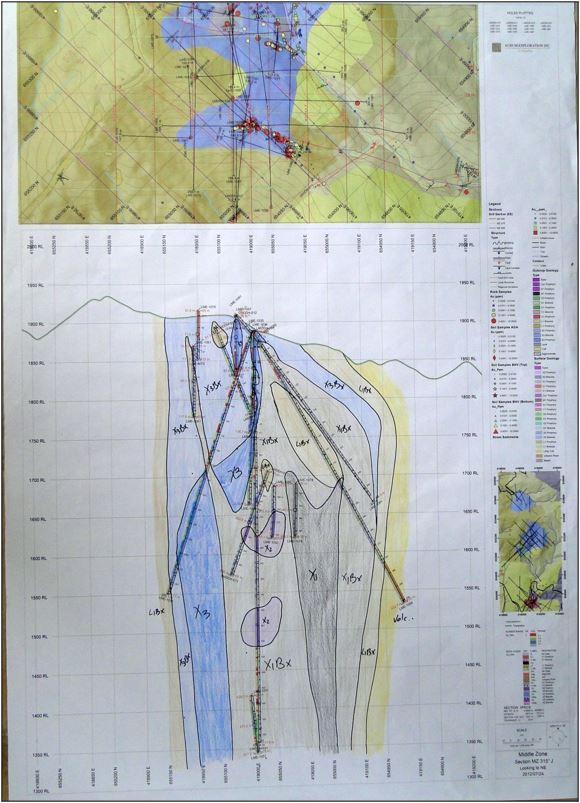
| Metal Mining Consultants Inc. Effective Date July 6, 2021 |
 |
| GoldMining Inc. NI 43-101 Report – La Mina Project |
Page 164 |
Figure 14‑25 Middle Zone Sections with Geologic Interpretation
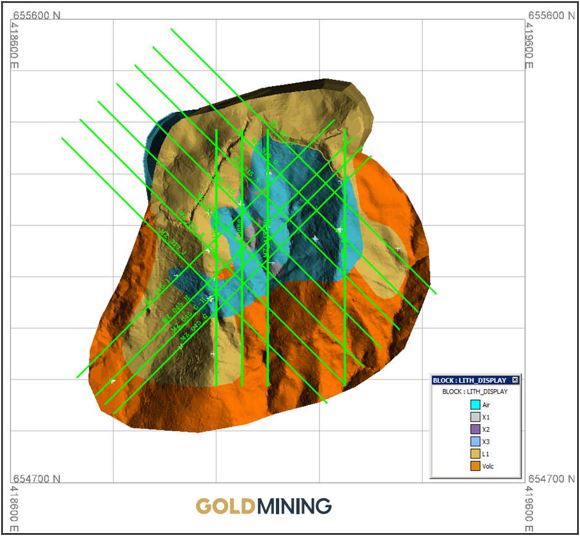
| Metal Mining Consultants Inc. Effective Date July 6, 2021 |
 |
| GoldMining Inc. NI 43-101 Report – La Mina Project |
Page 165 |
Figure 14‑26 Bench Section Profiles of X1, X2 and X3
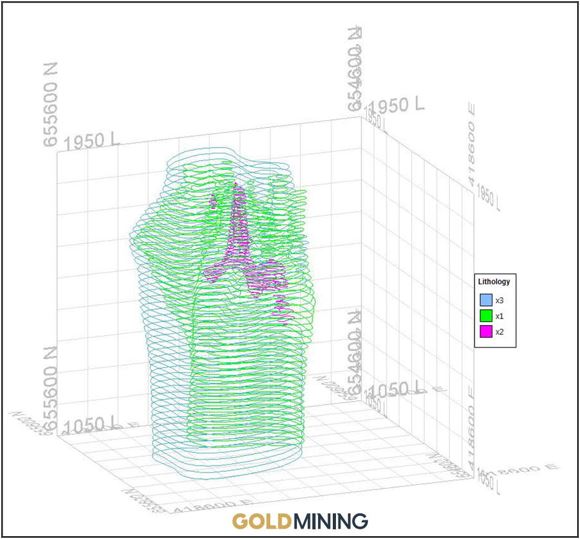
| Metal Mining Consultants Inc. Effective Date July 6, 2021 |
 |
| GoldMining Inc. NI 43-101 Report – La Mina Project |
Page 166 |
Figure 14‑27 Bench Section Profiles including L1 and Volcanic Lithologies
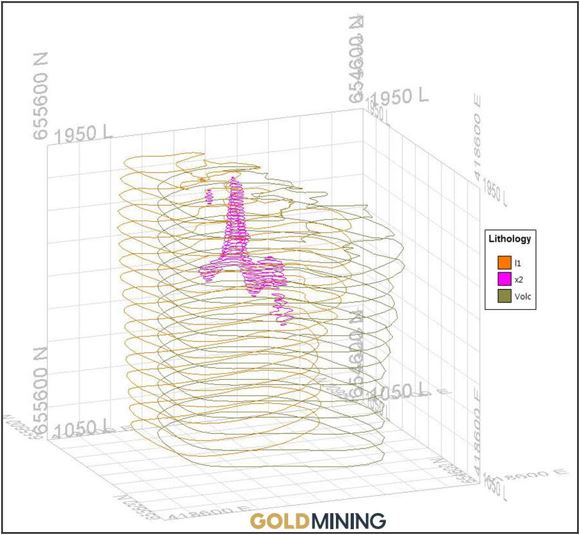
| Metal Mining Consultants Inc. Effective Date July 6, 2021 |
 |
| GoldMining Inc. NI 43-101 Report – La Mina Project |
Page 167 |
Figure 14‑28 Wireframes of X1, X2 and X3 Boundaries
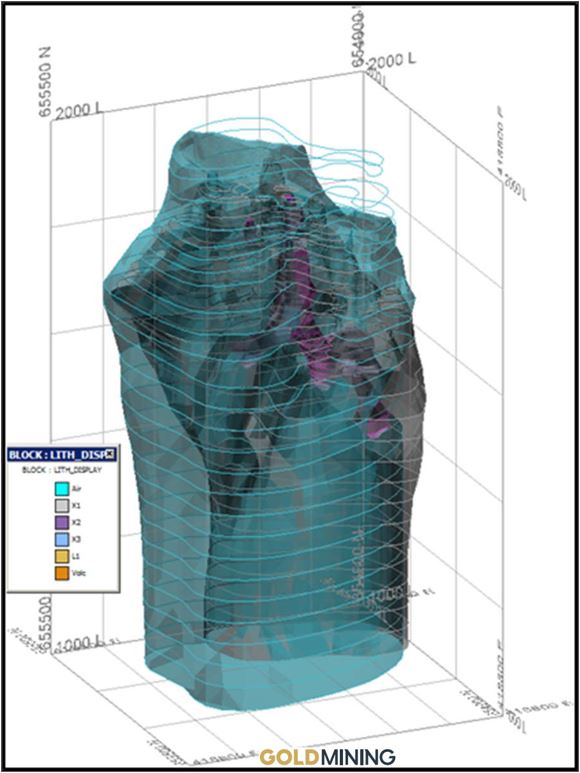
| Metal Mining Consultants Inc. Effective Date July 6, 2021 |
 |
| GoldMining Inc. NI 43-101 Report – La Mina Project |
Page 168 |
Figure 14‑29 Wireframes of L1, Volc, X3 and X1 Boundaries
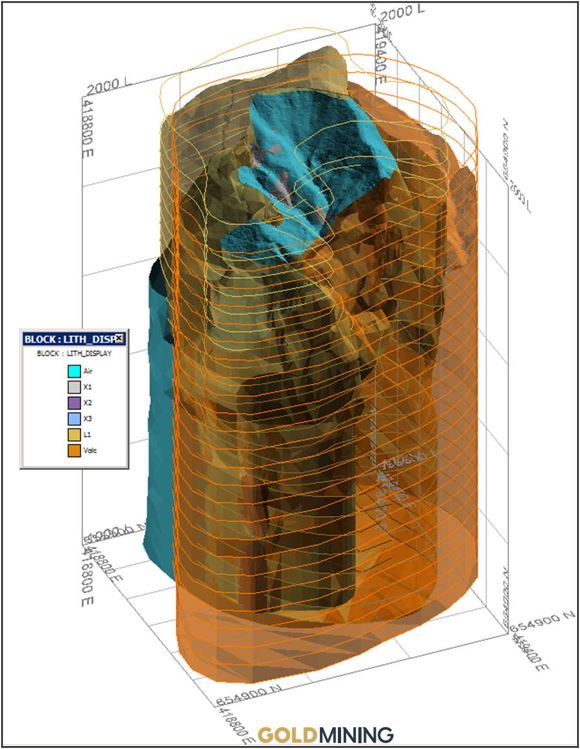
| Metal Mining Consultants Inc. Effective Date July 6, 2021 |
 |
| GoldMining Inc. NI 43-101 Report – La Mina Project |
Page 169 |
|
14.3.3 |
TOPOGRAPHY |
GoldMining provided 2-m contours for the entire La Mina resource area. This was used to create a surface wireframe in Vulcan to represent the surface topography. The topography was used to limit the surface extent of the X1, X2, X3, L1 and Volcanic wireframes. Drill hole collar survey information matches well with the digital topography used to constrain the model.
|
14.3.4 |
BLOCK MODEL |
A block model was created in Vulcan for the Middle Zone area of La Mina. The block model utilizes parent blocking methods to best define the geologic interpretations in the block model. The parent block size for the Middle Zone block measure 5-m cubed. Table 14.6 highlights the parameters used to build the Middle Zone block model.
Table 14‑6 Middle Zone Block Parameters
|
Parameter |
X |
Y |
Z |
|
Origin |
418,730 |
654,750 |
1,100 |
|
Extent |
419,450 |
655,500 |
2,100 |
|
Parent Block Size |
5 |
5 |
5 |
The block model included variables to store lithology, gold grade, copper grade, silver grade, distance to nearest gold sample, number of gold samples used, number of drill holes used, and depth.
The wireframes for the X1, X2, X3, L1 and Volcanic lithologies were used to flag the lithology codes in the block model variable for lithology. Figure 14.30 shows a slice through the block model with blocks colored by lithology.
| Metal Mining Consultants Inc. Effective Date July 6, 2021 |
 |
| GoldMining Inc. NI 43-101 Report – La Mina Project |
Page 170 |
Figure 14‑30 Block Model showing Lithology of Middle Zone
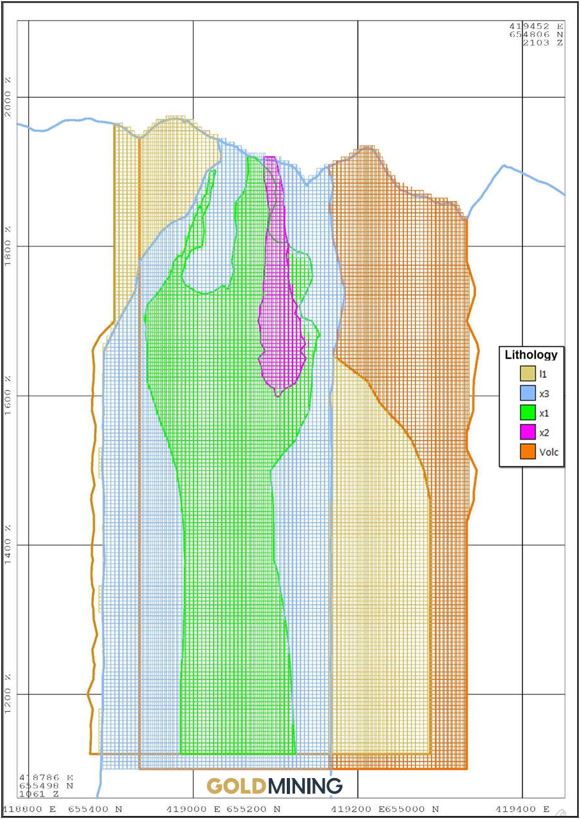
| Metal Mining Consultants Inc. Effective Date July 6, 2021 |
 |
| GoldMining Inc. NI 43-101 Report – La Mina Project |
Page 171 |
|
14.3.5 |
GRADE ESTIMATION |
Grades were estimated into the block model by using inverse distance interpolation. Variances were calculated to the 2nd power or Inverse Distance Squared. A minimum of 1 sample and a maximum of 15 samples were used for the estimation of contained metal (Au, Ag, Cu) in the deposit. For each estimation run the block selection was restricted to respect lithology groups. The search parameters were the same for each estimate for gold, silver and copper. No more than 4 samples from a single drill hole were allowed per estimated bock.
The search ellipsoid parameters were:
|
● |
Major axis Radius: 140 m |
|
● |
Semi-major axis radius: 140 m |
|
● |
Minor axis radius: 65 m |
The ellipsoid has an orientation of
|
● |
Bearing: 45 degrees (rotation about the Z axis) |
|
● |
Plunge: 0 degrees (rotation about Y’ axis) |
|
● |
Dip: -90 degrees (rotation about X’ axis) |
The following cross sections show that the search parameters modeled the geological interpretation of the ore deposit. This gives confidence that the estimation was appropriate for the Middle Zone deposit.
Mineralization grades were capped prior to compositing. Lognormal probability plots were evaluated to determine the effect of outlier mineralization grades on the global estimate. This was done to limit biased grade estimates.
Table 14‑7 Middle Zone Capping Criteria
|
Maximum Assay Grade |
Grade Cap |
Average Grade Prior to Capping |
Average Grade after Capping |
|
|
Au |
13 ppm |
4.2 g/t |
0.232 |
0.229 |
|
Ag |
448 ppm |
25.5 |
0.69 |
0.68 |
|
Cu |
17,700 ppm |
3,000 ppm |
0.53 |
0.53 |
| Metal Mining Consultants Inc. Effective Date July 6, 2021 |
 |
| GoldMining Inc. NI 43-101 Report – La Mina Project |
Page 172 |
Figure 14‑31 Middle Zone Block Model Slice showing Pit Constrained Au Estimated Grades
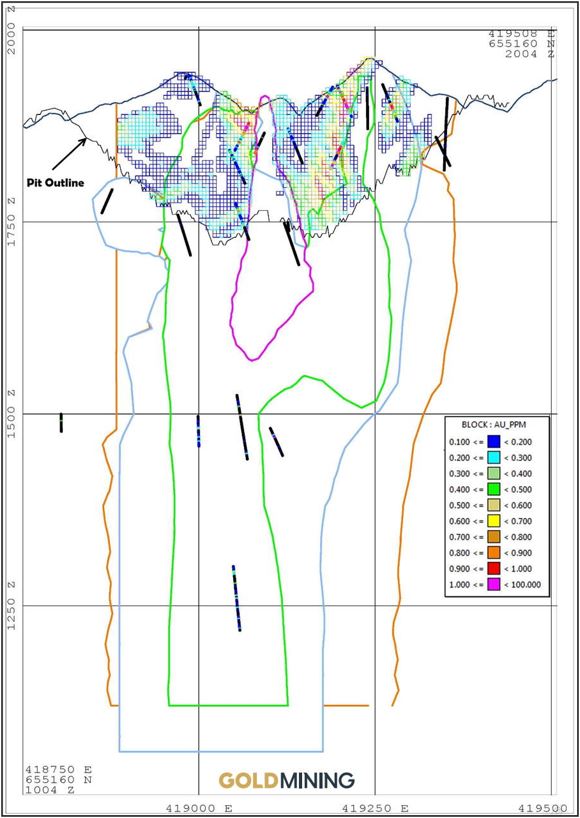
| Metal Mining Consultants Inc. Effective Date July 6, 2021 |
 |
| GoldMining Inc. NI 43-101 Report – La Mina Project |
Page 173 |
Figure 14‑32 Middle Zone Block Model Slice Showing Pit Constrained Cu Estimated Grades
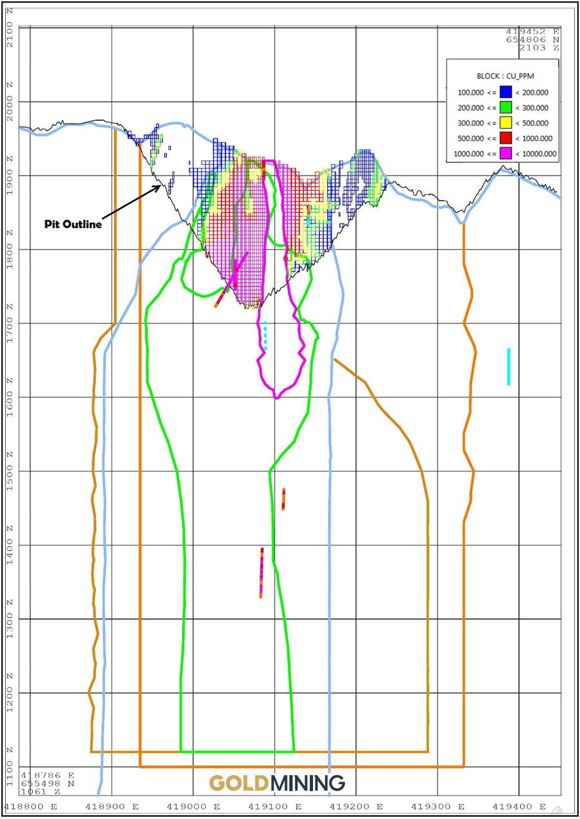
| Metal Mining Consultants Inc. Effective Date July 6, 2021 |
 |
| GoldMining Inc. NI 43-101 Report – La Mina Project |
Page 174 |
|
14.3.6 |
DENSITY |
A density of 2.65 tonnes per cubic meter was used for the tonnage estimates, based on 536 measurements performed by Bellhaven geologists on drill-core samples.
|
14.3.7 |
PIT CONSTRAINING OPTIMIZATION CRITERIA INCLUDING METALS PRICING USED |
The “reasonable prospects for eventual economic extraction” requirement generally implies that the quantity and grade estimates meet certain economic thresholds and that the mineral resources are reported at an appropriate cut-off grade that takes into account extraction scenarios and processing recoveries. The deposit gold mineralization is amenable for open-pit extraction. To determine the quantities of material offering “reasonable prospects for eventual economic extraction” by an open pit, the Lerch-Grossman algorithm was used, which constructs lists of related blocks that should or should not be mined. The final list defines a surface pit shell that has the highest possible total value, while honoring the required surface mine slope and economic parameters.
Economic parameters used in the analysis are based on the following general assumptions: Input parameters at US$ 1,600 per ounce gold price, supported by consensus long-term metal price forecast of industry analysts (as of June 2021), a processing cost of US$ 8.10/ tonne, and a recovery of 93% Au to determine the cut-off grade.
The average spot gold price during June 2021 was US$ 1,826 per ounce. The average spot copper price during this period was US$ 4.42 per pound. Bank of Montreal (BMO) conducted market research as of May 2021 of the gold and copper prices used by the industry to determine resources and reserves. Table 14-8 shows the results of the research for both gold and copper resources. Based on these figures, the author and GoldMining Inc. selected a gold price of US$ 1,600 per ounce and a copper price of US$ 3.25 per pound to estimate the resources and calculated gold equivalence at the La Mina Project for this technical report.
Table 14‑8 BMO Analysis of Metals Price Used for Determining Resources
|
Table 14-8 (May 2021) |
|||
|
Type |
Low |
Average |
High |
|
Gold Resource |
$1,250 |
$1,544 |
$1,800 |
|
Copper Resource |
$2.95 |
$3.32 |
$4.00 |
|
1From Gold and Copper Price Analysis, May 2021, The Bank of Montreal. |
|||
From 2018 to 2021, the gold price varied from a low of US$ 1,128 per ounce to a high of SU$ 2,064 per ounce with an average price of US$ 1,560 (3-year trailing average) per ounce and copper varied from a low of US$ 2.09 per pound to a high of US$ 4.86 with an average price of US$ 2.97 (3-year trailing average), which are in-line with the forecasts in the BMO Analysis shown in Table 14-8.
| Metal Mining Consultants Inc. Effective Date July 6, 2021 |
 |
| GoldMining Inc. NI 43-101 Report – La Mina Project |
Page 175 |
The parameters define a realistic basis to estimate the Mineral Resource for the La Mina Project. The Mineral Resource has been limited to mineralized material that occurs within the pit shells and that could be scheduled to be processed based on the defined cut-off grade.
|
14.3.8 |
INFERRED AND INDICATED MINERAL RESOURCES |
The geology, deposit type, and mineralogy at the Middle Zone is well understood. Nominal drill spacing in the upper portions of the deposit is approximately 50 m, but the drill density decreases below 300-m depth. There is sufficient information to classify the resources for the project into two categories of Inferred Mineral Resources and Indicated Mineral Resources. Indicated Mineral Resources are defined as estimated mineralization within 35 m of a mineralized composite. An additional constraint was that the estimation within 35 m had to come from a minimum of two drill holes. The drilling density at 35 m, combined with the estimation search and number of drill holes, established continuity of identified mineralization within the deposit. Additionally, recent metallurgical testing has allowed the QP confidence to classify mineralization as Indicated Mineral Resources.
A gold price of US$ 1,600 per ounce, a processing cost of US$ 8.10/ tonne and a gold recovery of 93% to determine the cut-off grade. Copper was not used in the determination of the cut-off grade. Due to the uncertainty of gold prices and recovery, it is recommended that a base cut-off grade of 0.25 g/t Au is appropriate to report resources for the Middle Zone Deposit. Again, the author did not complete an economic evaluation of this resource estimate. However, given the style of mineralization, the author is of the opinion that the entire mineral deposit, as currently modeled, has reasonable prospects of economic extraction by open pit. Resources are not reserves and do not have demonstrated economic viability. Colombia is actively promoting responsible development of mining projects. Based on work with several Colombia projects the author is unaware that these mineral resource estimates could be materially affected by any known environmental, permitting, legal, title, taxation, socio-economic, marketing, political, or other relevant factors.
Table 14‑9 Pit Constrained Resources for Middle Zone
|
Cut-off |
Metric |
Grades |
|||
| Grade (g/t Au) |
Tonnes ('000) |
Au |
Ag |
Cu |
AuEq |
|
Indicated Resources |
|||||
|
0.15 |
15,880 |
0.39 |
1.14 |
0.09 |
0.54 |
|
0.20 |
12,681 |
0.45 |
1.20 |
0.10 |
0.61 |
|
0.25 |
10,223 |
0.50 |
1.26 |
0.11 |
0.68 |
|
0.30 |
8,310 |
0.56 |
1.32 |
0.12 |
0.74 |
|
0.35 |
6,845 |
0.61 |
1.37 |
0.12 |
0.79 |
|
Inferred Resources |
|||||
|
0.15 |
3,578 |
0.28 |
1.08 |
0.07 |
0.39 |
|
0.20 |
2,446 |
0.33 |
1.12 |
0.08 |
0.46 |
|
0.25 |
1,599 |
0.39 |
1.17 |
0.09 |
0.53 |
|
0.30 |
1,038 |
0.46 |
1.22 |
0.10 |
0.61 |
|
0.35 |
717 |
0.52 |
1.25 |
0.10 |
0.68 |
| Metal Mining Consultants Inc. Effective Date July 6, 2021 |
 |
| GoldMining Inc. NI 43-101 Report – La Mina Project |
Page 176 |
Table 14‑10 Total Resources with 0.25g/t Cutoff for Middle Zone
|
|
Metric |
Grades |
Contained Metal |
||||||
| Deposit | Tonnes (‘000) |
Au (g/t) |
Ag (g/t) |
Cu (%) |
AuEq (g/t) |
Au (oz) |
Ag (oz) |
Cu (lbs, ‘000) |
AuEq (oz) |
|
Indicated Resources |
|||||||||
|
Middle Zone |
10,223 |
0.50 |
1.26 |
0.11 |
0.67 |
164,335 |
414,124 |
24,940 |
220,430 |
|
Inferred Resources |
|||||||||
|
Middle Zone |
1,599 |
0.39 |
1.17 |
0.09 |
0.53 |
20,049 |
60,147 |
3,056 |
27,045 |
|
14.4 |
LA MINA RESOURCES |
Table 14-11 and 14.12 show the combined resources for La Cantera and Middle Zone, at various cutoff grades, which combine to create the La Mina Project.
Table 14‑11 In-Pit Resources for La Mina Project (La Cantera and Middle Zone)
|
Cut-off |
Metric |
Grades |
Contained Metal |
||||||
| Grade (g/t Au) |
Tonnes (‘000) |
Au (g/t) |
Ag (g/t) |
Cu (%) |
AuEq (g/t) |
Au (oz) |
Ag (oz) |
Cu (lbs, ‘000) |
AuEq (oz) |
|
Indicated Resources |
|||||||||
|
0.15 |
40,180 |
0.57 |
1.53 |
0.20 |
0.87 |
738,170 |
1,980,446 |
178,315 |
1,126,365 |
|
0.20 |
33,143 |
0.66 |
1.67 |
0.22 |
0.99 |
703,166 |
1,778,625 |
163,489 |
1,058,599 |
|
0.25 |
28,247 |
0.73 |
1.76 |
0.24 |
1.09 |
662,680 |
1,602,040 |
150,526 |
989,463 |
|
0.30 |
24,759 |
0.80 |
1.86 |
0.26 |
1.18 |
636,142 |
1,484,367 |
140,058 |
940,117 |
|
0.35 |
21,895 |
0.86 |
1.95 |
0.27 |
1.27 |
608,421 |
1,375,655 |
130,397 |
891,346 |
|
Inferred Resources |
|||||||||
|
0.15 |
19,235 |
0.52 |
1.52 |
0.22 |
0.86 |
324,165 |
939,699 |
95,232 |
529,938 |
|
0.20 |
15,859 |
0.60 |
1.65 |
0.25 |
0.97 |
306,249 |
842,724 |
87,490 |
495,024 |
|
0.25 |
13,633 |
0.65 |
1.76 |
0.27 |
1.05 |
287,005 |
772,030 |
81,246 |
462,168 |
|
0.30 |
12,066 |
0.71 |
1.85 |
0.29 |
1.13 |
274,173 |
717,904 |
76,238 |
438,454 |
|
0.35 |
10,575 |
0.76 |
1.92 |
0.30 |
1.21 |
259,196 |
653,176 |
70,369 |
410,706 |
Table 14‑12 Total Indicated and Inferred Resources for La Mina Project (Cutoff Grade 0.25g/t Au)
|
|
Metric |
Grades |
Contained Metal |
||||||
| Deposit | Tonnes (‘000) |
Au (g/t) |
Ag (g/t) |
Cu (%) |
AuEq (g/t) |
Au (oz) |
Ag (oz) |
Cu (lbs, ‘000) |
AuEq (oz) |
|
Indicated Resources |
|||||||||
|
La Cantera |
18,024 |
0.86 |
2.05 |
0.32 |
1.33 |
498,346 |
1,187,917 |
125,586 |
769,033 |
|
Middle Zone |
10,223 |
0.50 |
1.26 |
0.11 |
0.67 |
164,335 |
414,124 |
24,940 |
220,430 |
|
Total Indicated |
28,247 |
0.73 |
1.76 |
0.24 |
1.09 |
662,680 |
1,602,040 |
150,526 |
989,463 |
|
Inferred Resources |
|||||||||
|
La Cantera |
12,034 |
0.69 |
1.84 |
0.29 |
1.12 |
266,956 |
711,883 |
78,190 |
435,123 |
|
Middle Zone |
1,599 |
0.39 |
1.17 |
0.09 |
0.53 |
20,049 |
60,147 |
3,056 |
27,045 |
|
Total Inferred |
13,633 |
0.65 |
1.76 |
0.27 |
1.05 |
287,005 |
772,030 |
81,246 |
462,168 |
| Metal Mining Consultants Inc. Effective Date July 6, 2021 |
 |
| GoldMining Inc. NI 43-101 Report – La Mina Project |
Page 177 |
|
14.4.1 |
BLOCK MODEL VALIDATION |
The author has undertaken a thorough validation of the resultant interpolated model in order to confirm the estimation parameters, to check that the model represents the input data on both local and global scales and to check that the estimate is not biased.
|
14.4.1.1 |
VISUAL VALIDATION |
Visual validation provides a local validation of the interpolated block model on a local block scale, using visual assessments and validation plots of sample grades verses estimated block grades. A thorough visual inspection of cross-sections, long-sections and bench/level plans, comparing the sample grades with the block grades has been undertaken, which demonstrates good correlation between local block estimates and nearby samples, without excessive smoothing in the block model.
| Metal Mining Consultants Inc. Effective Date July 6, 2021 |
 |
| GoldMining Inc. NI 43-101 Report – La Mina Project |
Page 178 |
|
15 |
MINERAL RESERVE ESTIMATES |
There are no mineral reserves categorized for the La Mina Project.
| Metal Mining Consultants Inc. Effective Date July 6, 2021 |
 |
| GoldMining Inc. NI 43-101 Report – La Mina Project |
Page 179 |
|
16 |
MINING METHODS |
Not applicable.
| Metal Mining Consultants Inc. Effective Date July 6, 2021 |
 |
| GoldMining Inc. NI 43-101 Report – La Mina Project |
Page 180 |
|
17 |
RECOVERY METHODS |
Not applicable.
| Metal Mining Consultants Inc. Effective Date July 6, 2021 |
 |
| GoldMining Inc. NI 43-101 Report – La Mina Project |
Page 181 |
|
18 |
PROJECT INRASTRUCTURE |
Not applicable.
| Metal Mining Consultants Inc. Effective Date July 6, 2021 |
 |
| GoldMining Inc. NI 43-101 Report – La Mina Project |
Page 182 |
|
19 |
MARKET STUDIES AND CONTRACTS |
Not applicable.
| Metal Mining Consultants Inc. Effective Date July 6, 2021 |
 |
| GoldMining Inc. NI 43-101 Report – La Mina Project |
Page 183 |
|
20 |
ENVIRONMENTAL STUDIES, PERMITTING AND SOCIAL OR COMMUNITY |
Not applicable.
| Metal Mining Consultants Inc. Effective Date July 6, 2021 |
 |
| GoldMining Inc. NI 43-101 Report – La Mina Project |
Page 184 |
|
21 |
CAPITAL AND OPERATING COSTS |
Not applicable.
| Metal Mining Consultants Inc. Effective Date July 6, 2021 |
 |
| GoldMining Inc. NI 43-101 Report – La Mina Project |
Page 185 |
|
22 |
ECONOMIC ANALYSIS |
Not applicable.
| Metal Mining Consultants Inc. Effective Date July 6, 2021 |
 |
| GoldMining Inc. NI 43-101 Report – La Mina Project |
Page 186 |
|
23 |
ADJACENT PROPERTIES |
There are no adjacent properties to La Mina that have published NI 43-101 technical reports.
| Metal Mining Consultants Inc. Effective Date July 6, 2021 |
 |
| GoldMining Inc. NI 43-101 Report – La Mina Project |
Page 187 |
|
24 |
OTHER RELEVANT DATA AND INFORMATION |
The author is not aware of any other information that would aid in the understanding of the La Mina Project or the La Cantera deposit.
| Metal Mining Consultants Inc. Effective Date July 6, 2021 |
 |
| GoldMining Inc. NI 43-101 Report – La Mina Project |
Page 188 |
|
25 |
INTERPRETATION AND CONCLUSIONS |
The authors reviewed pertinent data from the La Mina Project regarding exploration data and methods for the La Cantera and Middle Zone Deposits. The technical work summarized herein conforms to practices established by CIM Definition Standards (2010). It is concluded that:
|
● |
The geology of the La Cantera and Middle Zone models is well understood and well represented in the models presented; |
|
● |
The additional drilling closed off some mineralization near the surface, though the mineral deposits remain open at depth; |
|
● |
The grade estimates for the La Mina Project can be relied upon; |
|
● |
Metallurgical studies were sufficient enough to convert Inferred Resource to Indicated resources at both La Cantera and Middle Zone deposits; |
|
● |
Mineral resources are pit constrained; |
|
● |
Pit constrained resources were used as a test for the reasonable prospects of eventual economic extraction; |
|
● |
There is sufficient information that a Preliminary Economic Assessment (PEA) can be completed on the La Mina Project. |
The author knows of no risks or uncertainties which could impact the continued viability of the La Mina Project.
| Metal Mining Consultants Inc. Effective Date July 6, 2021 |
 |
| GoldMining Inc. NI 43-101 Report – La Mina Project |
Page 189 |
|
26 |
RECOMMENDATIONS |
It is recommended that GoldMining implement the following resource development plans at La Mina:
|
● |
Prepare a Preliminary Economic Analysis (PEA) for the Project |
|
● |
Evaluate the exploration opportunity to further expand the La Cantera resource, and evaluate possible connections to Middle Zone at depth. Drill test resulting targets. |
|
● |
Evaluate the exploration opportunity for expansion of the Middle Zone deposit, particularly at depth. Drill test resulting targets. |
|
● |
Drill test the exploration opportunity at the La Garrucha target. |
|
● |
Evaluate the requirements for infill drilling to upgrade the La Cantera resource to M&I |
|
● |
Evaluate the requirements for infill drilling to upgrade the Middle Zone resource to M&I advance the metallurgical evaluation of the La Cantera mineralization for input to future engineering studies. |
Table 26‑1 Proposed Phase 1 Work Program to advance La Mina
|
Activity |
Amount |
|
Drilling Program focusing on resource expansion |
$ 1.65M |
|
Drill technical services and assaying |
$ 0.20M |
|
Updated Mineral Resource Estimate |
$ 0.10M |
|
Preliminary Economic Assessment |
$ 0.20M |
|
Total |
$ 2.15M |
The author has not recommended successive phases of work for the advancement of the Project.
| Metal Mining Consultants Inc. Effective Date July 6, 2021 |
 |
| GoldMining Inc. NI 43-101 Report – La Mina Project |
Page 190 |
|
27 |
REFERENCES |
Aurum Exploration Inc. and Alberto Montoya-Arbelaez, Mining Rights Purchase Agreement, La Mina Project, May 14, 2010.
Aurum Exploration Inc., Montoya Option License. April 15, 2010
Cediel, F., R. P. Shaw, and C. Cáceres, (2003), Tectonic assembly of the Northern Andean Block, AAPG Memoir 79, p. 815-848.
Cediel, F., and Cáceres, C., (2000), Geologic map of Colombia, Geotec Ltd., Third Edition, Digital Format with Legend and Tectono-Stratigraphic Chart.
Durán, R., et al., (2005). Complementación Geológica, Geoquímica y Geofísica (Magnetométrica) de las Planchas 166, 167, 186 y 187, Escala 1:100,000, IGAC, Zona de Influencia del Sector Caucal‐Romeral. Report by Union Temporal Dunia ATG (Dunia Consultores Ltda & Asesorias Técnicas Geológicas), Bogotá, 23 November 2005, 462 p.
Gustafson, L.B. and Hunt, J.P., (1975), The Porphyry Copper Deposit at El Salvador, Chile: Economic Geology, v. 70, p. 857-912.
InterPro Development, (2013), La Mina Gold-Copper Project Antioquia, Republic of Colombia, PEA, September 2013.
Resource Development Inc., (2011) Metallurgical Study for La Mina Porphyry Gold and Copper Prospect, Colombia, October 19, 2011, 106 p.
Wilson, S.E., (2011) NI 43-101 Technical Report, Bellhaven Copper and Gold Inc., La Mina Project, Antioquia, Republic of Colombia” Scott E. Wilson Consulting, Inc., Scott Wilson CPG, August 29, 2011, 92 p.
Wilson, S.E., (2013) NI 43-101 Technical Report, Bellhaven Copper and Gold Inc., La Mina Project, Antioquia, Republic of Colombia” Scott E. Wilson Consulting, Inc., Scott Wilson CPG, May 2013, 148 p.
| Metal Mining Consultants Inc. Effective Date July 6, 2021 |
 |
Exhibit 99.2
CONSENT OF QUALIFIED PERSON
VIA SEDAR
British Columbia Securities Commission
Alberta Securities Commission
Ontario Securities Commission
Financial and Consumer Affairs Authority, Saskatchewan
The Manitoba Securities Commission
Autorité des marchés financiers
New Brunswick Financial and Consumer Services Commission
Nova Scotia Securities Commission
Prince Edward Island Securities Office
Office of the Superintendent of Securities Service, Newfoundland and Labrador
Office of the Superintendent of Securities, Government of Yukon
Nunavut Securities Office
Office of the Superintendent of Securities, Government of the Northwest Territories
Toronto Stock Exchange
Dear Sirs/Mesdames:
RE: GoldMining Inc. (the "Corporation") – Technical Report
I, Mauricio Castañeda, MAIG, consent to the public filing of the technical report with the effective date of July 6, 2021 titled " Technical Report, La Mina Project, Antioquia, Republic of Colombia" (the "Report") by the Corporation.
I hereby consent to the use of any extracts from, or summary of, the Report in the news release of the Corporation dated July 12, 2021 (the "News Release").
I hereby certify that I have read the News Release filed by the Corporation and that it fairly and accurately represents the information in the sections of the Report for which I am responsible.
Dated this 8th day of September 2021.
Yours truly,
[“Signed and Sealed”]
Mauricio Castañeda, MAIG
Exhibit 99.3
CONSENT OF QUALIFIED PERSON
VIA SEDAR
British Columbia Securities Commission
Alberta Securities Commission
Ontario Securities Commission
Financial and Consumer Affairs Authority, Saskatchewan
The Manitoba Securities Commission
Autorité des marchés financiers
New Brunswick Financial and Consumer Services Commission
Nova Scotia Securities Commission
Prince Edward Island Securities Office
Office of the Superintendent of Securities Service, Newfoundland and Labrador
Office of the Superintendent of Securities, Government of Yukon
Nunavut Securities Office
Office of the Superintendent of Securities, Government of the Northwest Territories
Toronto Stock Exchange
Dear Sirs/Mesdames:
RE: GoldMining Inc. (the "Corporation") – Technical Report
I, Scott E. Wilson, CPG, SME-RM, consent to the public filing of the technical report with the effective date of July 6, 2021 titled " Technical Report, La Mina Project, Antioquia, Republic of Colombia" (the "Report") by the Corporation.
I hereby consent to the use of any extracts from, or summary of, the Report in the news release of the Corporation dated July 12, 2021 (the "News Release").
I hereby certify that I have read the News Release filed by the Corporation and that it fairly and accurately represents the information in the sections of the Report for which I am responsible.
Dated this 8th day of September 2021.
Yours truly,
[“Signed and Sealed”]
Scott E. Wilson, CPG, SME-RM
Serious News for Serious Traders! Try StreetInsider.com Premium Free!
You May Also Be Interested In
- Gold prices slide, close to breaking below $2,300 as safe haven demand wanes
- Unleashing the Meme Revolution: CashPepe Empowers Creators in the Digital Age
- Pervasip Announces First Quarter Financials
Create E-mail Alert Related Categories
SEC FilingsSign up for StreetInsider Free!
Receive full access to all new and archived articles, unlimited portfolio tracking, e-mail alerts, custom newswires and RSS feeds - and more!



 Tweet
Tweet Share
Share